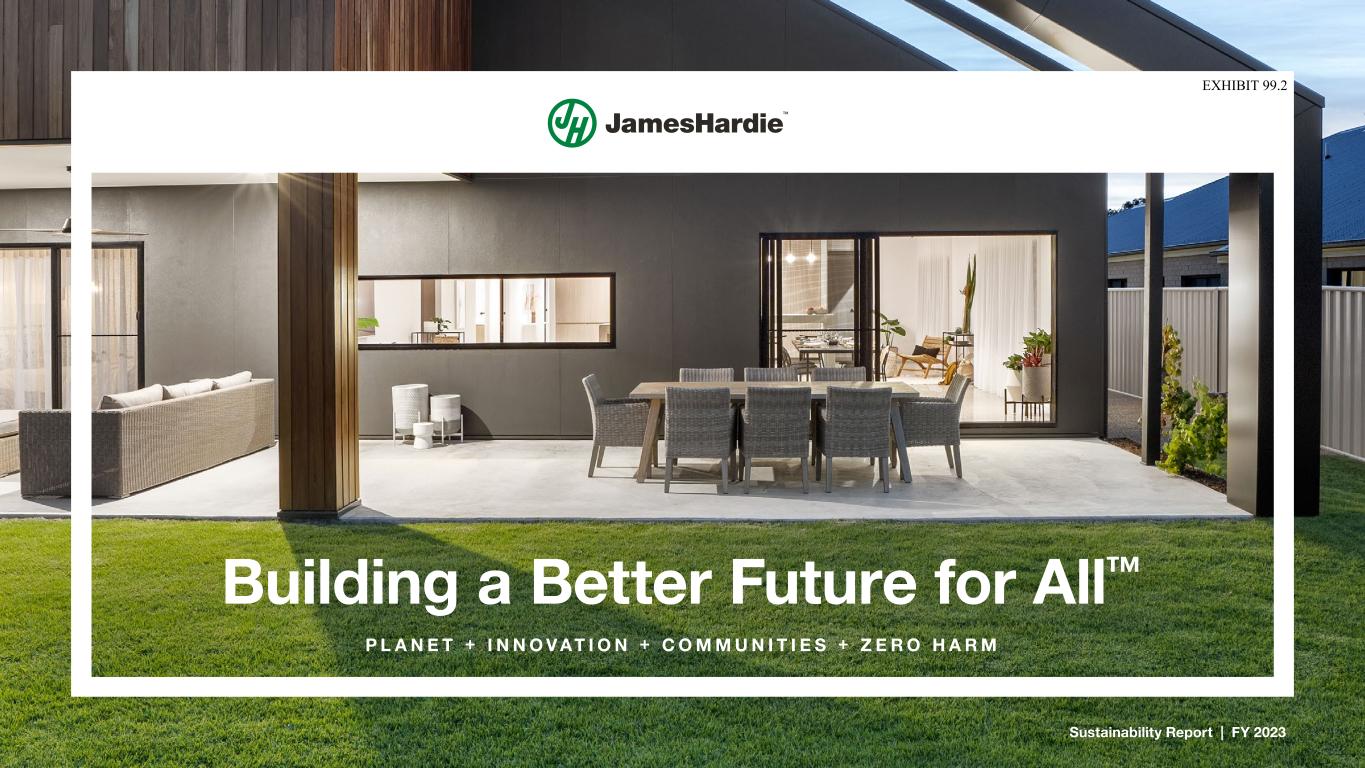
Building a Better Future for All™ Sustainability Report | FY 2023 P L A N E T + I N N O V AT I O N + C O M M U N I T I E S + Z E R O H A R M
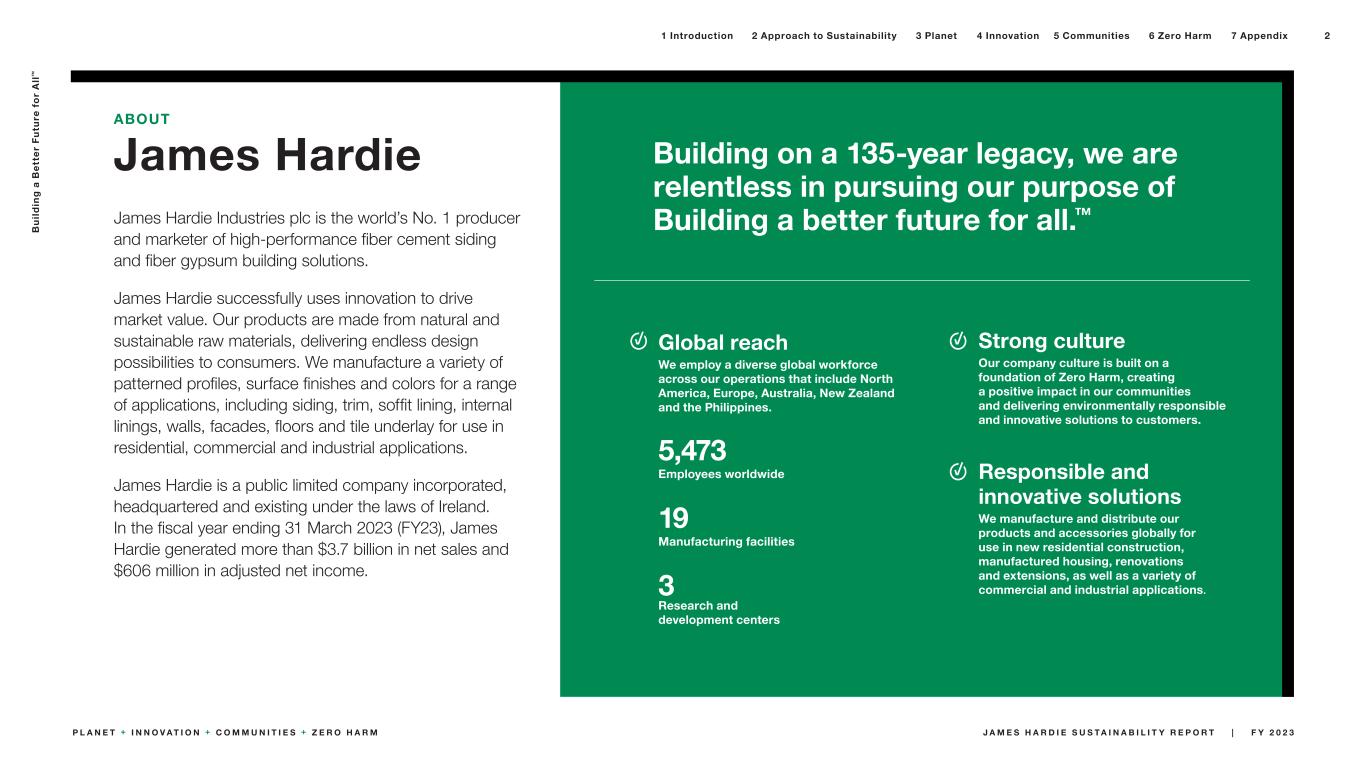
Global reach We employ a diverse global workforce across our operations that include North America, Europe, Australia, New Zealand and the Philippines. Strong culture Our company culture is built on a foundation of Zero Harm, creating a positive impact in our communities and delivering environmentally responsible and innovative solutions to customers. Responsible and innovative solutions We manufacture and distribute our products and accessories globally for use in new residential construction, manufactured housing, renovations and extensions, as well as a variety of commercial and industrial applications. ABOUT James Hardie James Hardie Industries plc is the world’s No. 1 producer and marketer of high-performance fiber cement siding and fiber gypsum building solutions. James Hardie successfully uses innovation to drive market value. Our products are made from natural and sustainable raw materials, delivering endless design possibilities to consumers. We manufacture a variety of patterned profiles, surface finishes and colors for a range of applications, including siding, trim, soffit lining, internal linings, walls, facades, floors and tile underlay for use in residential, commercial and industrial applications. James Hardie is a public limited company incorporated, headquartered and existing under the laws of Ireland. In the fiscal year ending 31 March 2023 (FY23), James Hardie generated more than $3.7 billion in net sales and $606 million in adjusted net income. Building on a 135-year legacy, we are relentless in pursuing our purpose of Building a better future for all.™ 5,473 Employees worldwide 19 Manufacturing facilities 3 Research and development centers 2 Approach to Sustainability 3 Planet 4 Innovation1 Introduction 5 Communities 6 Zero Harm 7 Appendix 2 B u il d in g a B e tt e r F u tu re f o r A ll ™ J A M E S H A R D I E S U S T A I N A B I L I T Y R E P O R T | F Y 2 0 2 3P L A N E T + I N N O V A T I O N + C O M M U N I T I E S + Z E R O H A R M
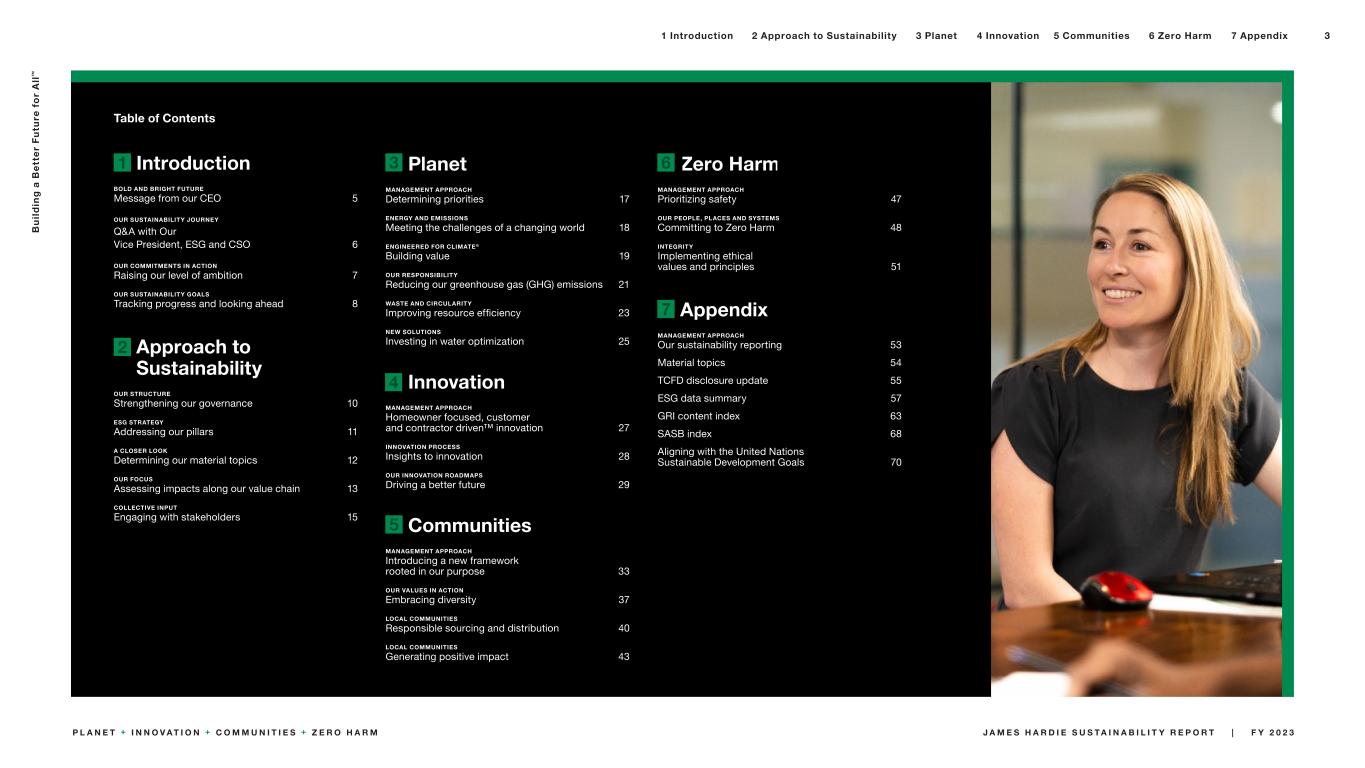
1 4 2 3 6 7 Table of Contents Introduction BOLD AND BRIGHT FUTURE Message from our CEO 5 OUR SUSTAINABILITY JOURNEY Q&A with Our Vice President, ESG and CSO 6 OUR COMMITMENTS IN ACTION Raising our level of ambition 7 OUR SUSTAINABILITY GOALS Tracking progress and looking ahead 8 Approach to Sustainability OUR STRUCTURE Strengthening our governance 10 ESG STRATEGY Addressing our pillars 11 A CLOSER LOOK Determining our material topics 12 OUR FOCUS Assessing impacts along our value chain 13 COLLECTIVE INPUT Engaging with stakeholders 15 Planet MANAGEMENT APPROACH Determining priorities 17 ENERGY AND EMISSIONS Meeting the challenges of a changing world 18 ENGINEERED FOR CLIMATE® Building value 19 OUR RESPONSIBILITY Reducing our greenhouse gas (GHG) emissions 21 WASTE AND CIRCULARITY Improving resource efficiency 23 NEW SOLUTIONS Investing in water optimization 25 Innovation MANAGEMENT APPROACH Homeowner focused, customer and contractor driven™ innovation 27 INNOVATION PROCESS Insights to innovation 28 OUR INNOVATION ROADMAPS Driving a better future 29 Communities MANAGEMENT APPROACH Introducing a new framework rooted in our purpose 33 OUR VALUES IN ACTION Embracing diversity 37 LOCAL COMMUNITIES Responsible sourcing and distribution 40 LOCAL COMMUNITIES Generating positive impact 43 Zero Harm MANAGEMENT APPROACH Prioritizing safety 47 OUR PEOPLE, PLACES AND SYSTEMS Committing to Zero Harm 48 INTEGRITY Implementing ethical values and principles 51 Appendix MANAGEMENT APPROACH Our sustainability reporting 53 Material topics 54 TCFD disclosure update 55 ESG data summary 57 GRI content index 63 SASB index 68 Aligning with the United Nations Sustainable Development Goals 70 5 2 Approach to Sustainability 3 Planet 4 Innovation1 Introduction 5 Communities 6 Zero Harm 7 Appendix 3 B u il d in g a B e tt e r F u tu re f o r A ll ™ J A M E S H A R D I E S U S T A I N A B I L I T Y R E P O R T | F Y 2 0 2 3P L A N E T + I N N O V A T I O N + C O M M U N I T I E S + Z E R O H A R M
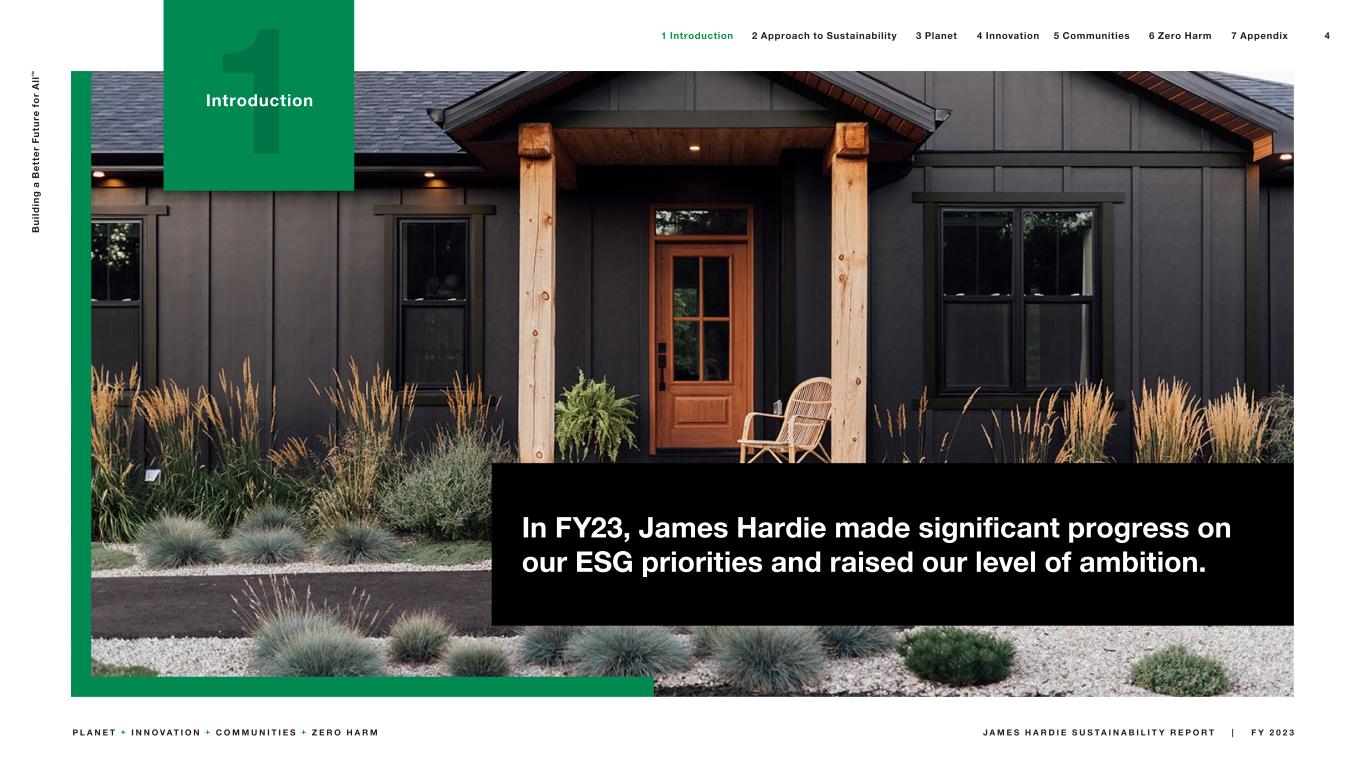
1Introduction In FY23, James Hardie made significant progress on our ESG priorities and raised our level of ambition. 42 Approach to Sustainability 3 Planet 4 Innovation1 Introduction 5 Communities 6 Zero Harm 7 Appendix B u il d in g a B e tt e r F u tu re f o r A ll ™ P L A N E T + I N N O V A T I O N + C O M M U N I T I E S + Z E R O H A R M J A M E S H A R D I E S U S T A I N A B I L I T Y R E P O R T | F Y 2 0 2 3
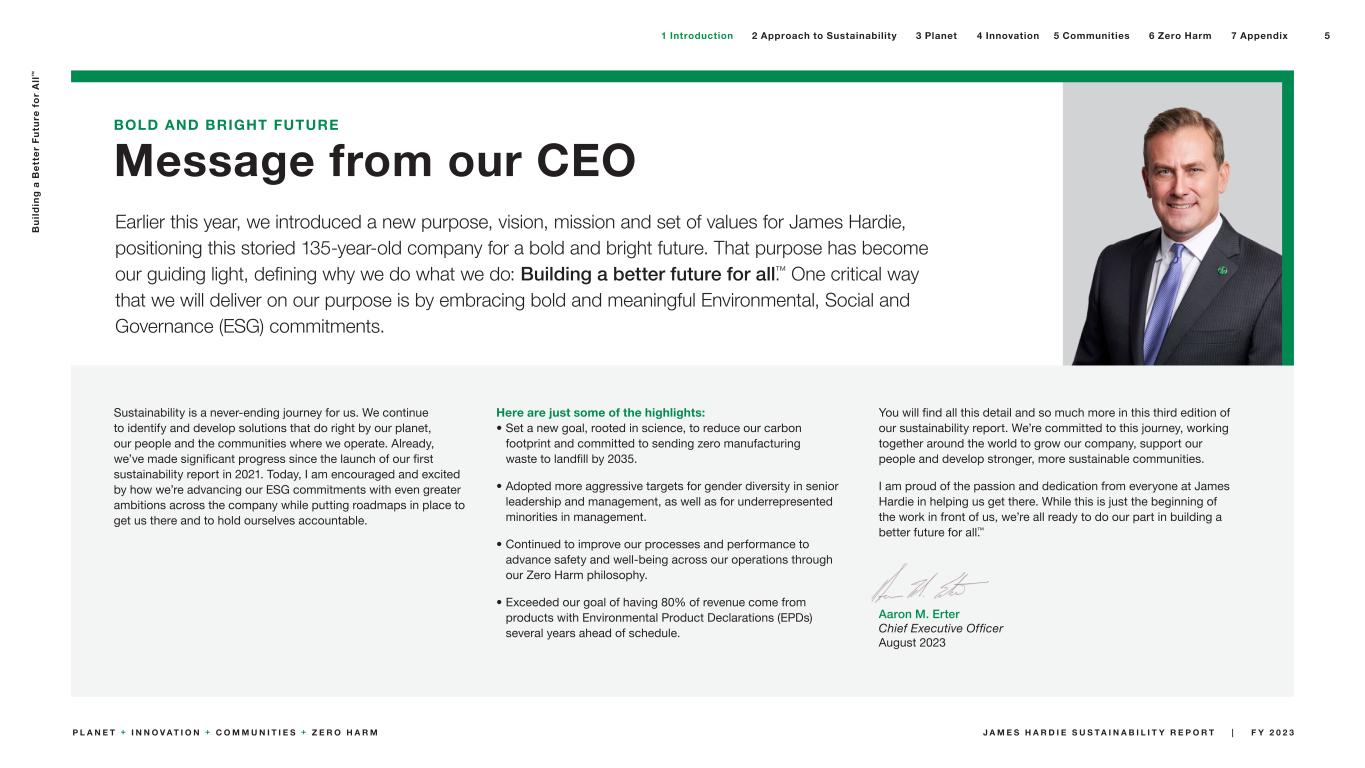
BOLD AND BRIGHT FUTURE Message from our CEO Earlier this year, we introduced a new purpose, vision, mission and set of values for James Hardie, positioning this storied 135-year-old company for a bold and bright future. That purpose has become our guiding light, defining why we do what we do: Building a better future for all.™ One critical way that we will deliver on our purpose is by embracing bold and meaningful Environmental, Social and Governance (ESG) commitments. Sustainability is a never-ending journey for us. We continue to identify and develop solutions that do right by our planet, our people and the communities where we operate. Already, we’ve made significant progress since the launch of our first sustainability report in 2021. Today, I am encouraged and excited by how we’re advancing our ESG commitments with even greater ambitions across the company while putting roadmaps in place to get us there and to hold ourselves accountable. Here are just some of the highlights: • Set a new goal, rooted in science, to reduce our carbon footprint and committed to sending zero manufacturing waste to landfill by 2035. • Adopted more aggressive targets for gender diversity in senior leadership and management, as well as for underrepresented minorities in management. • Continued to improve our processes and performance to advance safety and well-being across our operations through our Zero Harm philosophy. • Exceeded our goal of having 80% of revenue come from products with Environmental Product Declarations (EPDs) several years ahead of schedule. You will find all this detail and so much more in this third edition of our sustainability report. We’re committed to this journey, working together around the world to grow our company, support our people and develop stronger, more sustainable communities. I am proud of the passion and dedication from everyone at James Hardie in helping us get there. While this is just the beginning of the work in front of us, we’re all ready to do our part in building a better future for all.™ Aaron M. Erter Chief Executive Officer August 2023 52 Approach to Sustainability 3 Planet 4 Innovation1 Introduction 5 Communities 6 Zero Harm 7 Appendix B u il d in g a B e tt e r F u tu re f o r A ll ™ P L A N E T + I N N O V A T I O N + C O M M U N I T I E S + Z E R O H A R M J A M E S H A R D I E S U S T A I N A B I L I T Y R E P O R T | F Y 2 0 2 3
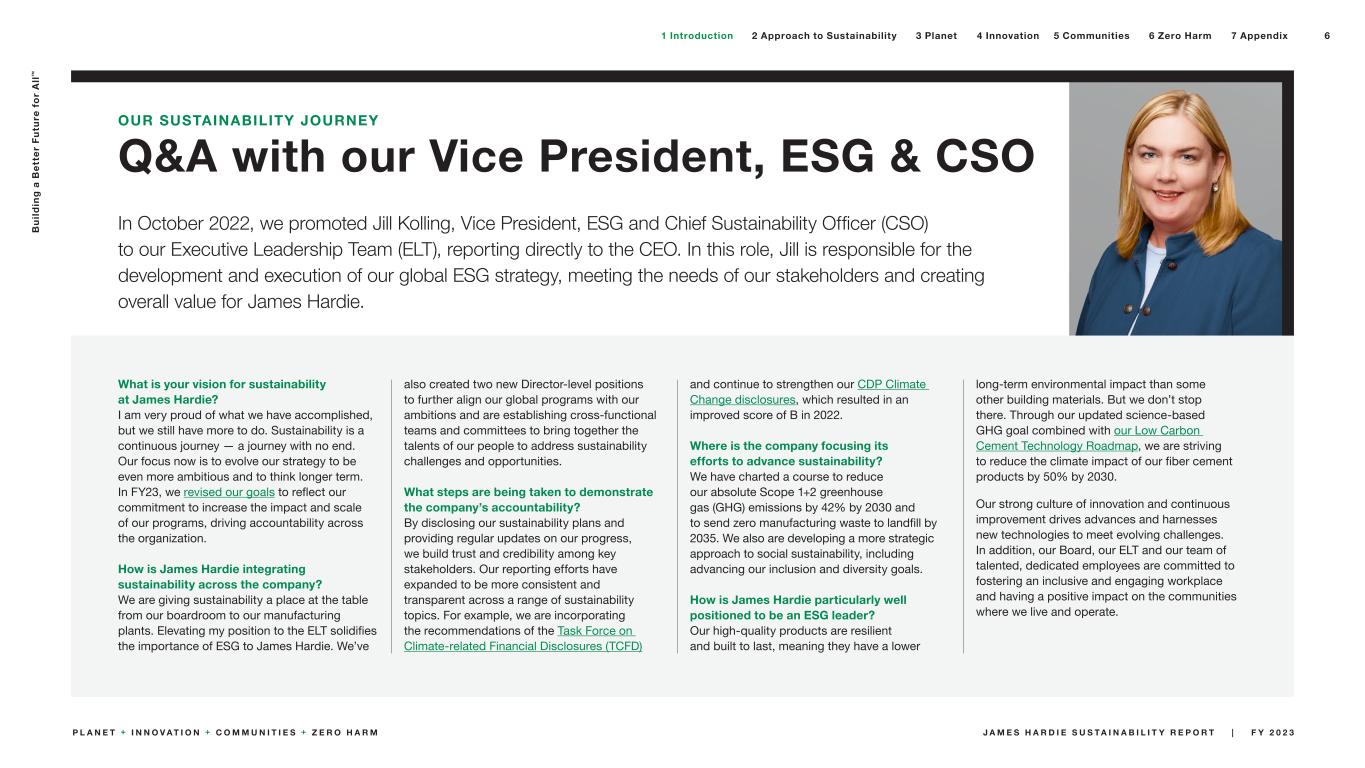
OUR SUSTAINABILITY JOURNEY Q&A with our Vice President, ESG & CSO In October 2022, we promoted Jill Kolling, Vice President, ESG and Chief Sustainability Officer (CSO) to our Executive Leadership Team (ELT), reporting directly to the CEO. In this role, Jill is responsible for the development and execution of our global ESG strategy, meeting the needs of our stakeholders and creating overall value for James Hardie. What is your vision for sustainability at James Hardie? I am very proud of what we have accomplished, but we still have more to do. Sustainability is a continuous journey — a journey with no end. Our focus now is to evolve our strategy to be even more ambitious and to think longer term. In FY23, we revised our goals to reflect our commitment to increase the impact and scale of our programs, driving accountability across the organization. How is James Hardie integrating sustainability across the company? We are giving sustainability a place at the table from our boardroom to our manufacturing plants. Elevating my position to the ELT solidifies the importance of ESG to James Hardie. We’ve also created two new Director-level positions to further align our global programs with our ambitions and are establishing cross-functional teams and committees to bring together the talents of our people to address sustainability challenges and opportunities. What steps are being taken to demonstrate the company’s accountability? By disclosing our sustainability plans and providing regular updates on our progress, we build trust and credibility among key stakeholders. Our reporting efforts have expanded to be more consistent and transparent across a range of sustainability topics. For example, we are incorporating the recommendations of the Task Force on Climate-related Financial Disclosures (TCFD) and continue to strengthen our CDP Climate Change disclosures, which resulted in an improved score of B in 2022. Where is the company focusing its efforts to advance sustainability? We have charted a course to reduce our absolute Scope 1+2 greenhouse gas (GHG) emissions by 42% by 2030 and to send zero manufacturing waste to landfill by 2035. We also are developing a more strategic approach to social sustainability, including advancing our inclusion and diversity goals. How is James Hardie particularly well positioned to be an ESG leader? Our high-quality products are resilient and built to last, meaning they have a lower long-term environmental impact than some other building materials. But we don’t stop there. Through our updated science-based GHG goal combined with our Low Carbon Cement Technology Roadmap, we are striving to reduce the climate impact of our fiber cement products by 50% by 2030. Our strong culture of innovation and continuous improvement drives advances and harnesses new technologies to meet evolving challenges. In addition, our Board, our ELT and our team of talented, dedicated employees are committed to fostering an inclusive and engaging workplace and having a positive impact on the communities where we live and operate. 62 Approach to Sustainability 3 Planet 4 Innovation1 Introduction 5 Communities 6 Zero Harm 7 Appendix B u il d in g a B e tt e r F u tu re f o r A ll ™ P L A N E T + I N N O V A T I O N + C O M M U N I T I E S + Z E R O H A R M J A M E S H A R D I E S U S T A I N A B I L I T Y R E P O R T | F Y 2 0 2 3
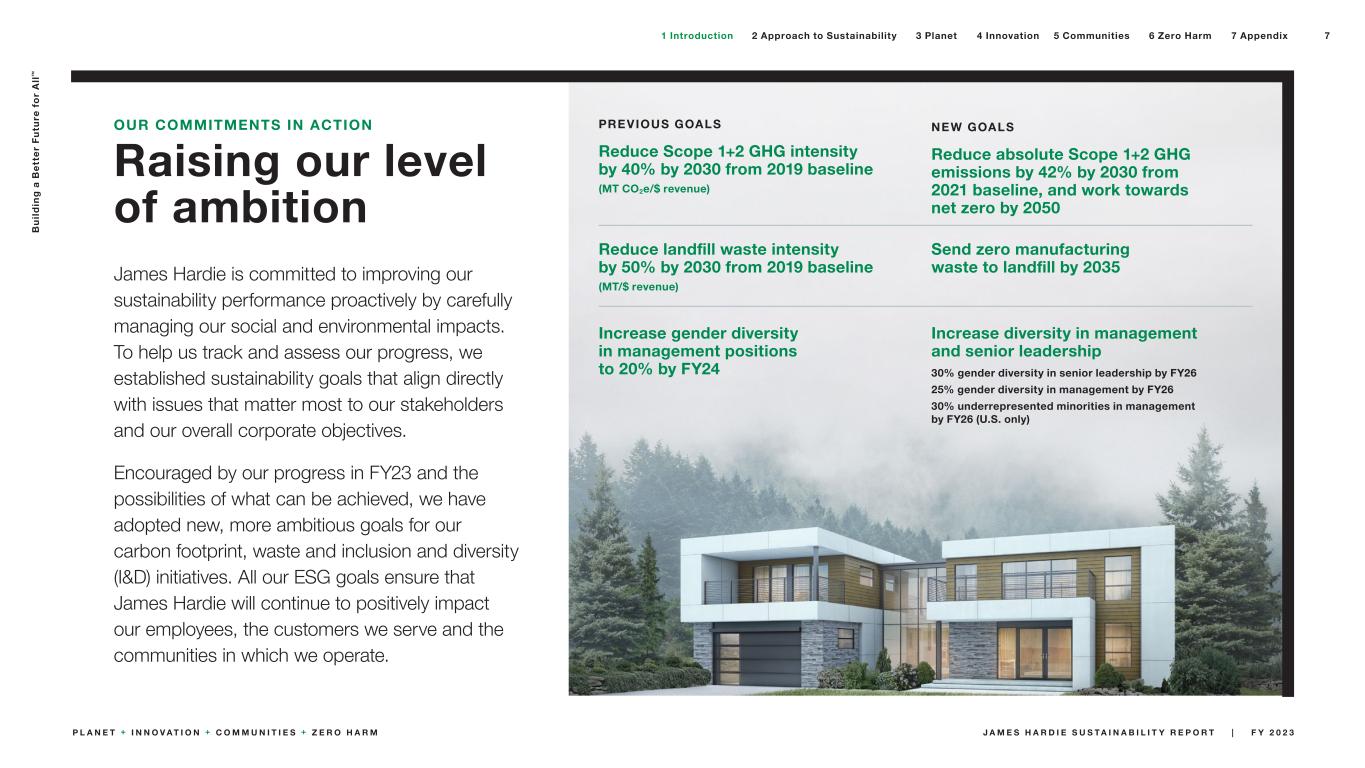
OUR COMMITMENTS IN ACTION Raising our level of ambition James Hardie is committed to improving our sustainability performance proactively by carefully managing our social and environmental impacts. To help us track and assess our progress, we established sustainability goals that align directly with issues that matter most to our stakeholders and our overall corporate objectives. Encouraged by our progress in FY23 and the possibilities of what can be achieved, we have adopted new, more ambitious goals for our carbon footprint, waste and inclusion and diversity (I&D) initiatives. All our ESG goals ensure that James Hardie will continue to positively impact our employees, the customers we serve and the communities in which we operate. PREVIOUS GOALS Reduce Scope 1+2 GHG intensity by 40% by 2030 from 2019 baseline (MT CO2e/$ revenue) Reduce landfill waste intensity by 50% by 2030 from 2019 baseline (MT/$ revenue) Increase gender diversity in management positions to 20% by FY24 NEW GOALS Reduce absolute Scope 1+2 GHG emissions by 42% by 2030 from 2021 baseline, and work towards net zero by 2050 Send zero manufacturing waste to landfill by 2035 Increase diversity in management and senior leadership 30% gender diversity in senior leadership by FY26 25% gender diversity in management by FY26 30% underrepresented minorities in management by FY26 (U.S. only) 72 Approach to Sustainability 3 Planet 4 Innovation1 Introduction 5 Communities 6 Zero Harm 7 Appendix B u il d in g a B e tt e r F u tu re f o r A ll ™ P L A N E T + I N N O V A T I O N + C O M M U N I T I E S + Z E R O H A R M J A M E S H A R D I E S U S T A I N A B I L I T Y R E P O R T | F Y 2 0 2 3
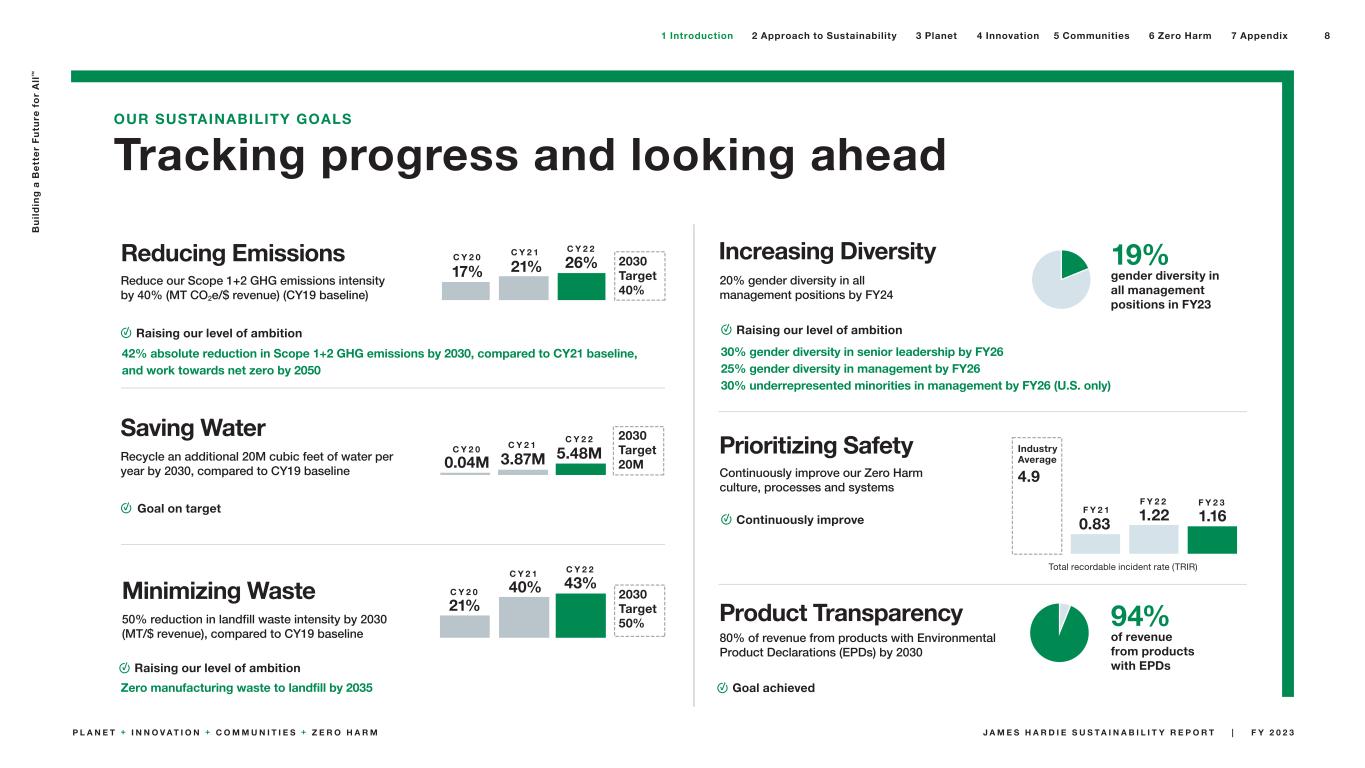
20% gender diversity in all management positions by FY24 80% of revenue from products with Environmental Product Declarations (EPDs) by 2030 Continuously improve our Zero Harm culture, processes and systems 19% gender diversity in all management positions in FY23 94% of revenue from products with EPDs Increasing Diversity Product Transparency Prioritizing Safety 30% gender diversity in senior leadership by FY26 25% gender diversity in management by FY26 30% underrepresented minorities in management by FY26 (U.S. only) Recycle an additional 20M cubic feet of water per year by 2030, compared to CY19 baseline Saving Water 2030 Target 20M C Y 2 0 0.04M C Y 2 1 3.87M C Y 2 2 5.48M Goal on target Reduce our Scope 1+2 GHG emissions intensity by 40% (MT CO2e/$ revenue) (CY19 baseline) Reducing Emissions 17% 21% 26% 2030 Target 40% C Y 2 0 C Y 2 1 C Y 2 2 42% absolute reduction in Scope 1+2 GHG emissions by 2030, compared to CY21 baseline, and work towards net zero by 2050 Raising our level of ambition Raising our level of ambition Continuously improve Goal achieved C Y 2 2 50% reduction in landfill waste intensity by 2030 (MT/$ revenue), compared to CY19 baseline Minimizing Waste 2030 Target 50% 21% 40% 43% C Y 2 0 C Y 2 1 Zero manufacturing waste to landfill by 2035 Raising our level of ambition Industry Average 4.9 F Y 2 2 1.22F Y 2 1 0.83 F Y 2 3 1.16 Total recordable incident rate (TRIR) OUR SUSTAINABILITY GOALS Tracking progress and looking ahead 82 Approach to Sustainability 3 Planet 4 Innovation1 Introduction 5 Communities 6 Zero Harm 7 Appendix B u il d in g a B e tt e r F u tu re f o r A ll ™ P L A N E T + I N N O V A T I O N + C O M M U N I T I E S + Z E R O H A R M J A M E S H A R D I E S U S T A I N A B I L I T Y R E P O R T | F Y 2 0 2 3
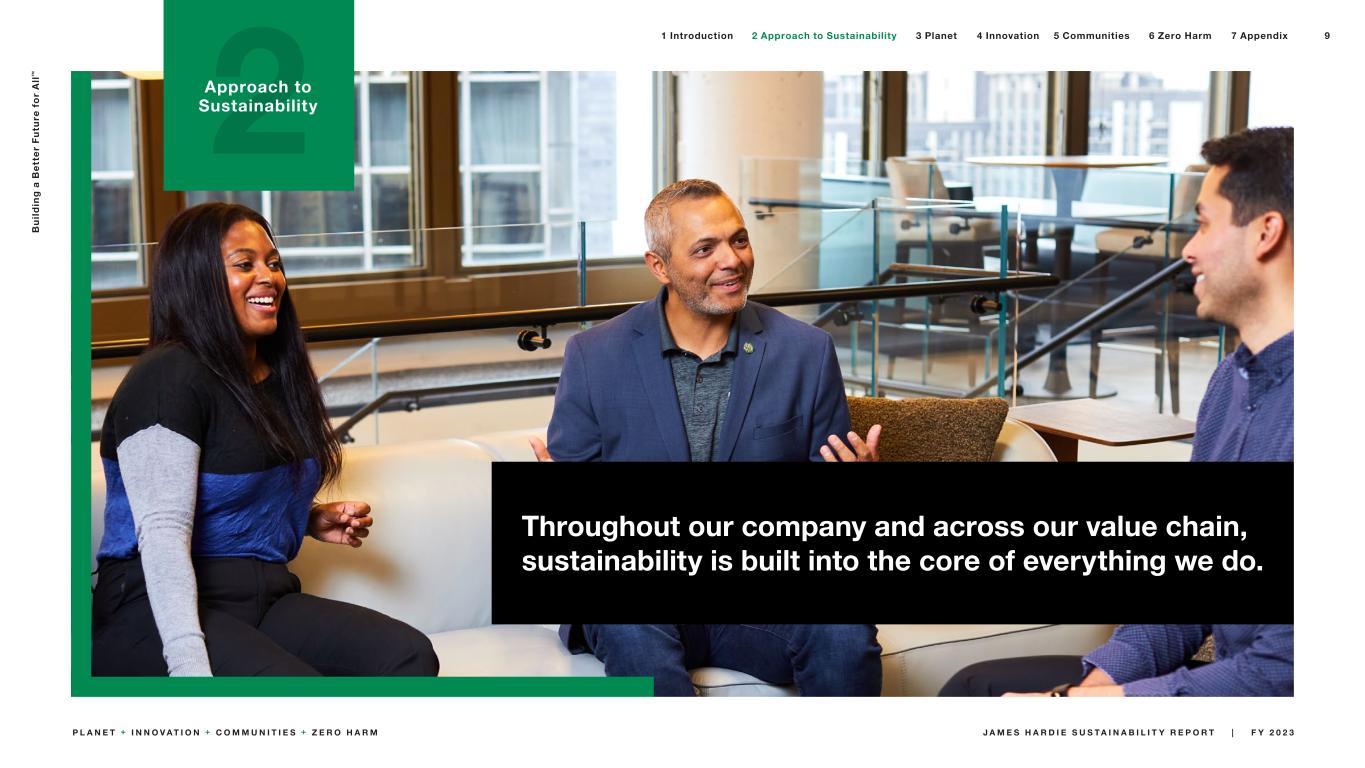
2Approach to Sustainability Throughout our company and across our value chain, sustainability is built into the core of everything we do. 9 B u il d in g a B e tt e r F u tu re f o r A ll ™ J A M E S H A R D I E S U S T A I N A B I L I T Y R E P O R T | F Y 2 0 2 3P L A N E T + I N N O V A T I O N + C O M M U N I T I E S + Z E R O H A R M 2 Approach to Sustainability 3 Planet 4 Innovation1 Introduction 5 Communities 6 Zero Harm 7 Appendix
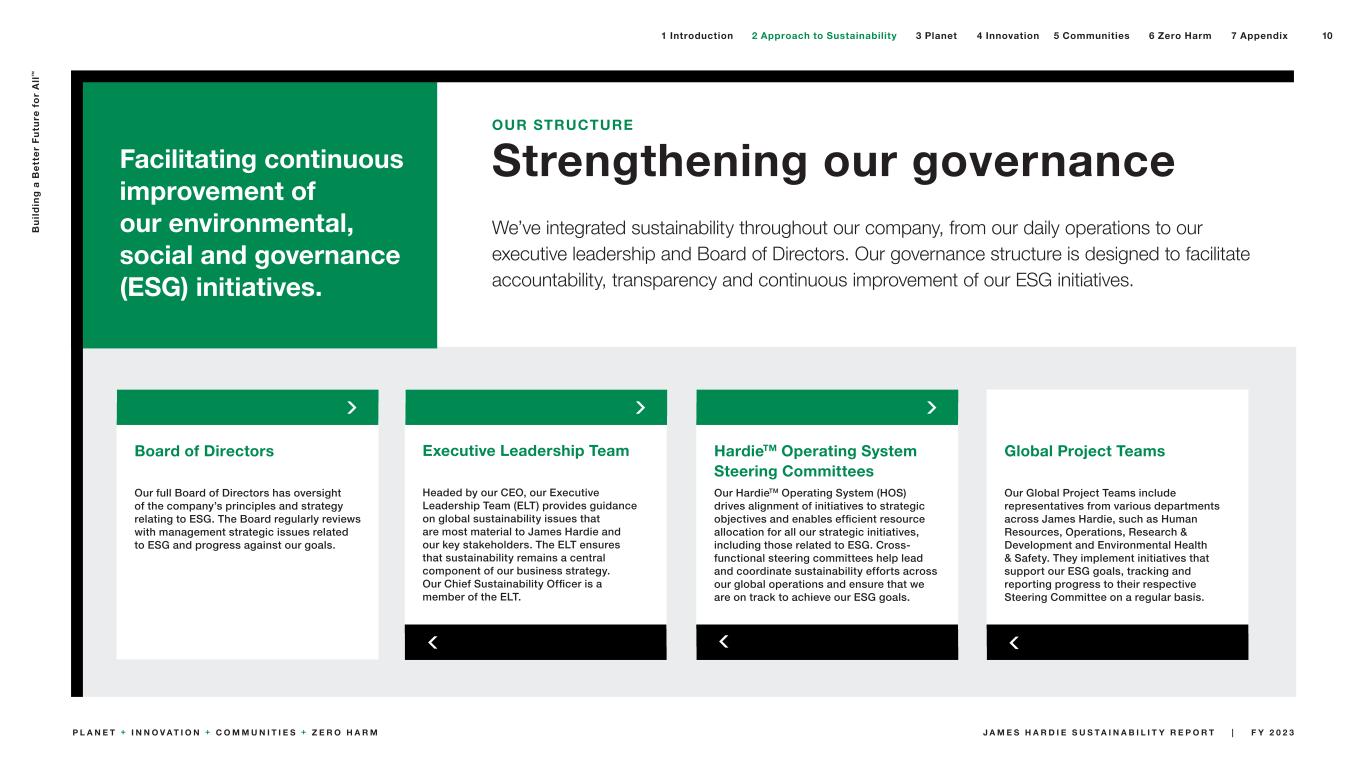
Facilitating continuous improvement of our environmental, social and governance (ESG) initiatives. Board of Directors Our full Board of Directors has oversight of the company’s principles and strategy relating to ESG. The Board regularly reviews with management strategic issues related to ESG and progress against our goals. Executive Leadership Team Headed by our CEO, our Executive Leadership Team (ELT) provides guidance on global sustainability issues that are most material to James Hardie and our key stakeholders. The ELT ensures that sustainability remains a central component of our business strategy. Our Chief Sustainability Officer is a member of the ELT. HardieTM Operating System Steering Committees Our HardieTM Operating System (HOS) drives alignment of initiatives to strategic objectives and enables efficient resource allocation for all our strategic initiatives, including those related to ESG. Cross- functional steering committees help lead and coordinate sustainability efforts across our global operations and ensure that we are on track to achieve our ESG goals. Global Project Teams Our Global Project Teams include representatives from various departments across James Hardie, such as Human Resources, Operations, Research & Development and Environmental Health & Safety. They implement initiatives that support our ESG goals, tracking and reporting progress to their respective Steering Committee on a regular basis. OUR STRUCTURE Strengthening our governance We’ve integrated sustainability throughout our company, from our daily operations to our executive leadership and Board of Directors. Our governance structure is designed to facilitate accountability, transparency and continuous improvement of our ESG initiatives. 10 B u il d in g a B e tt e r F u tu re f o r A ll ™ J A M E S H A R D I E S U S T A I N A B I L I T Y R E P O R T | F Y 2 0 2 3P L A N E T + I N N O V A T I O N + C O M M U N I T I E S + Z E R O H A R M 2 Approach to Sustainability 3 Planet 4 Innovation1 Introduction 5 Communities 6 Zero Harm 7 Appendix
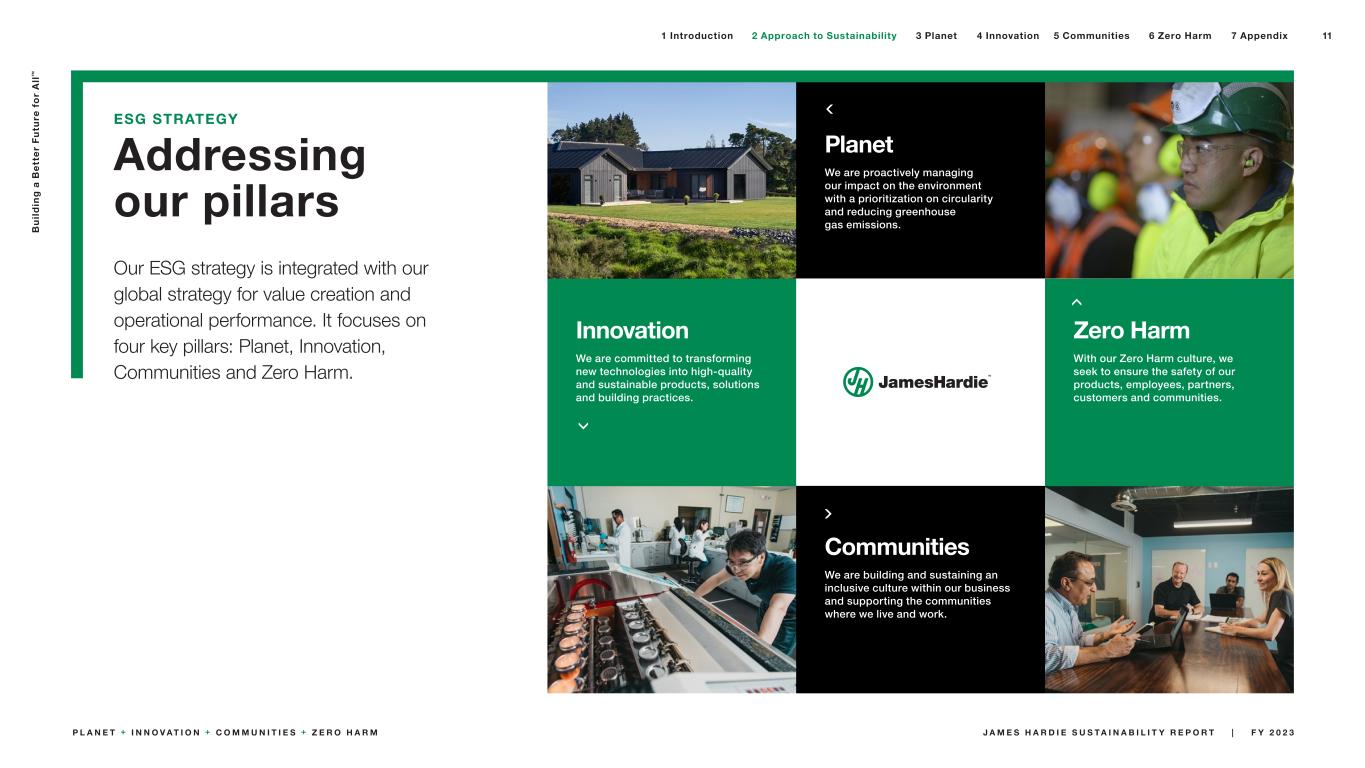
Planet We are proactively managing our impact on the environment with a prioritization on circularity and reducing greenhouse gas emissions. Innovation We are committed to transforming new technologies into high-quality and sustainable products, solutions and building practices. Zero Harm With our Zero Harm culture, we seek to ensure the safety of our products, employees, partners, customers and communities. Communities We are building and sustaining an inclusive culture within our business and supporting the communities where we live and work. ESG STRATEGY Addressing our pillars Our ESG strategy is integrated with our global strategy for value creation and operational performance. It focuses on four key pillars: Planet, Innovation, Communities and Zero Harm. 11 B u il d in g a B e tt e r F u tu re f o r A ll ™ J A M E S H A R D I E S U S T A I N A B I L I T Y R E P O R T | F Y 2 0 2 3P L A N E T + I N N O V A T I O N + C O M M U N I T I E S + Z E R O H A R M 2 Approach to Sustainability 3 Planet 4 Innovation1 Introduction 5 Communities 6 Zero Harm 7 Appendix
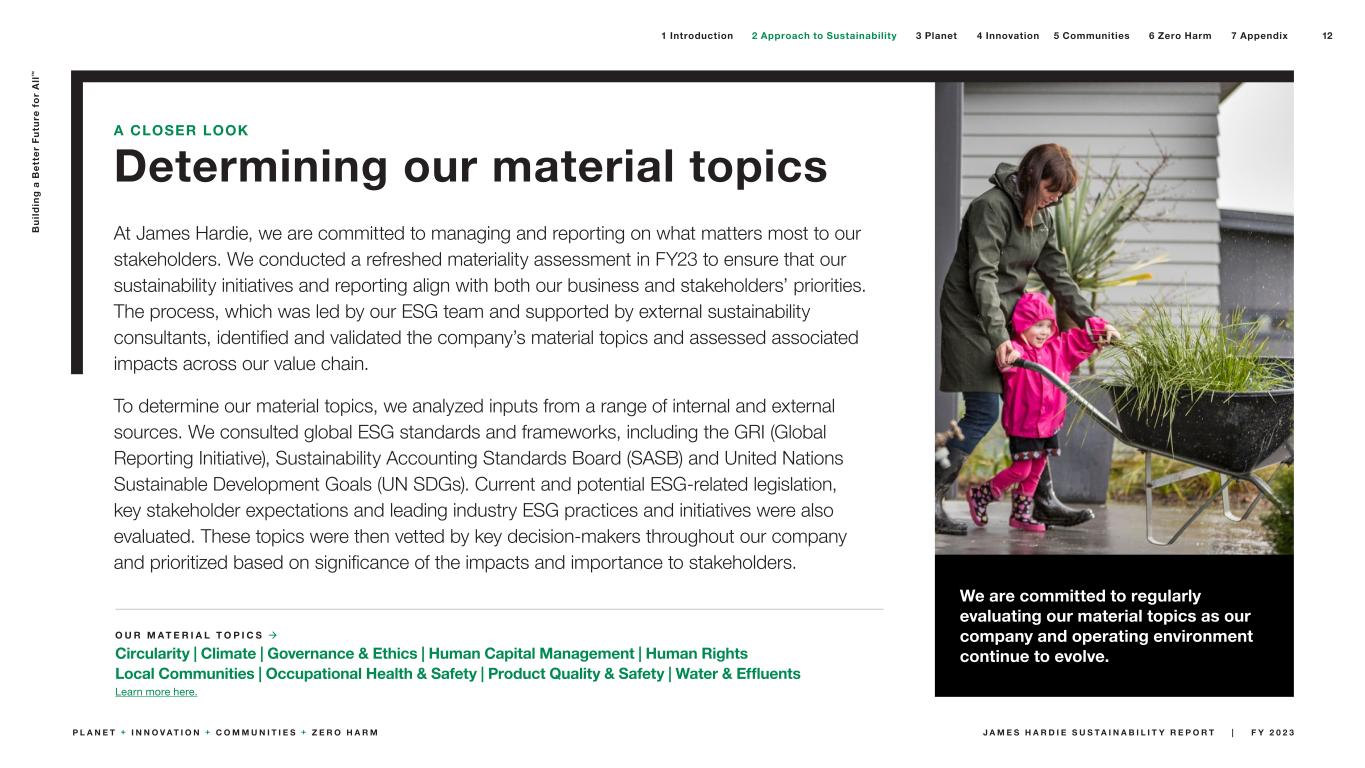
A CLOSER LOOK Determining our material topics At James Hardie, we are committed to managing and reporting on what matters most to our stakeholders. We conducted a refreshed materiality assessment in FY23 to ensure that our sustainability initiatives and reporting align with both our business and stakeholders’ priorities. The process, which was led by our ESG team and supported by external sustainability consultants, identified and validated the company’s material topics and assessed associated impacts across our value chain. To determine our material topics, we analyzed inputs from a range of internal and external sources. We consulted global ESG standards and frameworks, including the GRI (Global Reporting Initiative), Sustainability Accounting Standards Board (SASB) and United Nations Sustainable Development Goals (UN SDGs). Current and potential ESG-related legislation, key stakeholder expectations and leading industry ESG practices and initiatives were also evaluated. These topics were then vetted by key decision-makers throughout our company and prioritized based on significance of the impacts and importance to stakeholders. We are committed to regularly evaluating our material topics as our company and operating environment continue to evolve. O U R M A T E R I A L T O P I C S Circularity | Climate | Governance & Ethics | Human Capital Management | Human Rights Local Communities | Occupational Health & Safety | Product Quality & Safety | Water & Effluents Learn more here. 12 B u il d in g a B e tt e r F u tu re f o r A ll ™ J A M E S H A R D I E S U S T A I N A B I L I T Y R E P O R T | F Y 2 0 2 3P L A N E T + I N N O V A T I O N + C O M M U N I T I E S + Z E R O H A R M 2 Approach to Sustainability 3 Planet 4 Innovation1 Introduction 5 Communities 6 Zero Harm 7 Appendix
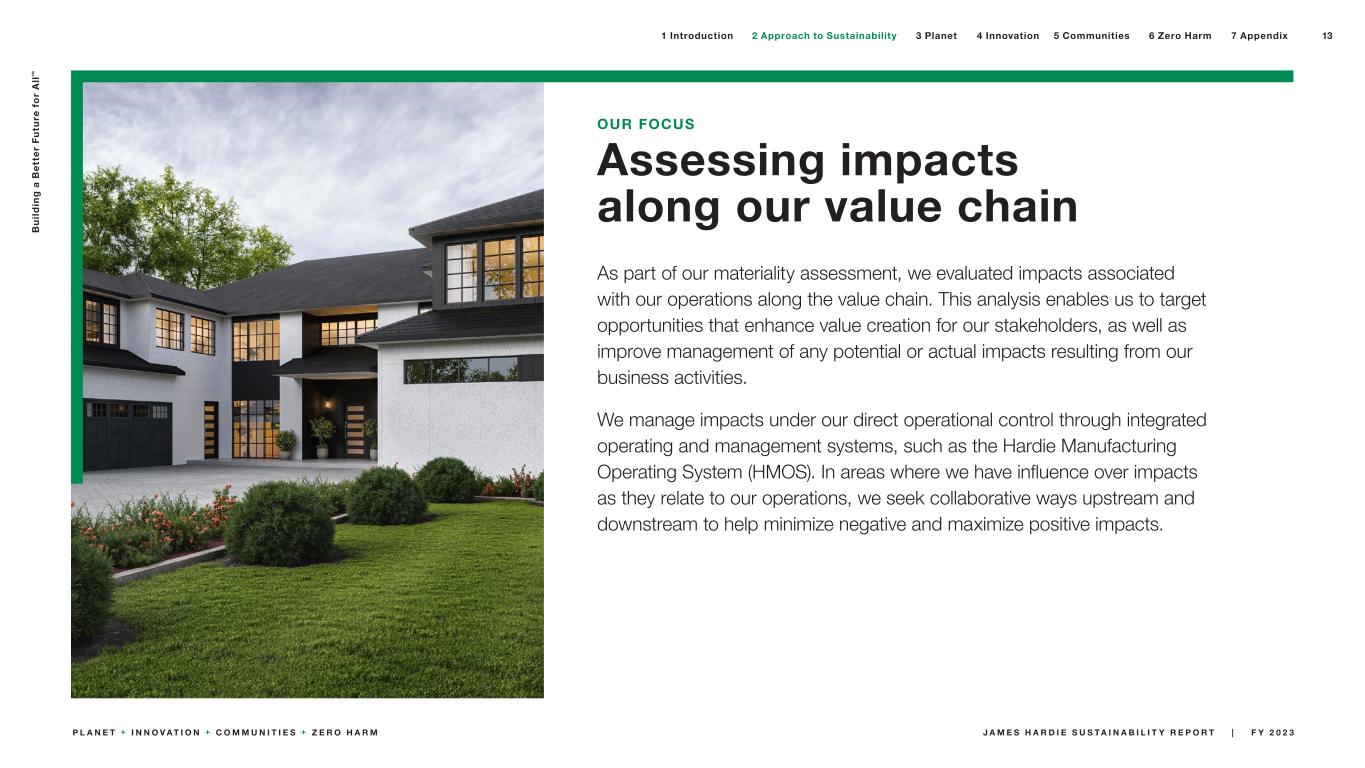
OUR FOCUS Assessing impacts along our value chain As part of our materiality assessment, we evaluated impacts associated with our operations along the value chain. This analysis enables us to target opportunities that enhance value creation for our stakeholders, as well as improve management of any potential or actual impacts resulting from our business activities. We manage impacts under our direct operational control through integrated operating and management systems, such as the Hardie Manufacturing Operating System (HMOS). In areas where we have influence over impacts as they relate to our operations, we seek collaborative ways upstream and downstream to help minimize negative and maximize positive impacts. 13 B u il d in g a B e tt e r F u tu re f o r A ll ™ J A M E S H A R D I E S U S T A I N A B I L I T Y R E P O R T | F Y 2 0 2 3P L A N E T + I N N O V A T I O N + C O M M U N I T I E S + Z E R O H A R M 2 Approach to Sustainability 3 Planet 4 Innovation1 Introduction 5 Communities 6 Zero Harm 7 Appendix
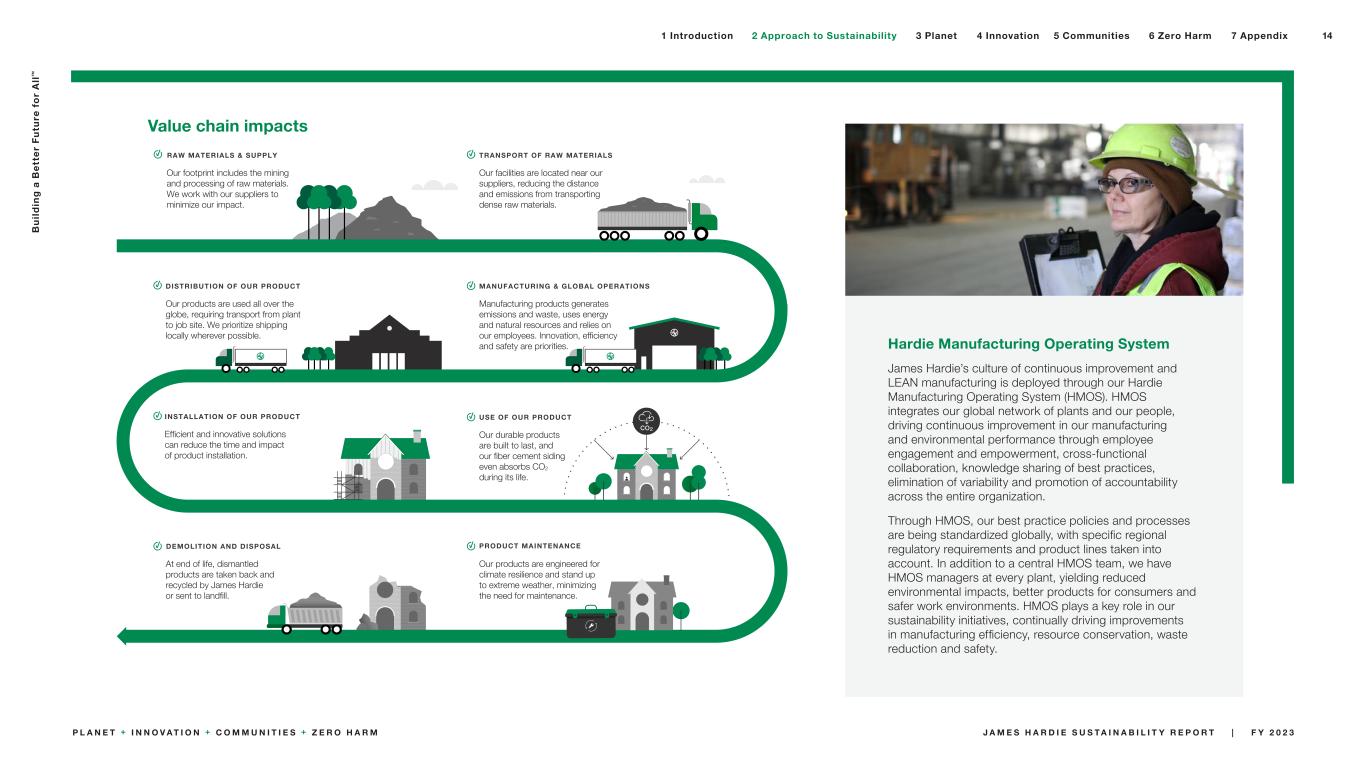
Hardie Manufacturing Operating System James Hardie’s culture of continuous improvement and LEAN manufacturing is deployed through our Hardie Manufacturing Operating System (HMOS). HMOS integrates our global network of plants and our people, driving continuous improvement in our manufacturing and environmental performance through employee engagement and empowerment, cross-functional collaboration, knowledge sharing of best practices, elimination of variability and promotion of accountability across the entire organization. Through HMOS, our best practice policies and processes are being standardized globally, with specific regional regulatory requirements and product lines taken into account. In addition to a central HMOS team, we have HMOS managers at every plant, yielding reduced environmental impacts, better products for consumers and safer work environments. HMOS plays a key role in our sustainability initiatives, continually driving improvements in manufacturing efficiency, resource conservation, waste reduction and safety. RAW MATERIALS & SUPPLY Our footprint includes the mining and processing of raw materials. We work with our suppliers to minimize our impact. TRANSPORT OF RAW MATERIALS Our facilities are located near our suppliers, reducing the distance and emissions from transporting dense raw materials. MANUFACTURING & GLOBAL OPERATIONS Manufacturing products generates emissions and waste, uses energy and natural resources and relies on our employees. Innovation, efficiency and safety are priorities. DISTRIBUTION OF OUR PRODUCT Our products are used all over the globe, requiring transport from plant to job site. We prioritize shipping locally wherever possible. INSTALLATION OF OUR PRODUCT Efficient and innovative solutions can reduce the time and impact of product installation. CO2 Our products are engineered for climate resilience and stand up to extreme weather, minimizing the need for maintenance. USE OF OUR PRODUCT Our durable products are built to last, and our fiber cement siding even absorbs CO2 during its life. PRODUCT MAINTENANCEDEMOLITION AND DISPOSAL At end of life, dismantled products are taken back and recycled by James Hardie or sent to landfill. Value chain impacts 14 B u il d in g a B e tt e r F u tu re f o r A ll ™ J A M E S H A R D I E S U S T A I N A B I L I T Y R E P O R T | F Y 2 0 2 3P L A N E T + I N N O V A T I O N + C O M M U N I T I E S + Z E R O H A R M 2 Approach to Sustainability 3 Planet 4 Innovation1 Introduction 5 Communities 6 Zero Harm 7 Appendix
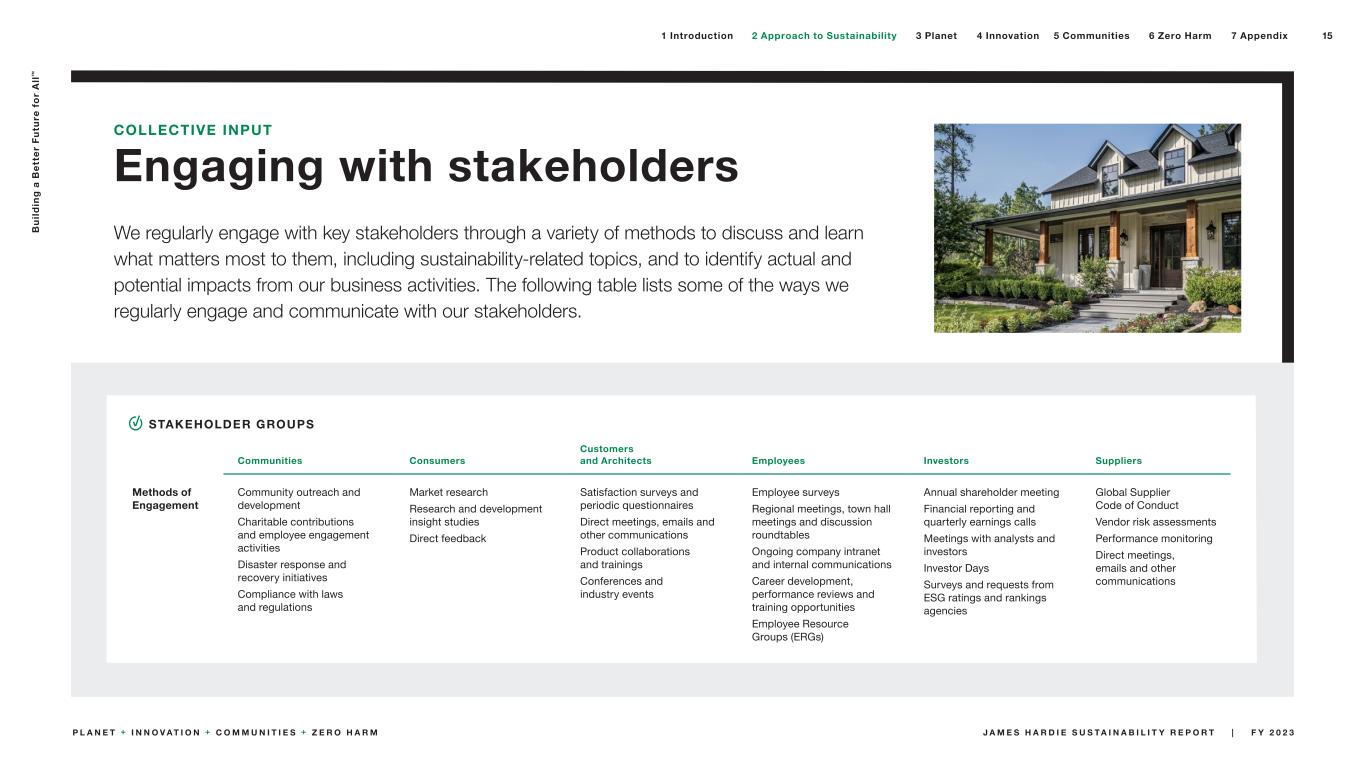
COLLECTIVE INPUT Engaging with stakeholders We regularly engage with key stakeholders through a variety of methods to discuss and learn what matters most to them, including sustainability-related topics, and to identify actual and potential impacts from our business activities. The following table lists some of the ways we regularly engage and communicate with our stakeholders. STAKEHOLDER GROUPS Communities Consumers Customers and Architects Employees Investors Suppliers Methods of Engagement Community outreach and development Charitable contributions and employee engagement activities Disaster response and recovery initiatives Compliance with laws and regulations Market research Research and development insight studies Direct feedback Satisfaction surveys and periodic questionnaires Direct meetings, emails and other communications Product collaborations and trainings Conferences and industry events Employee surveys Regional meetings, town hall meetings and discussion roundtables Ongoing company intranet and internal communications Career development, performance reviews and training opportunities Employee Resource Groups (ERGs) Annual shareholder meeting Financial reporting and quarterly earnings calls Meetings with analysts and investors Investor Days Surveys and requests from ESG ratings and rankings agencies Global Supplier Code of Conduct Vendor risk assessments Performance monitoring Direct meetings, emails and other communications 15 B u il d in g a B e tt e r F u tu re f o r A ll ™ J A M E S H A R D I E S U S T A I N A B I L I T Y R E P O R T | F Y 2 0 2 3P L A N E T + I N N O V A T I O N + C O M M U N I T I E S + Z E R O H A R M 2 Approach to Sustainability 3 Planet 4 Innovation1 Introduction 5 Communities 6 Zero Harm 7 Appendix
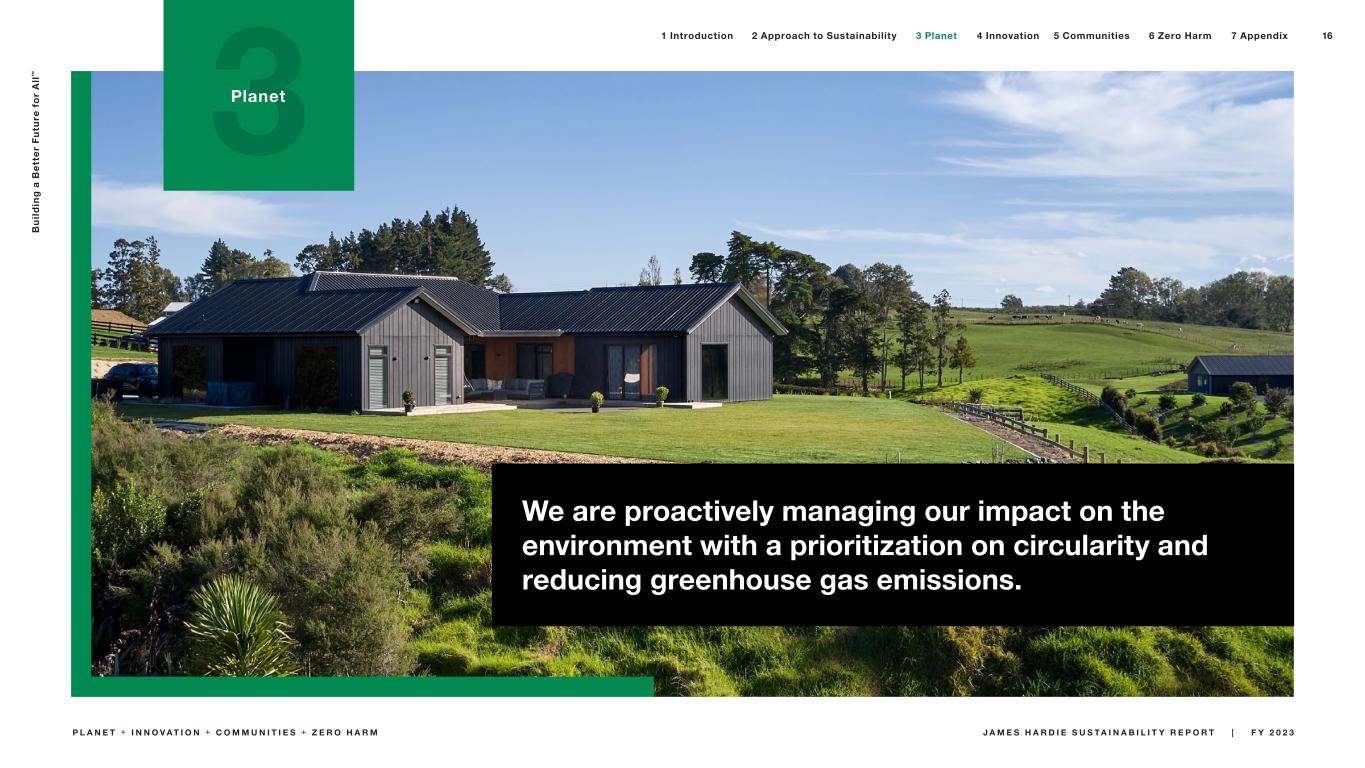
3Planet We are proactively managing our impact on the environment with a prioritization on circularity and reducing greenhouse gas emissions. 16 B u il d in g a B e tt e r F u tu re f o r A ll ™ J A M E S H A R D I E S U S T A I N A B I L I T Y R E P O R T | F Y 2 0 2 3P L A N E T + I N N O V A T I O N + C O M M U N I T I E S + Z E R O H A R M 2 Approach to Sustainability 3 Planet 4 Innovation1 Introduction 5 Communities 6 Zero Harm 7 Appendix
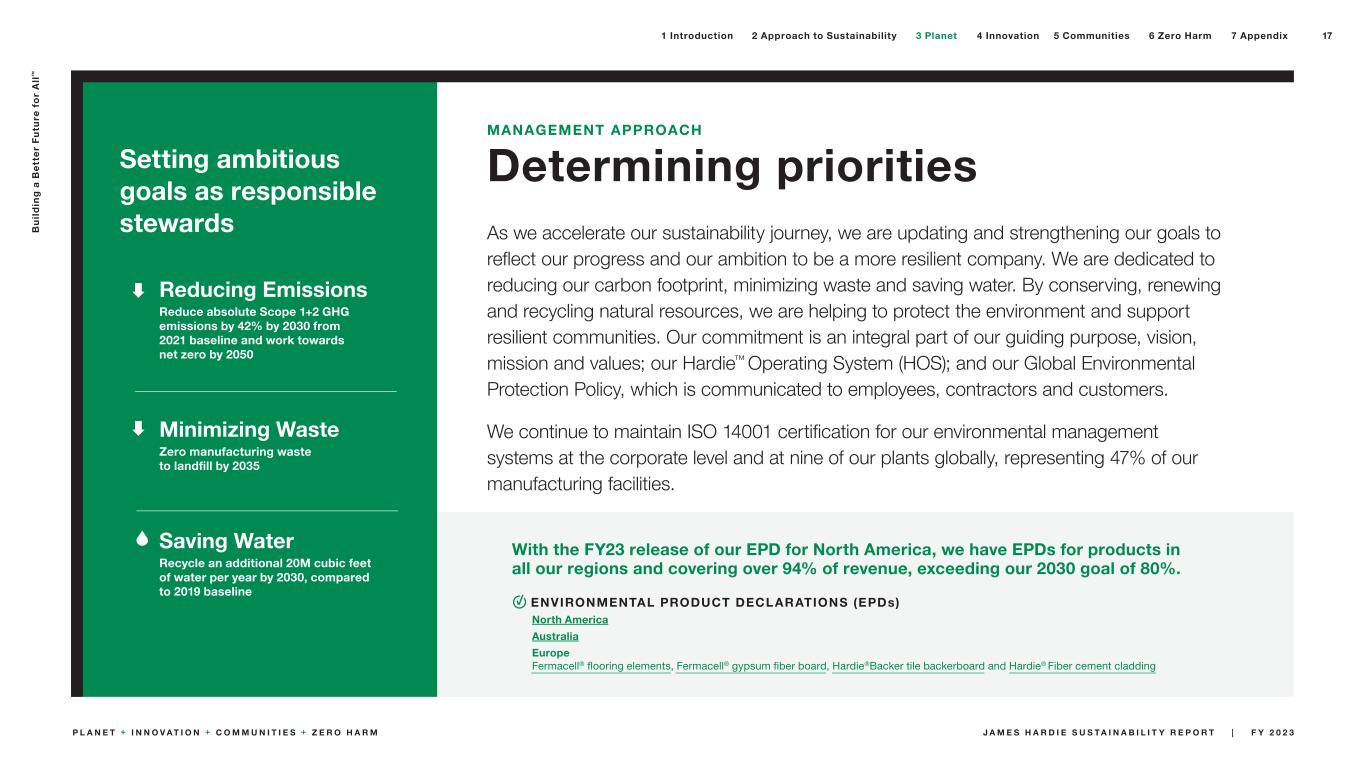
MANAGEMENT APPROACH Determining priorities As we accelerate our sustainability journey, we are updating and strengthening our goals to reflect our progress and our ambition to be a more resilient company. We are dedicated to reducing our carbon footprint, minimizing waste and saving water. By conserving, renewing and recycling natural resources, we are helping to protect the environment and support resilient communities. Our commitment is an integral part of our guiding purpose, vision, mission and values; our Hardie™ Operating System (HOS); and our Global Environmental Protection Policy, which is communicated to employees, contractors and customers. We continue to maintain ISO 14001 certification for our environmental management systems at the corporate level and at nine of our plants globally, representing 47% of our manufacturing facilities. Setting ambitious goals as responsible stewards Reducing Emissions Reduce absolute Scope 1+2 GHG emissions by 42% by 2030 from 2021 baseline and work towards net zero by 2050 Minimizing Waste Zero manufacturing waste to landfill by 2035 Saving Water Recycle an additional 20M cubic feet of water per year by 2030, compared to 2019 baseline With the FY23 release of our EPD for North America, we have EPDs for products in all our regions and covering over 94% of revenue, exceeding our 2030 goal of 80%. ENVIRONMENTAL PRODUCT DECLARATIONS (EPDs) North America Australia Europe Fermacell® flooring elements, Fermacell® gypsum fiber board, Hardie®Backer tile backerboard and Hardie® Fiber cement cladding 17 B u il d in g a B e tt e r F u tu re f o r A ll ™ J A M E S H A R D I E S U S T A I N A B I L I T Y R E P O R T | F Y 2 0 2 3P L A N E T + I N N O V A T I O N + C O M M U N I T I E S + Z E R O H A R M 2 Approach to Sustainability 3 Planet 4 Innovation1 Introduction 5 Communities 6 Zero Harm 7 Appendix
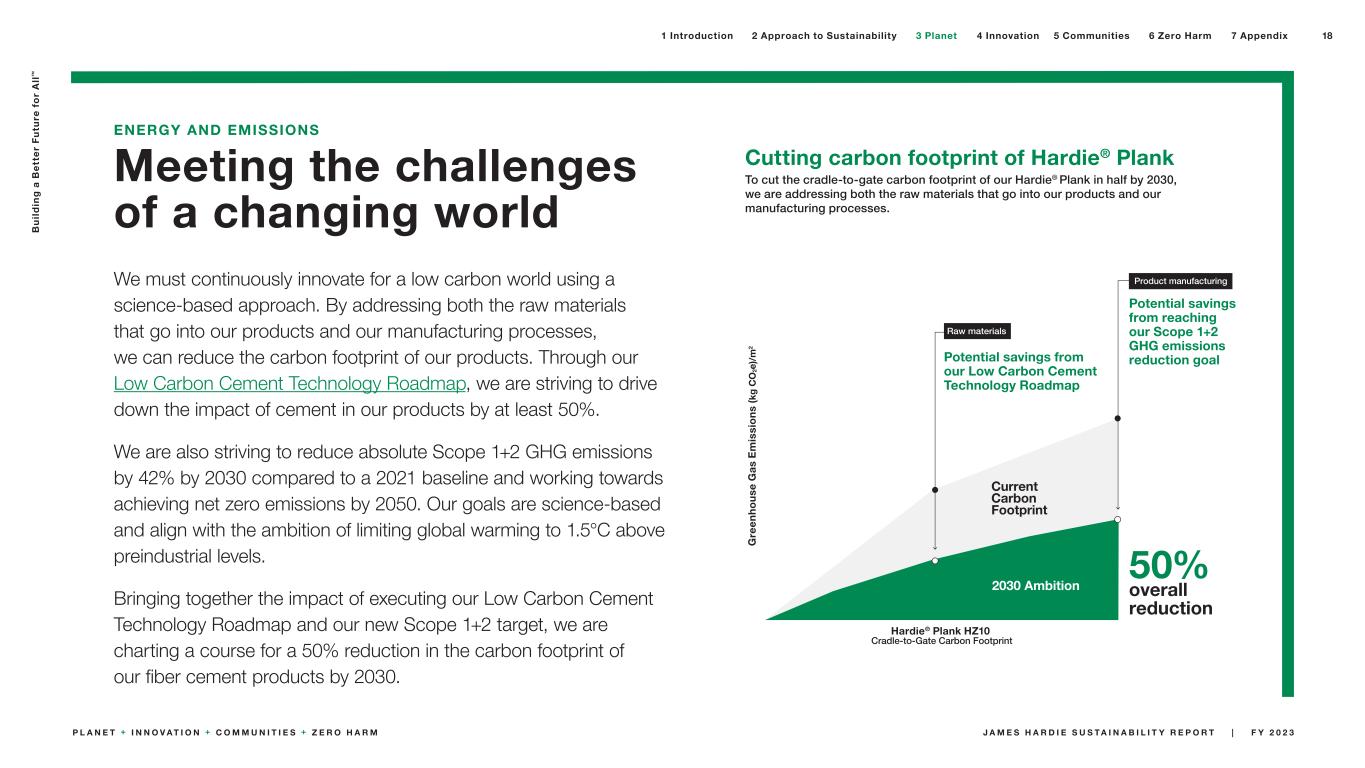
2030 Ambition Current Carbon Footprint G re e n h o u se G as E m is si o n s (k g C O 2e )/ m 2 Potential savings from reaching our Scope 1+2 GHG emissions reduction goal Product manufacturing Potential savings from our Low Carbon Cement Technology Roadmap Raw materials 50% overall reduction Hardie® Plank HZ10 Cradle-to-Gate Carbon Footprint ENERGY AND EMISSIONS Meeting the challenges of a changing world We must continuously innovate for a low carbon world using a science-based approach. By addressing both the raw materials that go into our products and our manufacturing processes, we can reduce the carbon footprint of our products. Through our Low Carbon Cement Technology Roadmap, we are striving to drive down the impact of cement in our products by at least 50%. We are also striving to reduce absolute Scope 1+2 GHG emissions by 42% by 2030 compared to a 2021 baseline and working towards achieving net zero emissions by 2050. Our goals are science-based and align with the ambition of limiting global warming to 1.5°C above preindustrial levels. Bringing together the impact of executing our Low Carbon Cement Technology Roadmap and our new Scope 1+2 target, we are charting a course for a 50% reduction in the carbon footprint of our fiber cement products by 2030. Cutting carbon footprint of Hardie® Plank To cut the cradle-to-gate carbon footprint of our Hardie® Plank in half by 2030, we are addressing both the raw materials that go into our products and our manufacturing processes. 18 B u il d in g a B e tt e r F u tu re f o r A ll ™ J A M E S H A R D I E S U S T A I N A B I L I T Y R E P O R T | F Y 2 0 2 3P L A N E T + I N N O V A T I O N + C O M M U N I T I E S + Z E R O H A R M 2 Approach to Sustainability 3 Planet 4 Innovation1 Introduction 5 Communities 6 Zero Harm 7 Appendix
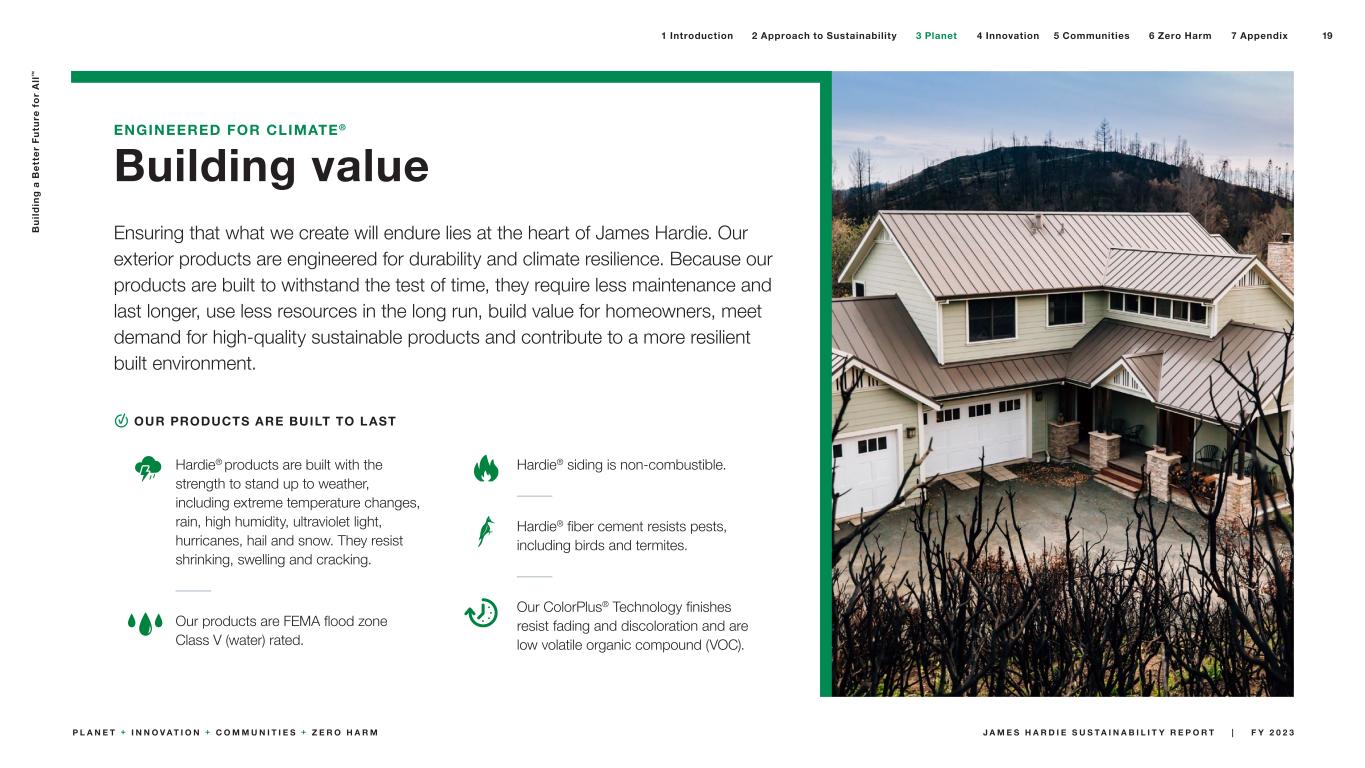
Hardie® products are built with the strength to stand up to weather, including extreme temperature changes, rain, high humidity, ultraviolet light, hurricanes, hail and snow. They resist shrinking, swelling and cracking. Our products are FEMA flood zone Class V (water) rated. Hardie® siding is non-combustible. Hardie® fiber cement resists pests, including birds and termites. Our ColorPlus® Technology finishes resist fading and discoloration and are low volatile organic compound (VOC). ENGINEERED FOR CLIMATE® Building value Ensuring that what we create will endure lies at the heart of James Hardie. Our exterior products are engineered for durability and climate resilience. Because our products are built to withstand the test of time, they require less maintenance and last longer, use less resources in the long run, build value for homeowners, meet demand for high-quality sustainable products and contribute to a more resilient built environment. OUR PRODUCTS ARE BUILT TO LAST 19 B u il d in g a B e tt e r F u tu re f o r A ll ™ J A M E S H A R D I E S U S T A I N A B I L I T Y R E P O R T | F Y 2 0 2 3P L A N E T + I N N O V A T I O N + C O M M U N I T I E S + Z E R O H A R M 2 Approach to Sustainability 3 Planet 4 Innovation1 Introduction 5 Communities 6 Zero Harm 7 Appendix
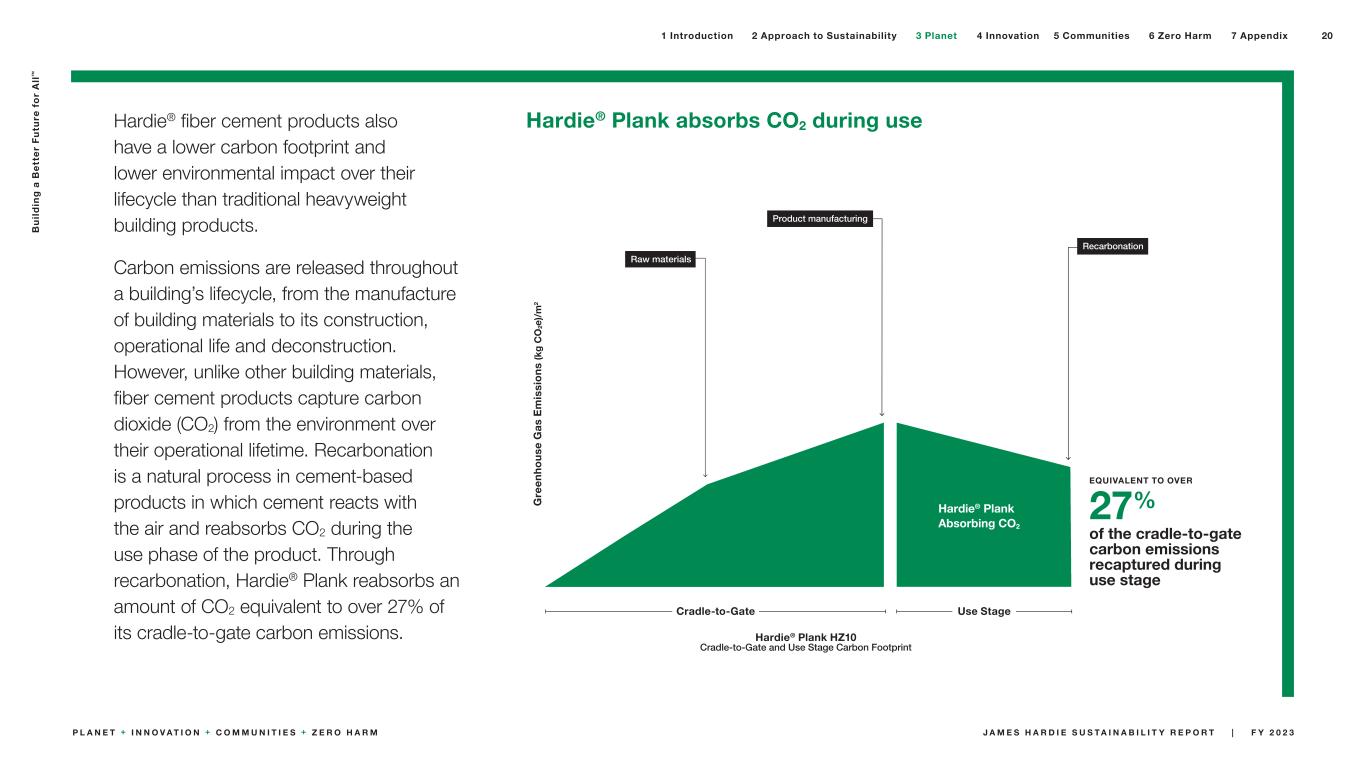
Hardie® Plank HZ10 Cradle-to-Gate and Use Stage Carbon Footprint 27%G re e n h o u se G as E m is si o n s (k g C O 2e )/ m 2 Use Stage Product manufacturing Recarbonation Raw materials Cradle-to-Gate of the cradle-to-gate carbon emissions recaptured during use stage EQUIVALENT TO OVER Hardie® Plank Absorbing CO2 Hardie® fiber cement products also have a lower carbon footprint and lower environmental impact over their lifecycle than traditional heavyweight building products. Carbon emissions are released throughout a building’s lifecycle, from the manufacture of building materials to its construction, operational life and deconstruction. However, unlike other building materials, fiber cement products capture carbon dioxide (CO2) from the environment over their operational lifetime. Recarbonation is a natural process in cement-based products in which cement reacts with the air and reabsorbs CO2 during the use phase of the product. Through recarbonation, Hardie® Plank reabsorbs an amount of CO2 equivalent to over 27% of its cradle-to-gate carbon emissions. Hardie® Plank absorbs CO2 during use 20 B u il d in g a B e tt e r F u tu re f o r A ll ™ J A M E S H A R D I E S U S T A I N A B I L I T Y R E P O R T | F Y 2 0 2 3P L A N E T + I N N O V A T I O N + C O M M U N I T I E S + Z E R O H A R M 2 Approach to Sustainability 3 Planet 4 Innovation1 Introduction 5 Communities 6 Zero Harm 7 Appendix
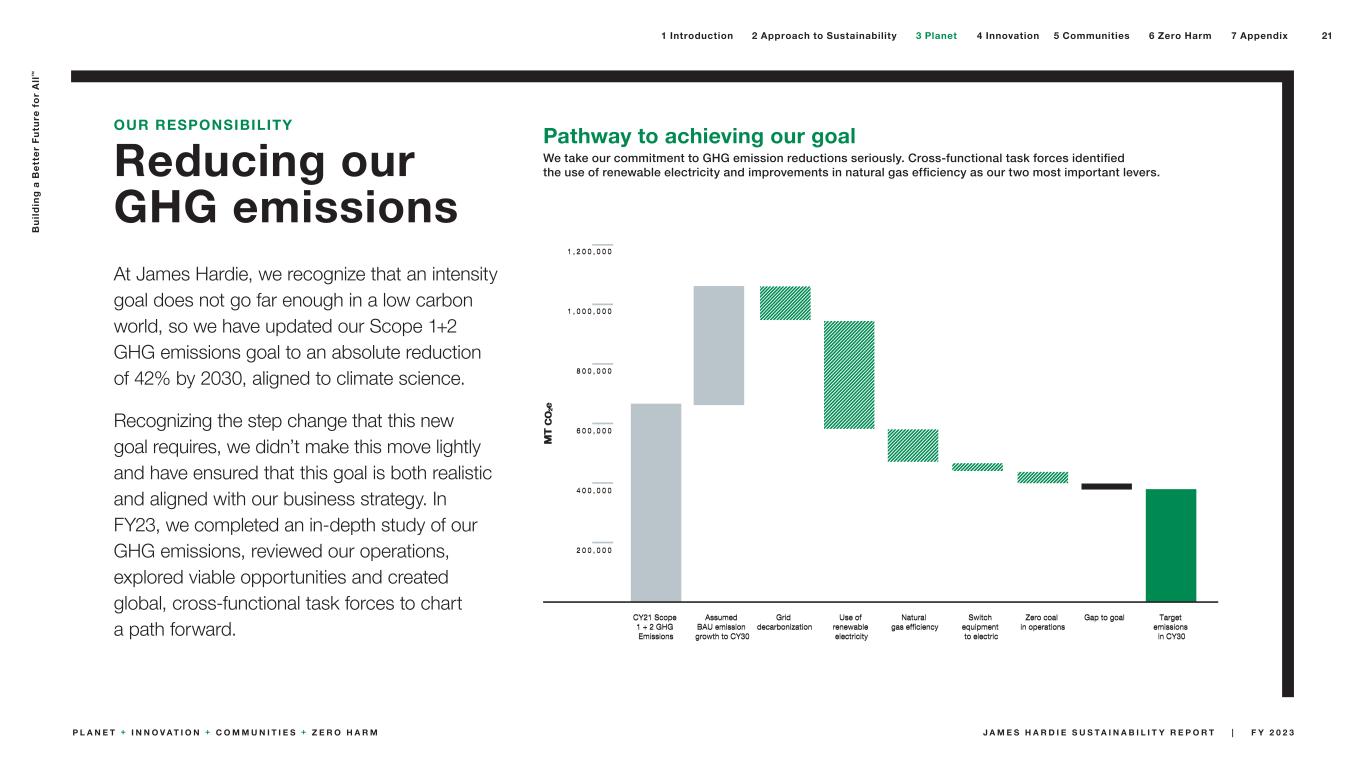
Pathway to achieving our goal We take our commitment to GHG emission reductions seriously. Cross-functional task forces identified the use of renewable electricity and improvements in natural gas efficiency as our two most important levers. 2 0 0 , 0 0 0 4 0 0 , 0 0 0 6 0 0 , 0 0 0 8 0 0 , 0 0 0 1 , 0 0 0 , 0 0 0 1 , 2 0 0 , 0 0 0 CY21 Scope 1 + 2 GHG Emissions Assumed BAU emission growth to CY30 Grid decarbonization Use of renewable electricity Natural gas efficiency Switch equipment to electric Zero coal in operations Gap to goal Target emissions in CY30 M T C O 2e M T C O 2e OUR RESPONSIBILITY Reducing our GHG emissions At James Hardie, we recognize that an intensity goal does not go far enough in a low carbon world, so we have updated our Scope 1+2 GHG emissions goal to an absolute reduction of 42% by 2030, aligned to climate science. Recognizing the step change that this new goal requires, we didn’t make this move lightly and have ensured that this goal is both realistic and aligned with our business strategy. In FY23, we completed an in-depth study of our GHG emissions, reviewed our operations, explored viable opportunities and created global, cross-functional task forces to chart a path forward. 21 B u il d in g a B e tt e r F u tu re f o r A ll ™ J A M E S H A R D I E S U S T A I N A B I L I T Y R E P O R T | F Y 2 0 2 3P L A N E T + I N N O V A T I O N + C O M M U N I T I E S + Z E R O H A R M 2 Approach to Sustainability 3 Planet 4 Innovation1 Introduction 5 Communities 6 Zero Harm 7 Appendix
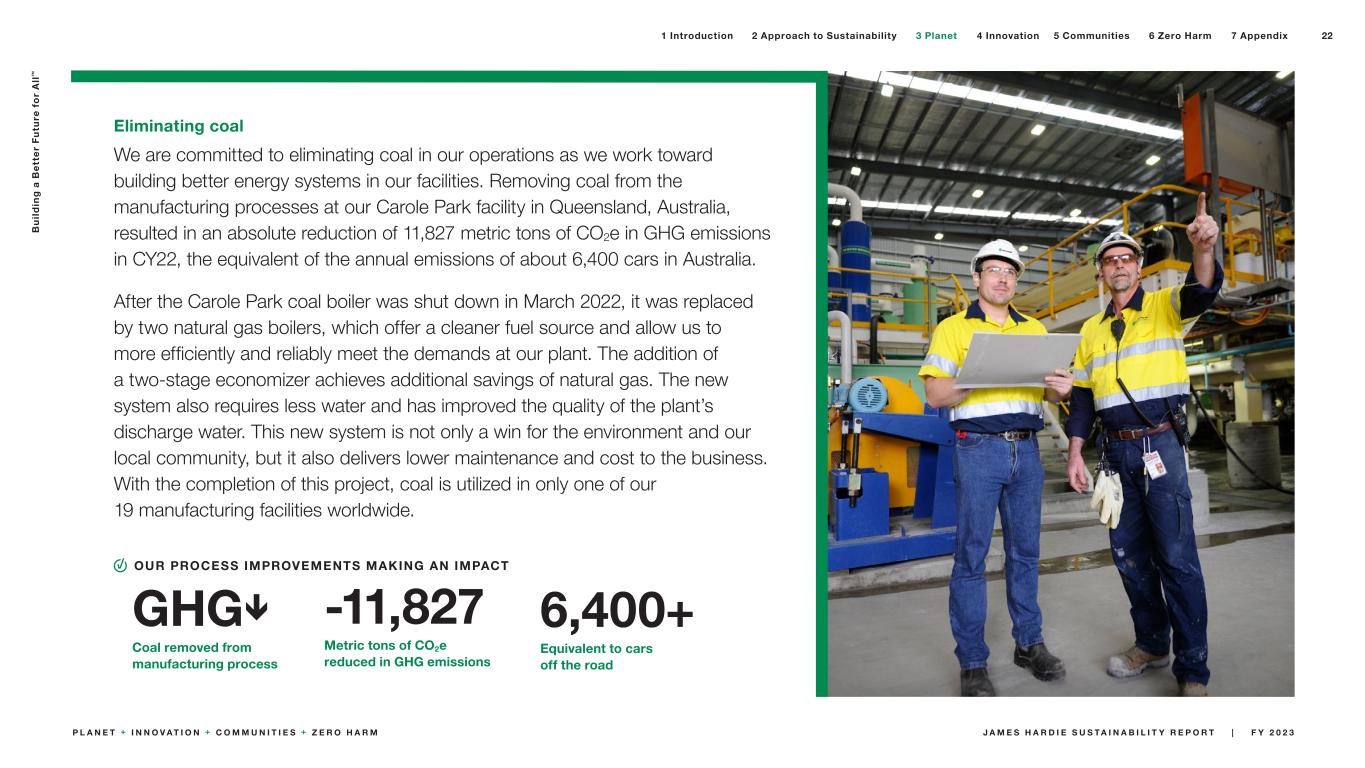
OUR PROCESS IMPROVEMENTS MAKING AN IMPACT - 11,827 Metric tons of CO2e reduced in GHG emissions GHG Coal removed from manufacturing process 6,400+ Equivalent to cars off the road Eliminating coal We are committed to eliminating coal in our operations as we work toward building better energy systems in our facilities. Removing coal from the manufacturing processes at our Carole Park facility in Queensland, Australia, resulted in an absolute reduction of 11,827 metric tons of CO2e in GHG emissions in CY22, the equivalent of the annual emissions of about 6,400 cars in Australia. After the Carole Park coal boiler was shut down in March 2022, it was replaced by two natural gas boilers, which offer a cleaner fuel source and allow us to more efficiently and reliably meet the demands at our plant. The addition of a two-stage economizer achieves additional savings of natural gas. The new system also requires less water and has improved the quality of the plant’s discharge water. This new system is not only a win for the environment and our local community, but it also delivers lower maintenance and cost to the business. With the completion of this project, coal is utilized in only one of our 19 manufacturing facilities worldwide. 22 B u il d in g a B e tt e r F u tu re f o r A ll ™ J A M E S H A R D I E S U S T A I N A B I L I T Y R E P O R T | F Y 2 0 2 3P L A N E T + I N N O V A T I O N + C O M M U N I T I E S + Z E R O H A R M 2 Approach to Sustainability 3 Planet 4 Innovation1 Introduction 5 Communities 6 Zero Harm 7 Appendix
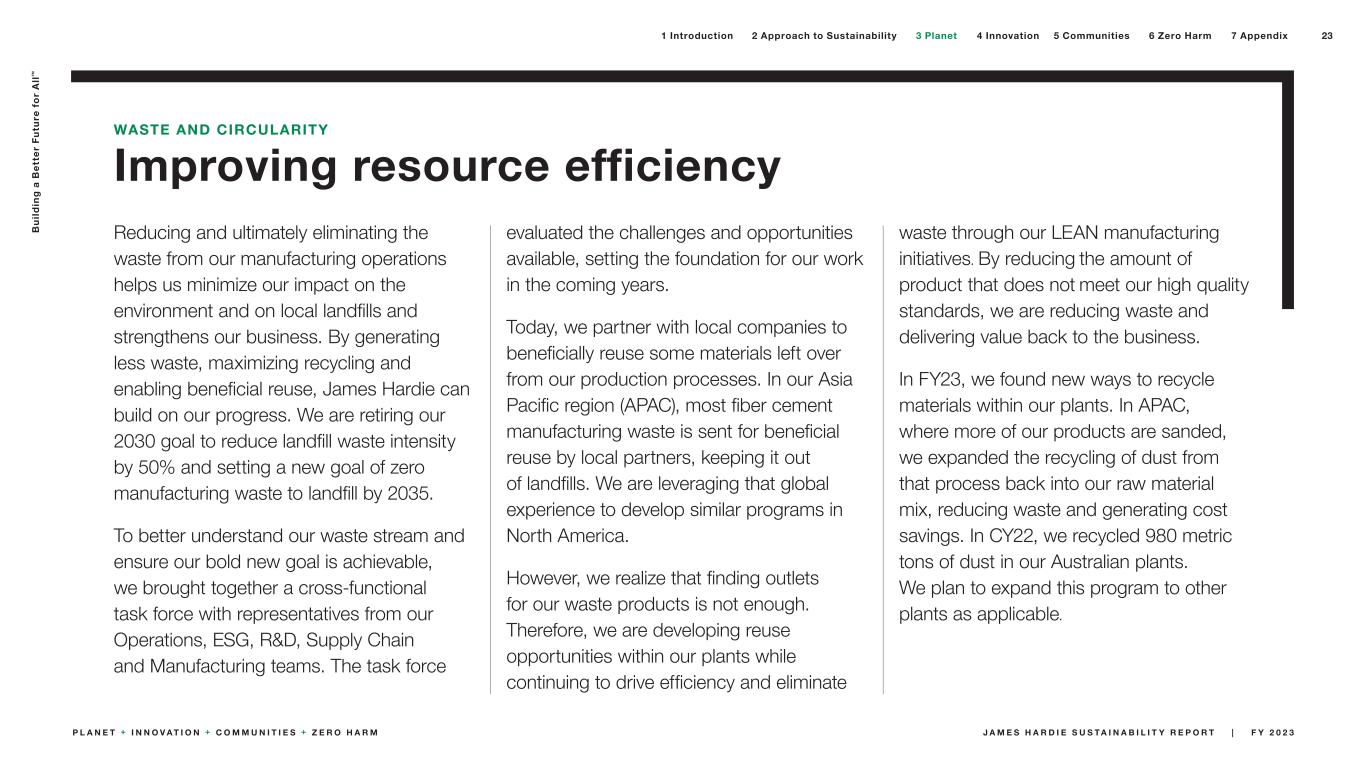
WASTE AND CIRCULARITY Improving resource efficiency Reducing and ultimately eliminating the waste from our manufacturing operations helps us minimize our impact on the environment and on local landfills and strengthens our business. By generating less waste, maximizing recycling and enabling beneficial reuse, James Hardie can build on our progress. We are retiring our 2030 goal to reduce landfill waste intensity by 50% and setting a new goal of zero manufacturing waste to landfill by 2035. To better understand our waste stream and ensure our bold new goal is achievable, we brought together a cross-functional task force with representatives from our Operations, ESG, R&D, Supply Chain and Manufacturing teams. The task force evaluated the challenges and opportunities available, setting the foundation for our work in the coming years. Today, we partner with local companies to beneficially reuse some materials left over from our production processes. In our Asia Pacific region (APAC), most fiber cement manufacturing waste is sent for beneficial reuse by local partners, keeping it out of landfills. We are leveraging that global experience to develop similar programs in North America. However, we realize that finding outlets for our waste products is not enough. Therefore, we are developing reuse opportunities within our plants while continuing to drive efficiency and eliminate waste through our LEAN manufacturing initiatives. By reducing the amount of product that does not meet our high quality standards, we are reducing waste and delivering value back to the business. In FY23, we found new ways to recycle materials within our plants. In APAC, where more of our products are sanded, we expanded the recycling of dust from that process back into our raw material mix, reducing waste and generating cost savings. In CY22, we recycled 980 metric tons of dust in our Australian plants. We plan to expand this program to other plants as applicable. 23 B u il d in g a B e tt e r F u tu re f o r A ll ™ J A M E S H A R D I E S U S T A I N A B I L I T Y R E P O R T | F Y 2 0 2 3P L A N E T + I N N O V A T I O N + C O M M U N I T I E S + Z E R O H A R M 2 Approach to Sustainability 3 Planet 4 Innovation1 Introduction 5 Communities 6 Zero Harm 7 Appendix
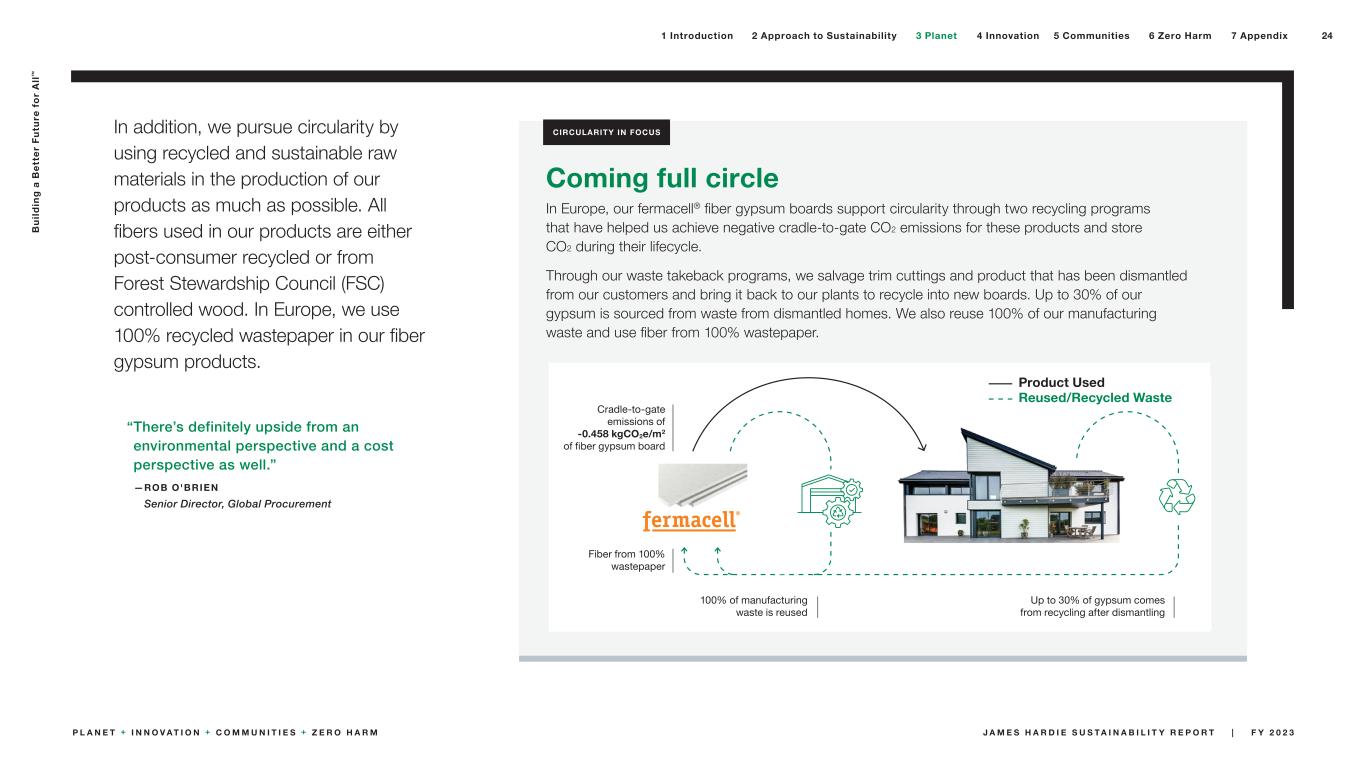
Reused/Recycled Waste Product Used Cradle-to-gate emissions of -0.458 kgCO2e/m2 of fiber gypsum board Fiber from 100% wastepaper Up to 30% of gypsum comes from recycling after dismantling 100% of manufacturing waste is reused In addition, we pursue circularity by using recycled and sustainable raw materials in the production of our products as much as possible. All fibers used in our products are either post-consumer recycled or from Forest Stewardship Council (FSC) controlled wood. In Europe, we use 100% recycled wastepaper in our fiber gypsum products. “ There’s definitely upside from an environmental perspective and a cost perspective as well.” — ROB O'BRIEN Senior Director, Global Procurement Coming full circle In Europe, our fermacell® fiber gypsum boards support circularity through two recycling programs that have helped us achieve negative cradle-to-gate CO2 emissions for these products and store CO2 during their lifecycle. Through our waste takeback programs, we salvage trim cuttings and product that has been dismantled from our customers and bring it back to our plants to recycle into new boards. Up to 30% of our gypsum is sourced from waste from dismantled homes. We also reuse 100% of our manufacturing waste and use fiber from 100% wastepaper. CIRCULARITY IN FOCUS 24 B u il d in g a B e tt e r F u tu re f o r A ll ™ J A M E S H A R D I E S U S T A I N A B I L I T Y R E P O R T | F Y 2 0 2 3P L A N E T + I N N O V A T I O N + C O M M U N I T I E S + Z E R O H A R M 2 Approach to Sustainability 3 Planet 4 Innovation1 Introduction 5 Communities 6 Zero Harm 7 Appendix
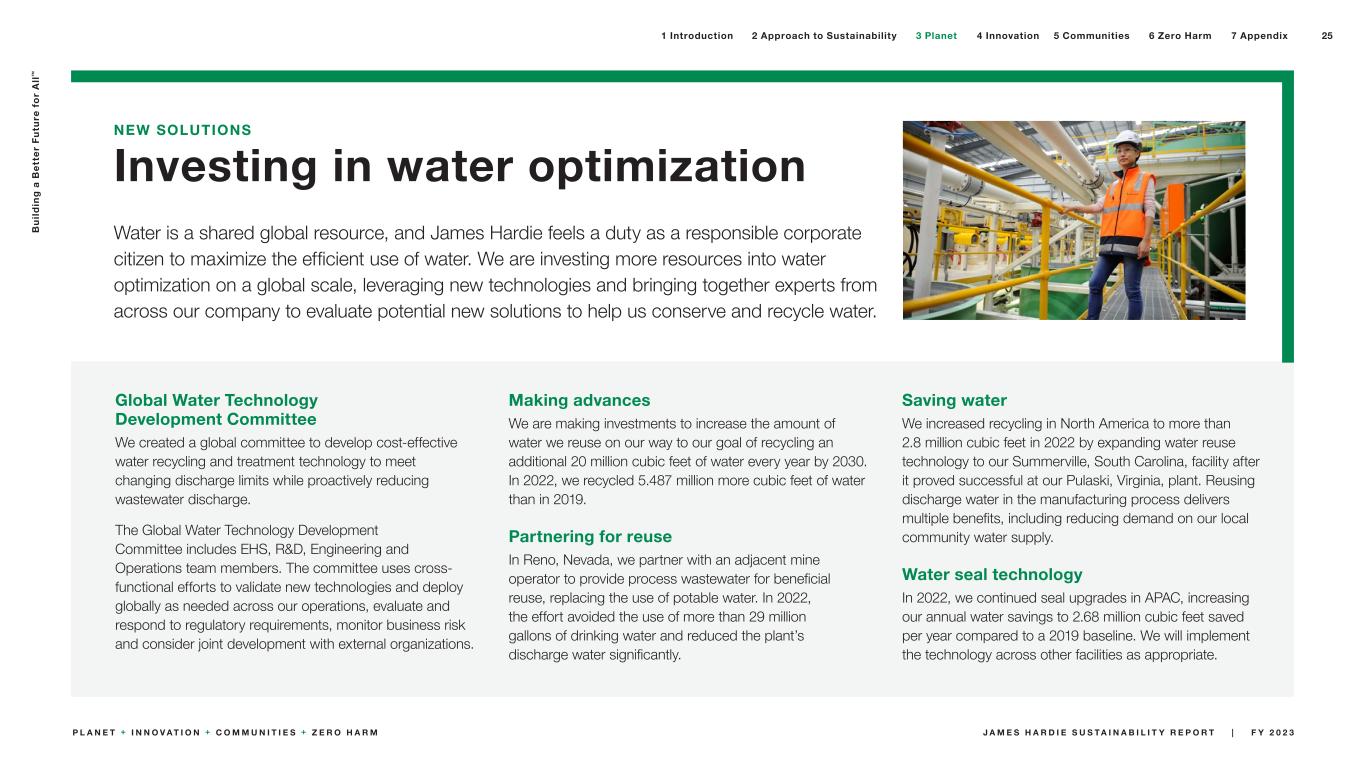
NEW SOLUTIONS Investing in water optimization Water is a shared global resource, and James Hardie feels a duty as a responsible corporate citizen to maximize the efficient use of water. We are investing more resources into water optimization on a global scale, leveraging new technologies and bringing together experts from across our company to evaluate potential new solutions to help us conserve and recycle water. Global Water Technology Development Committee We created a global committee to develop cost-effective water recycling and treatment technology to meet changing discharge limits while proactively reducing wastewater discharge. The Global Water Technology Development Committee includes EHS, R&D, Engineering and Operations team members. The committee uses cross- functional efforts to validate new technologies and deploy globally as needed across our operations, evaluate and respond to regulatory requirements, monitor business risk and consider joint development with external organizations. Making advances We are making investments to increase the amount of water we reuse on our way to our goal of recycling an additional 20 million cubic feet of water every year by 2030. In 2022, we recycled 5.487 million more cubic feet of water than in 2019. Partnering for reuse In Reno, Nevada, we partner with an adjacent mine operator to provide process wastewater for beneficial reuse, replacing the use of potable water. In 2022, the effort avoided the use of more than 29 million gallons of drinking water and reduced the plant’s discharge water significantly. Saving water We increased recycling in North America to more than 2.8 million cubic feet in 2022 by expanding water reuse technology to our Summerville, South Carolina, facility after it proved successful at our Pulaski, Virginia, plant. Reusing discharge water in the manufacturing process delivers multiple benefits, including reducing demand on our local community water supply. Water seal technology In 2022, we continued seal upgrades in APAC, increasing our annual water savings to 2.68 million cubic feet saved per year compared to a 2019 baseline. We will implement the technology across other facilities as appropriate. 25 B u il d in g a B e tt e r F u tu re f o r A ll ™ J A M E S H A R D I E S U S T A I N A B I L I T Y R E P O R T | F Y 2 0 2 3P L A N E T + I N N O V A T I O N + C O M M U N I T I E S + Z E R O H A R M 2 Approach to Sustainability 3 Planet 4 Innovation1 Introduction 5 Communities 6 Zero Harm 7 Appendix
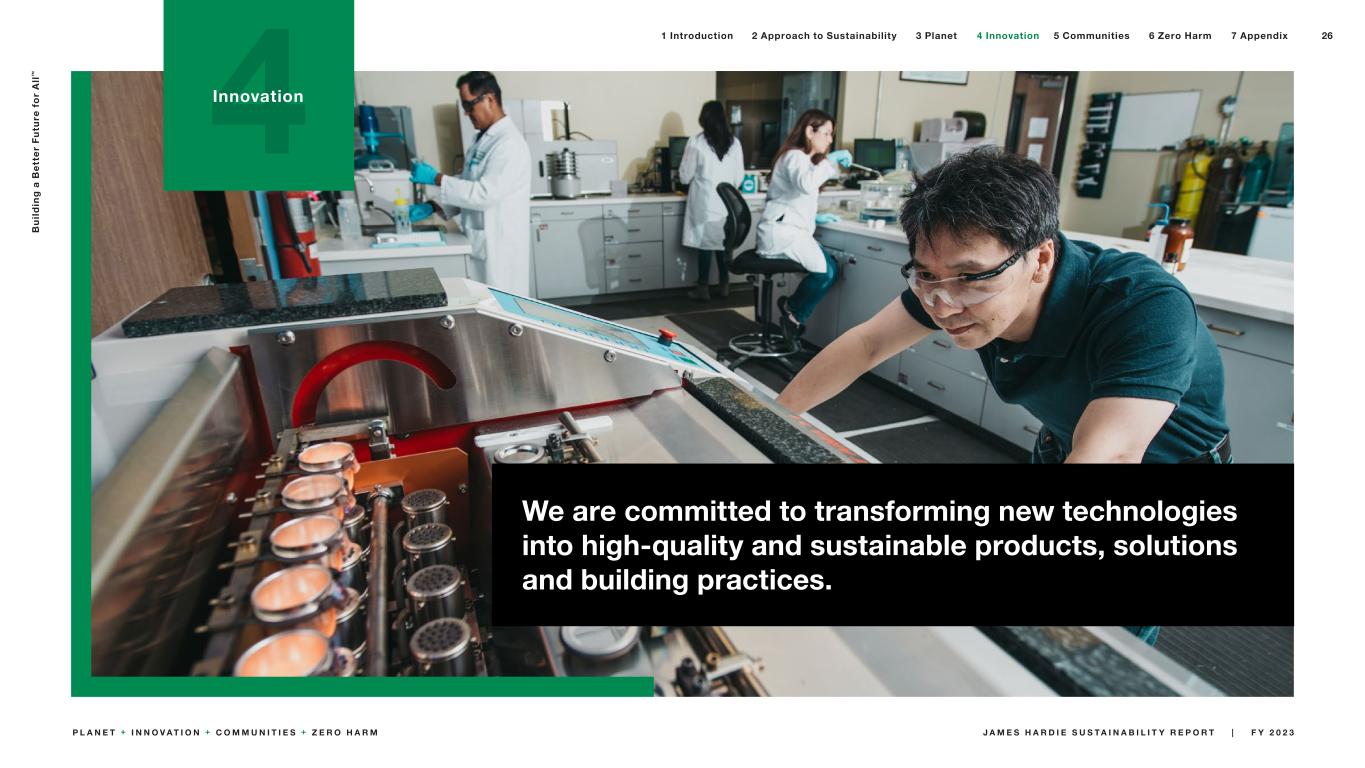
4Innovation We are committed to transforming new technologies into high-quality and sustainable products, solutions and building practices. 26 B u il d in g a B e tt e r F u tu re f o r A ll ™ J A M E S H A R D I E S U S T A I N A B I L I T Y R E P O R T | F Y 2 0 2 3P L A N E T + I N N O V A T I O N + C O M M U N I T I E S + Z E R O H A R M 2 Approach to Sustainability 3 Planet 4 Innovation1 Introduction 5 Communities 6 Zero Harm 7 Appendix
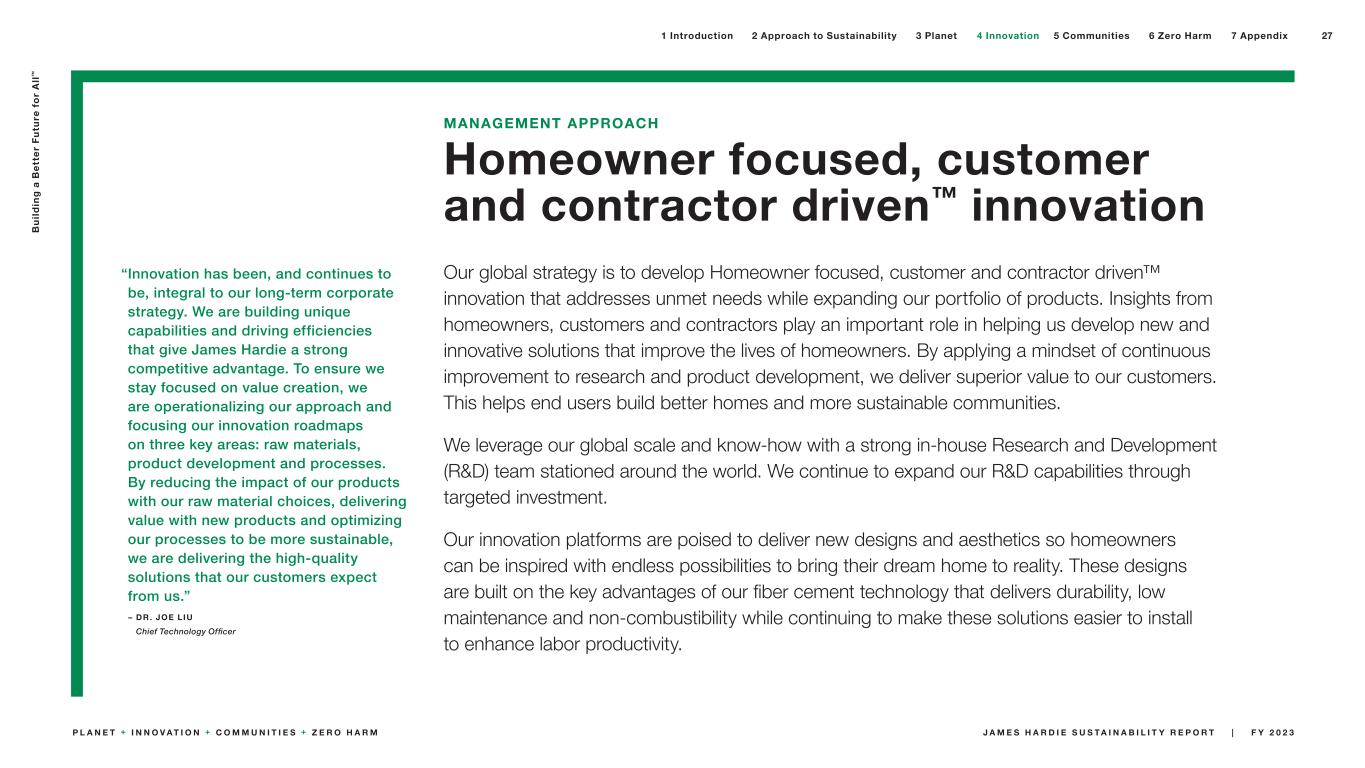
MANAGEMENT APPROACH Homeowner focused, customer and contractor driven™ innovation Our global strategy is to develop Homeowner focused, customer and contractor driven™ innovation that addresses unmet needs while expanding our portfolio of products. Insights from homeowners, customers and contractors play an important role in helping us develop new and innovative solutions that improve the lives of homeowners. By applying a mindset of continuous improvement to research and product development, we deliver superior value to our customers. This helps end users build better homes and more sustainable communities. We leverage our global scale and know-how with a strong in-house Research and Development (R&D) team stationed around the world. We continue to expand our R&D capabilities through targeted investment. Our innovation platforms are poised to deliver new designs and aesthetics so homeowners can be inspired with endless possibilities to bring their dream home to reality. These designs are built on the key advantages of our fiber cement technology that delivers durability, low maintenance and non-combustibility while continuing to make these solutions easier to install to enhance labor productivity. “ Innovation has been, and continues to be, integral to our long-term corporate strategy. We are building unique capabilities and driving efficiencies that give James Hardie a strong competitive advantage. To ensure we stay focused on value creation, we are operationalizing our approach and focusing our innovation roadmaps on three key areas: raw materials, product development and processes. By reducing the impact of our products with our raw material choices, delivering value with new products and optimizing our processes to be more sustainable, we are delivering the high-quality solutions that our customers expect from us.” – DR . JOE LIU Chief Technology Officer 27 B u il d in g a B e tt e r F u tu re f o r A ll ™ J A M E S H A R D I E S U S T A I N A B I L I T Y R E P O R T | F Y 2 0 2 3P L A N E T + I N N O V A T I O N + C O M M U N I T I E S + Z E R O H A R M 2 Approach to Sustainability 3 Planet 4 Innovation1 Introduction 5 Communities 6 Zero Harm 7 Appendix
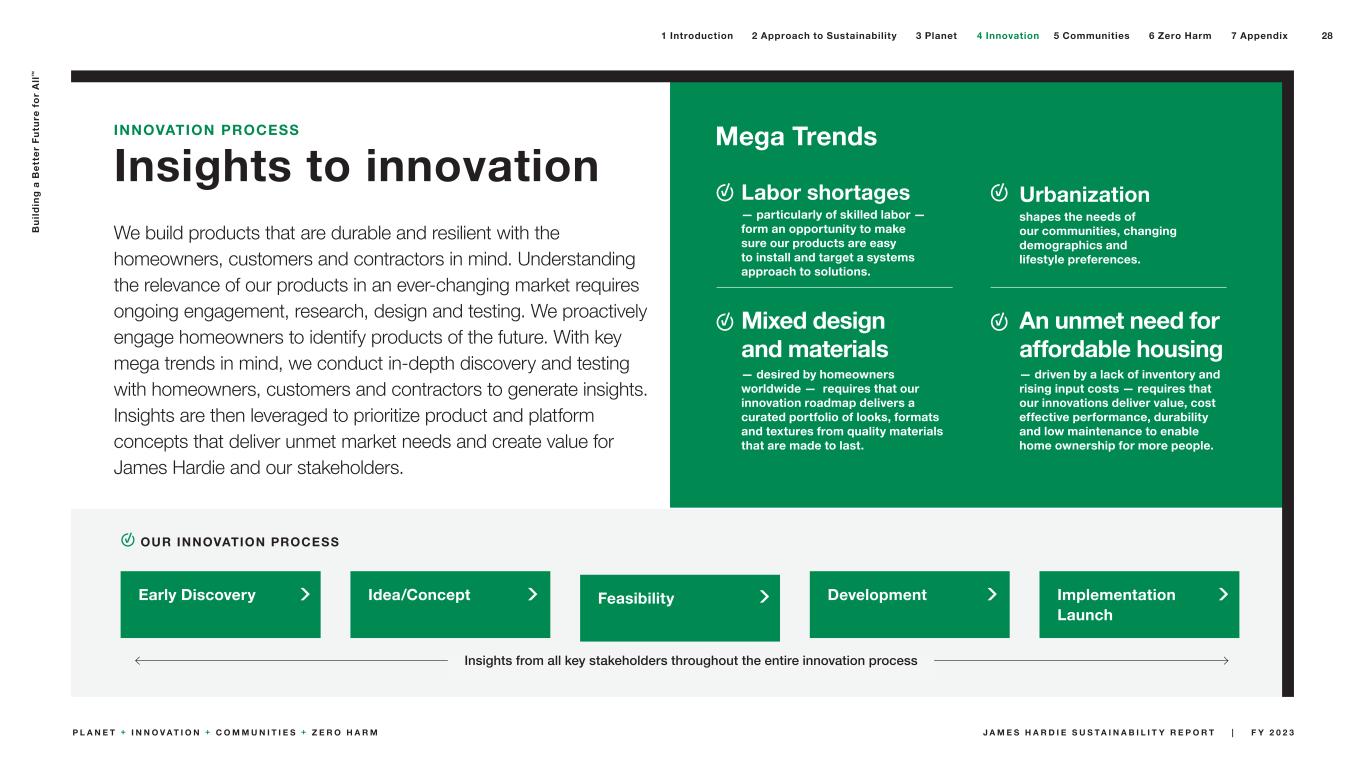
Early Discovery Idea/Concept Feasibility Development Implementation Launch OUR INNOVATION PROCESS Insights from all key stakeholders throughout the entire innovation process INNOVATION PROCESS Insights to innovation We build products that are durable and resilient with the homeowners, customers and contractors in mind. Understanding the relevance of our products in an ever-changing market requires ongoing engagement, research, design and testing. We proactively engage homeowners to identify products of the future. With key mega trends in mind, we conduct in-depth discovery and testing with homeowners, customers and contractors to generate insights. Insights are then leveraged to prioritize product and platform concepts that deliver unmet market needs and create value for James Hardie and our stakeholders. Mega Trends Labor shortages — particularly of skilled labor — form an opportunity to make sure our products are easy to install and target a systems approach to solutions. An unmet need for affordable housing — driven by a lack of inventory and rising input costs — requires that our innovations deliver value, cost effective performance, durability and low maintenance to enable home ownership for more people. Urbanization shapes the needs of our communities, changing demographics and lifestyle preferences. Mixed design and materials — desired by homeowners worldwide — requires that our innovation roadmap delivers a curated portfolio of looks, formats and textures from quality materials that are made to last. 28 B u il d in g a B e tt e r F u tu re f o r A ll ™ J A M E S H A R D I E S U S T A I N A B I L I T Y R E P O R T | F Y 2 0 2 3P L A N E T + I N N O V A T I O N + C O M M U N I T I E S + Z E R O H A R M 2 Approach to Sustainability 3 Planet 4 Innovation1 Introduction 5 Communities 6 Zero Harm 7 Appendix
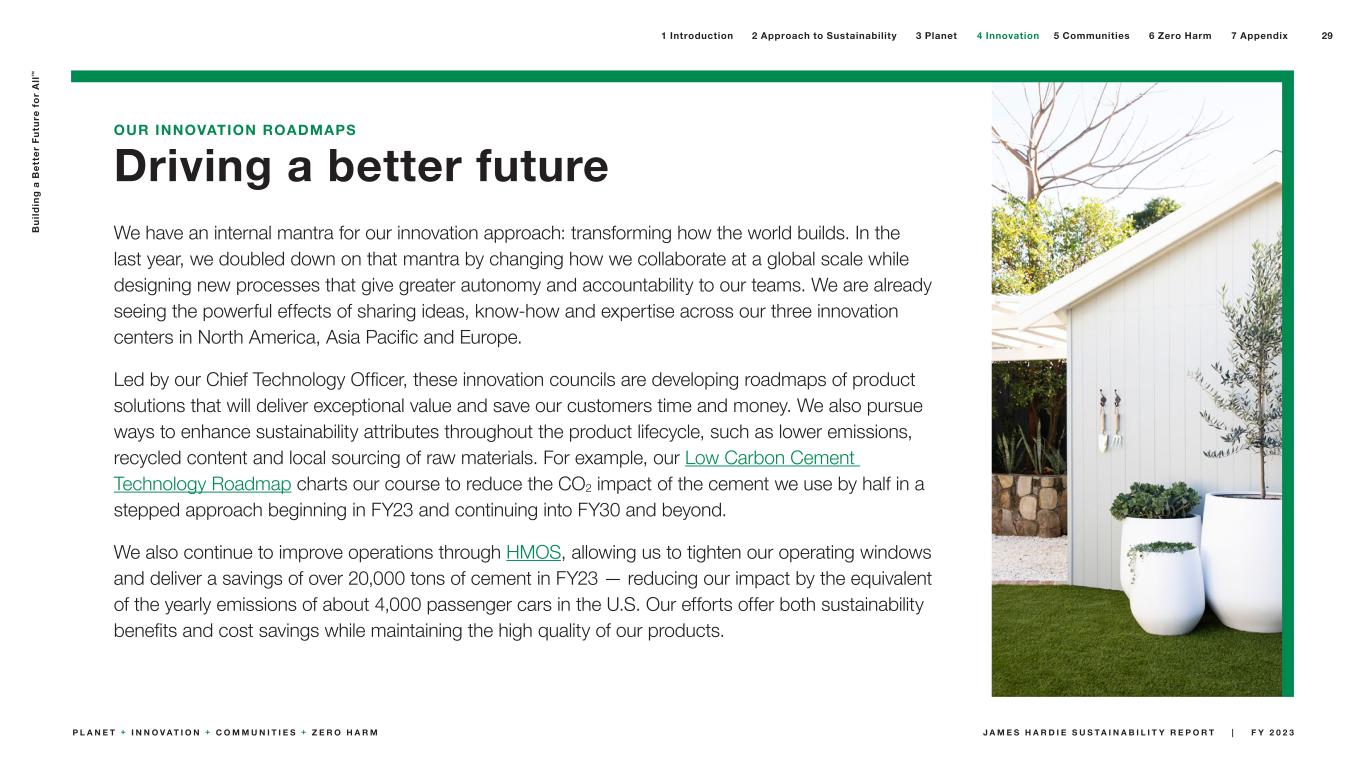
OUR INNOVATION ROADMAPS Driving a better future We have an internal mantra for our innovation approach: transforming how the world builds. In the last year, we doubled down on that mantra by changing how we collaborate at a global scale while designing new processes that give greater autonomy and accountability to our teams. We are already seeing the powerful effects of sharing ideas, know-how and expertise across our three innovation centers in North America, Asia Pacific and Europe. Led by our Chief Technology Officer, these innovation councils are developing roadmaps of product solutions that will deliver exceptional value and save our customers time and money. We also pursue ways to enhance sustainability attributes throughout the product lifecycle, such as lower emissions, recycled content and local sourcing of raw materials. For example, our Low Carbon Cement Technology Roadmap charts our course to reduce the CO2 impact of the cement we use by half in a stepped approach beginning in FY23 and continuing into FY30 and beyond. We also continue to improve operations through HMOS, allowing us to tighten our operating windows and deliver a savings of over 20,000 tons of cement in FY23 — reducing our impact by the equivalent of the yearly emissions of about 4,000 passenger cars in the U.S. Our efforts offer both sustainability benefits and cost savings while maintaining the high quality of our products. 29 B u il d in g a B e tt e r F u tu re f o r A ll ™ J A M E S H A R D I E S U S T A I N A B I L I T Y R E P O R T | F Y 2 0 2 3P L A N E T + I N N O V A T I O N + C O M M U N I T I E S + Z E R O H A R M 2 Approach to Sustainability 3 Planet 4 Innovation1 Introduction 5 Communities 6 Zero Harm 7 Appendix
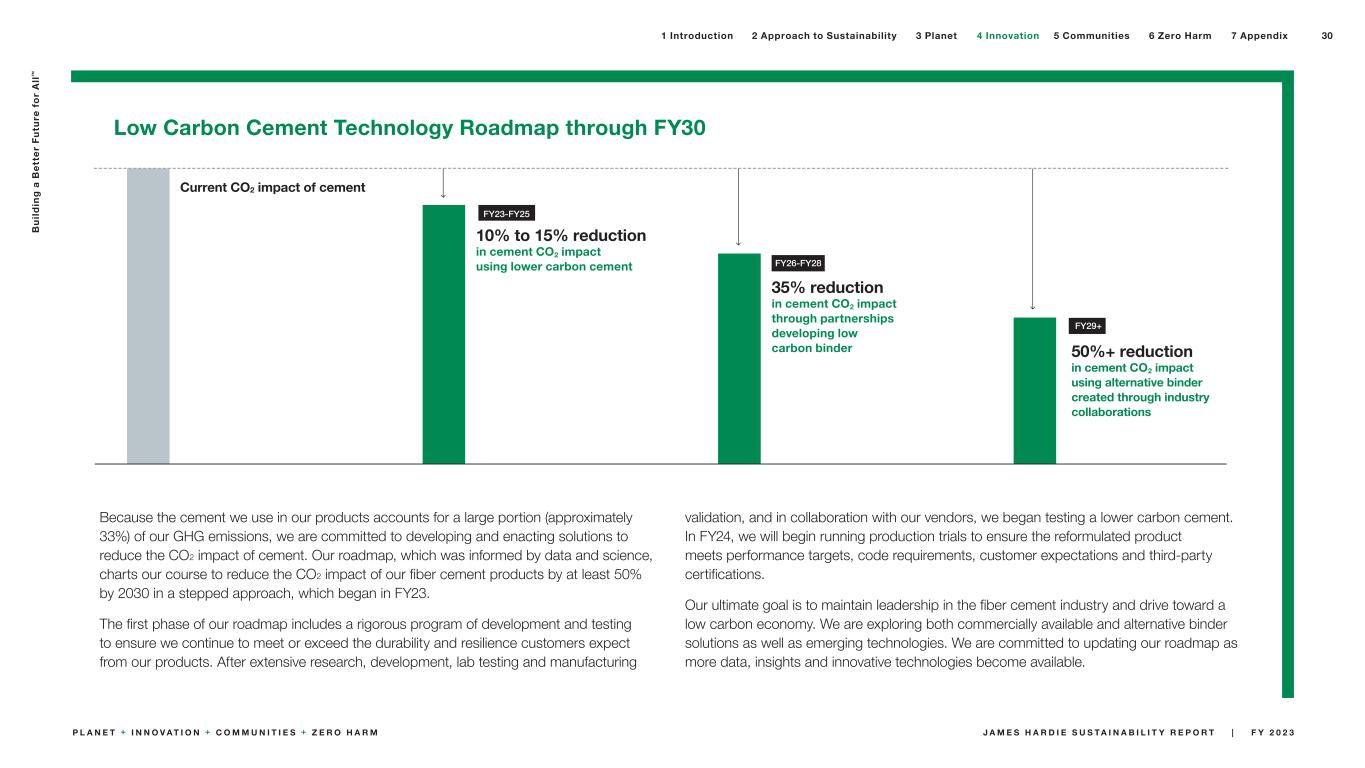
Because the cement we use in our products accounts for a large portion (approximately 33%) of our GHG emissions, we are committed to developing and enacting solutions to reduce the CO2 impact of cement. Our roadmap, which was informed by data and science, charts our course to reduce the CO2 impact of our fiber cement products by at least 50% by 2030 in a stepped approach, which began in FY23. The first phase of our roadmap includes a rigorous program of development and testing to ensure we continue to meet or exceed the durability and resilience customers expect from our products. After extensive research, development, lab testing and manufacturing validation, and in collaboration with our vendors, we began testing a lower carbon cement. In FY24, we will begin running production trials to ensure the reformulated product meets performance targets, code requirements, customer expectations and third-party certifications. Our ultimate goal is to maintain leadership in the fiber cement industry and drive toward a low carbon economy. We are exploring both commercially available and alternative binder solutions as well as emerging technologies. We are committed to updating our roadmap as more data, insights and innovative technologies become available. Low Carbon Cement Technology Roadmap through FY30 Current CO2 impact of cement 10% to 15% reduction in cement CO2 impact using lower carbon cement FY23-FY25 FY26-FY28 FY29+ 35% reduction in cement CO2 impact through partnerships developing low carbon binder 50%+ reduction in cement CO2 impact using alternative binder created through industry collaborations 30 B u il d in g a B e tt e r F u tu re f o r A ll ™ J A M E S H A R D I E S U S T A I N A B I L I T Y R E P O R T | F Y 2 0 2 3P L A N E T + I N N O V A T I O N + C O M M U N I T I E S + Z E R O H A R M 2 Approach to Sustainability 3 Planet 4 Innovation1 Introduction 5 Communities 6 Zero Harm 7 Appendix
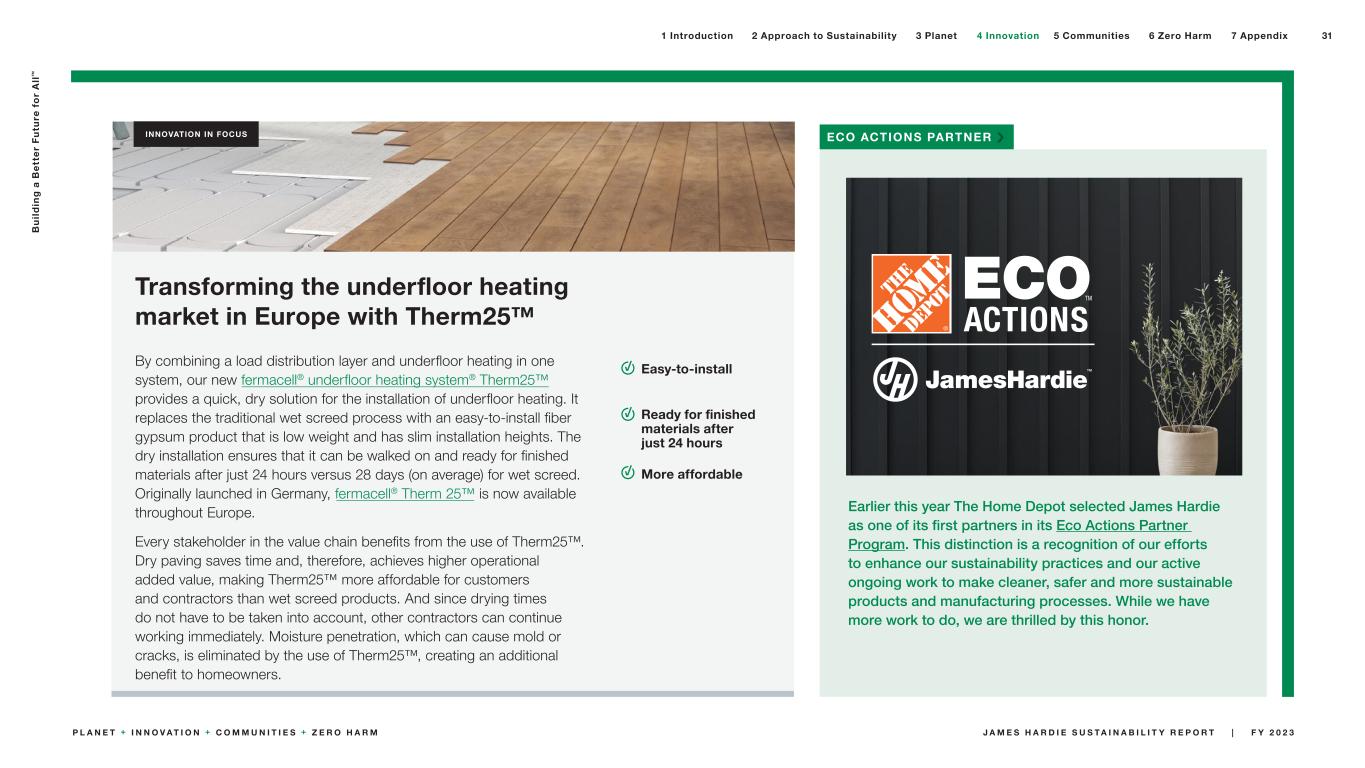
By combining a load distribution layer and underfloor heating in one system, our new fermacell® underfloor heating system® Therm25™ provides a quick, dry solution for the installation of underfloor heating. It replaces the traditional wet screed process with an easy-to-install fiber gypsum product that is low weight and has slim installation heights. The dry installation ensures that it can be walked on and ready for finished materials after just 24 hours versus 28 days (on average) for wet screed. Originally launched in Germany, fermacell® Therm 25™ is now available throughout Europe. Every stakeholder in the value chain benefits from the use of Therm25™. Dry paving saves time and, therefore, achieves higher operational added value, making Therm25™ more affordable for customers and contractors than wet screed products. And since drying times do not have to be taken into account, other contractors can continue working immediately. Moisture penetration, which can cause mold or cracks, is eliminated by the use of Therm25™, creating an additional benefit to homeowners. Transforming the underfloor heating market in Europe with Therm25™ Easy-to-install Ready for finished materials after just 24 hours More affordable ECO ACTIONS PARTNER › Earlier this year The Home Depot selected James Hardie as one of its first partners in its Eco Actions Partner Program. This distinction is a recognition of our efforts to enhance our sustainability practices and our active ongoing work to make cleaner, safer and more sustainable products and manufacturing processes. While we have more work to do, we are thrilled by this honor. INNOVATION IN FOCUS 31 B u il d in g a B e tt e r F u tu re f o r A ll ™ J A M E S H A R D I E S U S T A I N A B I L I T Y R E P O R T | F Y 2 0 2 3P L A N E T + I N N O V A T I O N + C O M M U N I T I E S + Z E R O H A R M 2 Approach to Sustainability 3 Planet 4 Innovation1 Introduction 5 Communities 6 Zero Harm 7 Appendix
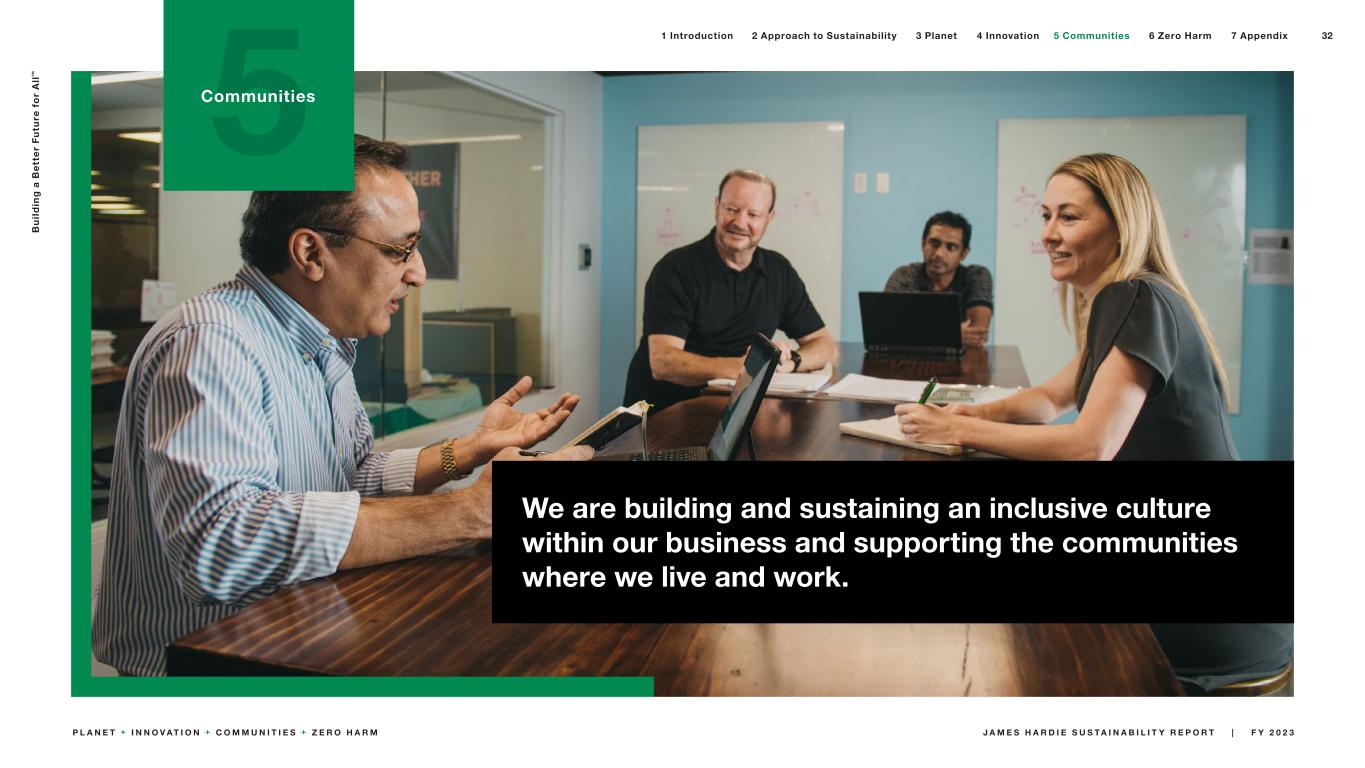
5Communities We are building and sustaining an inclusive culture within our business and supporting the communities where we live and work. 32 B u il d in g a B e tt e r F u tu re f o r A ll ™ J A M E S H A R D I E S U S T A I N A B I L I T Y R E P O R T | F Y 2 0 2 3P L A N E T + I N N O V A T I O N + C O M M U N I T I E S + Z E R O H A R M 2 Approach to Sustainability 3 Planet 4 Innovation1 Introduction 5 Communities 6 Zero Harm 7 Appendix
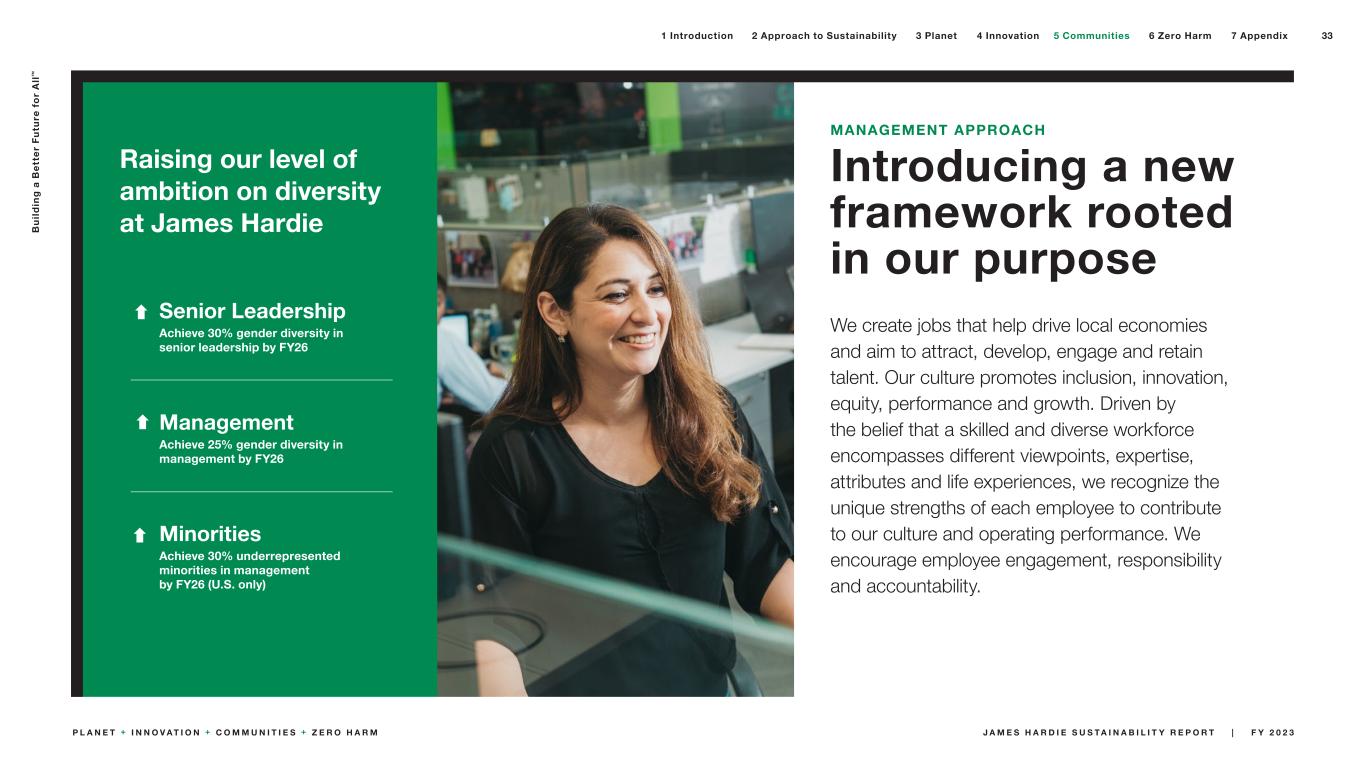
Raising our level of ambition on diversity at James Hardie Senior Leadership Achieve 30% gender diversity in senior leadership by FY26 Management Achieve 25% gender diversity in management by FY26 Minorities Achieve 30% underrepresented minorities in management by FY26 (U.S. only) MANAGEMENT APPROACH Introducing a new framework rooted in our purpose We create jobs that help drive local economies and aim to attract, develop, engage and retain talent. Our culture promotes inclusion, innovation, equity, performance and growth. Driven by the belief that a skilled and diverse workforce encompasses different viewpoints, expertise, attributes and life experiences, we recognize the unique strengths of each employee to contribute to our culture and operating performance. We encourage employee engagement, responsibility and accountability. 33 B u il d in g a B e tt e r F u tu re f o r A ll ™ J A M E S H A R D I E S U S T A I N A B I L I T Y R E P O R T | F Y 2 0 2 3P L A N E T + I N N O V A T I O N + C O M M U N I T I E S + Z E R O H A R M 2 Approach to Sustainability 3 Planet 4 Innovation1 Introduction 5 Communities 6 Zero Harm 7 Appendix
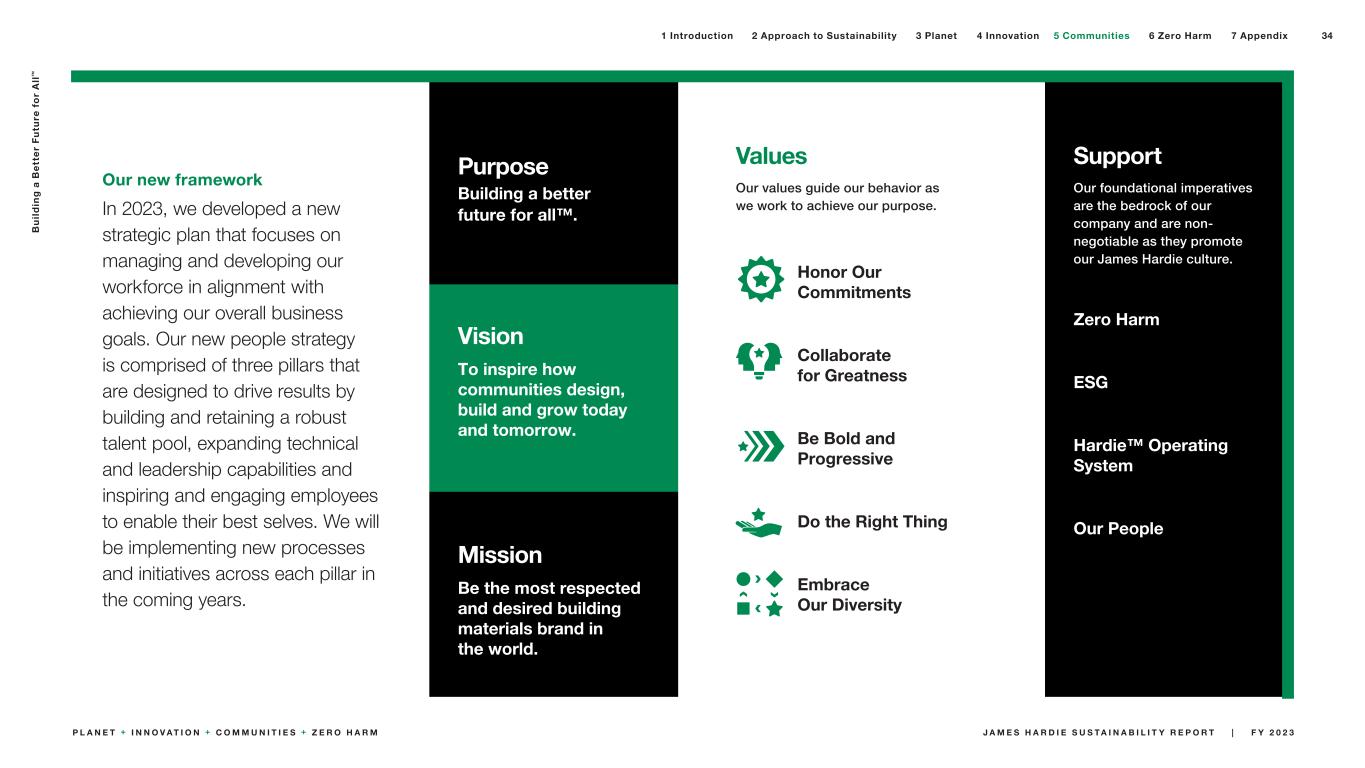
Values Our values guide our behavior as we work to achieve our purpose. Honor Our Commitments Collaborate for Greatness Be Bold and Progressive Do the Right Thing Embrace Our Diversity Purpose Building a better future for all™. Support Our foundational imperatives are the bedrock of our company and are non- negotiable as they promote our James Hardie culture. Zero Harm ESG Hardie™ Operating System Our People Mission Be the most respected and desired building materials brand in the world. Vision To inspire how communities design, build and grow today and tomorrow. Our new framework In 2023, we developed a new strategic plan that focuses on managing and developing our workforce in alignment with achieving our overall business goals. Our new people strategy is comprised of three pillars that are designed to drive results by building and retaining a robust talent pool, expanding technical and leadership capabilities and inspiring and engaging employees to enable their best selves. We will be implementing new processes and initiatives across each pillar in the coming years. 34 B u il d in g a B e tt e r F u tu re f o r A ll ™ J A M E S H A R D I E S U S T A I N A B I L I T Y R E P O R T | F Y 2 0 2 3P L A N E T + I N N O V A T I O N + C O M M U N I T I E S + Z E R O H A R M 2 Approach to Sustainability 3 Planet 4 Innovation1 Introduction 5 Communities 6 Zero Harm 7 Appendix
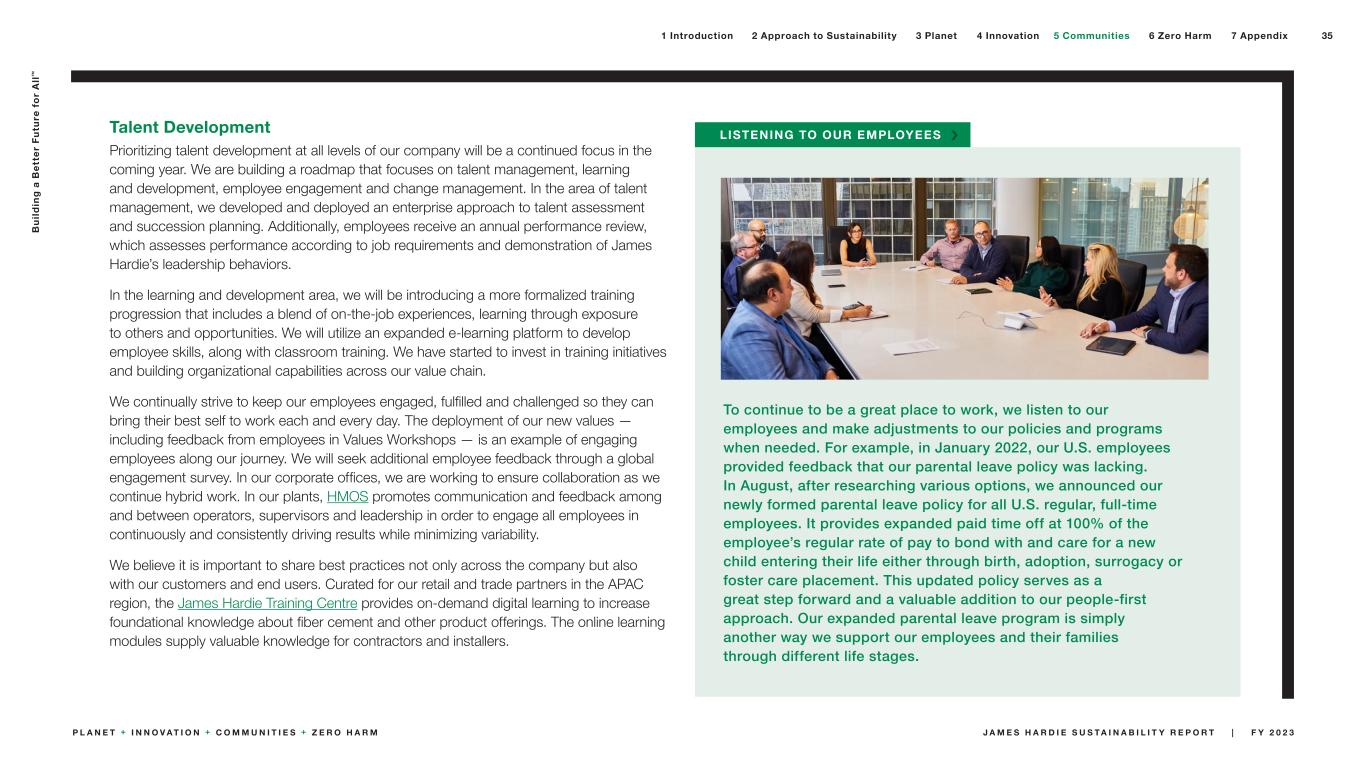
Talent Development Prioritizing talent development at all levels of our company will be a continued focus in the coming year. We are building a roadmap that focuses on talent management, learning and development, employee engagement and change management. In the area of talent management, we developed and deployed an enterprise approach to talent assessment and succession planning. Additionally, employees receive an annual performance review, which assesses performance according to job requirements and demonstration of James Hardie’s leadership behaviors. In the learning and development area, we will be introducing a more formalized training progression that includes a blend of on-the-job experiences, learning through exposure to others and opportunities. We will utilize an expanded e-learning platform to develop employee skills, along with classroom training. We have started to invest in training initiatives and building organizational capabilities across our value chain. We continually strive to keep our employees engaged, fulfilled and challenged so they can bring their best self to work each and every day. The deployment of our new values — including feedback from employees in Values Workshops — is an example of engaging employees along our journey. We will seek additional employee feedback through a global engagement survey. In our corporate offices, we are working to ensure collaboration as we continue hybrid work. In our plants, HMOS promotes communication and feedback among and between operators, supervisors and leadership in order to engage all employees in continuously and consistently driving results while minimizing variability. We believe it is important to share best practices not only across the company but also with our customers and end users. Curated for our retail and trade partners in the APAC region, the James Hardie Training Centre provides on-demand digital learning to increase foundational knowledge about fiber cement and other product offerings. The online learning modules supply valuable knowledge for contractors and installers. LISTENING TO OUR EMPLOYEES › To continue to be a great place to work, we listen to our employees and make adjustments to our policies and programs when needed. For example, in January 2022, our U.S. employees provided feedback that our parental leave policy was lacking. In August, after researching various options, we announced our newly formed parental leave policy for all U.S. regular, full-time employees. It provides expanded paid time off at 100% of the employee’s regular rate of pay to bond with and care for a new child entering their life either through birth, adoption, surrogacy or foster care placement. This updated policy serves as a great step forward and a valuable addition to our people-first approach. Our expanded parental leave program is simply another way we support our employees and their families through different life stages. 35 B u il d in g a B e tt e r F u tu re f o r A ll ™ J A M E S H A R D I E S U S T A I N A B I L I T Y R E P O R T | F Y 2 0 2 3P L A N E T + I N N O V A T I O N + C O M M U N I T I E S + Z E R O H A R M 2 Approach to Sustainability 3 Planet 4 Innovation1 Introduction 5 Communities 6 Zero Harm 7 Appendix
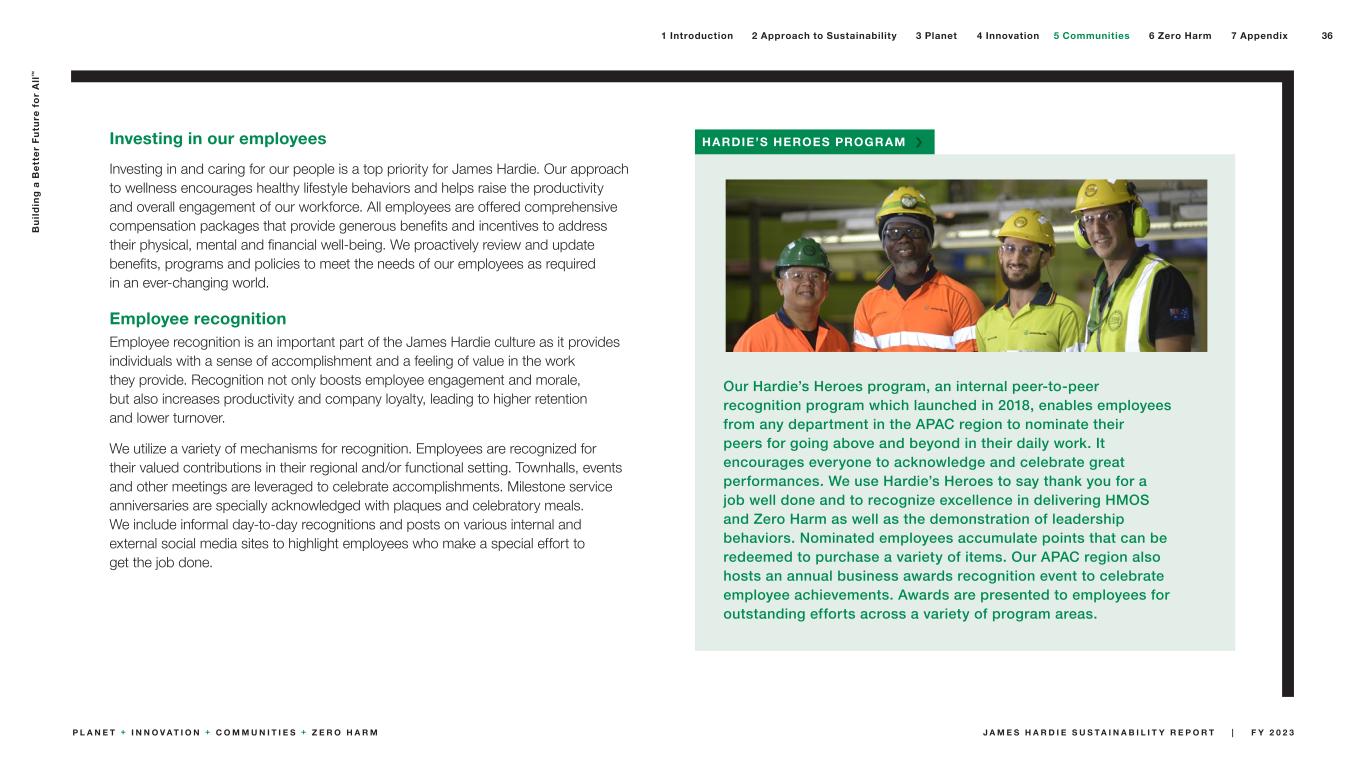
Investing in our employees Investing in and caring for our people is a top priority for James Hardie. Our approach to wellness encourages healthy lifestyle behaviors and helps raise the productivity and overall engagement of our workforce. All employees are offered comprehensive compensation packages that provide generous benefits and incentives to address their physical, mental and financial well-being. We proactively review and update benefits, programs and policies to meet the needs of our employees as required in an ever-changing world. Employee recognition Employee recognition is an important part of the James Hardie culture as it provides individuals with a sense of accomplishment and a feeling of value in the work they provide. Recognition not only boosts employee engagement and morale, but also increases productivity and company loyalty, leading to higher retention and lower turnover. We utilize a variety of mechanisms for recognition. Employees are recognized for their valued contributions in their regional and/or functional setting. Townhalls, events and other meetings are leveraged to celebrate accomplishments. Milestone service anniversaries are specially acknowledged with plaques and celebratory meals. We include informal day-to-day recognitions and posts on various internal and external social media sites to highlight employees who make a special effort to get the job done. HARDIE’S HEROES PROGRAM › Our Hardie’s Heroes program, an internal peer-to-peer recognition program which launched in 2018, enables employees from any department in the APAC region to nominate their peers for going above and beyond in their daily work. It encourages everyone to acknowledge and celebrate great performances. We use Hardie’s Heroes to say thank you for a job well done and to recognize excellence in delivering HMOS and Zero Harm as well as the demonstration of leadership behaviors. Nominated employees accumulate points that can be redeemed to purchase a variety of items. Our APAC region also hosts an annual business awards recognition event to celebrate employee achievements. Awards are presented to employees for outstanding efforts across a variety of program areas. 36 B u il d in g a B e tt e r F u tu re f o r A ll ™ J A M E S H A R D I E S U S T A I N A B I L I T Y R E P O R T | F Y 2 0 2 3P L A N E T + I N N O V A T I O N + C O M M U N I T I E S + Z E R O H A R M 2 Approach to Sustainability 3 Planet 4 Innovation1 Introduction 5 Communities 6 Zero Harm 7 Appendix
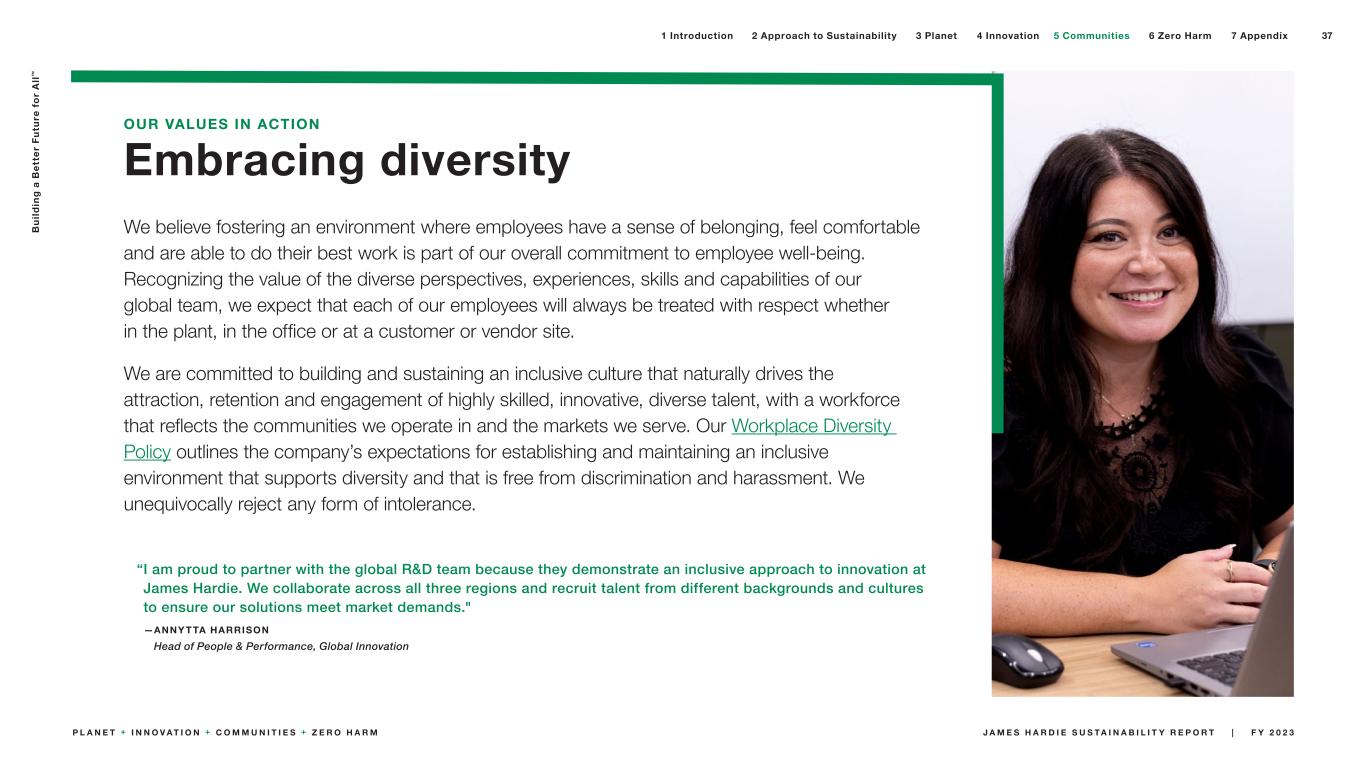
OUR VALUES IN ACTION Embracing diversity We believe fostering an environment where employees have a sense of belonging, feel comfortable and are able to do their best work is part of our overall commitment to employee well-being. Recognizing the value of the diverse perspectives, experiences, skills and capabilities of our global team, we expect that each of our employees will always be treated with respect whether in the plant, in the office or at a customer or vendor site. We are committed to building and sustaining an inclusive culture that naturally drives the attraction, retention and engagement of highly skilled, innovative, diverse talent, with a workforce that reflects the communities we operate in and the markets we serve. Our Workplace Diversity Policy outlines the company’s expectations for establishing and maintaining an inclusive environment that supports diversity and that is free from discrimination and harassment. We unequivocally reject any form of intolerance. “ I am proud to partner with the global R&D team because they demonstrate an inclusive approach to innovation at James Hardie. We collaborate across all three regions and recruit talent from different backgrounds and cultures to ensure our solutions meet market demands." — ANNY T TA HARRISON Head of People & Performance, Global Innovation 37 B u il d in g a B e tt e r F u tu re f o r A ll ™ J A M E S H A R D I E S U S T A I N A B I L I T Y R E P O R T | F Y 2 0 2 3P L A N E T + I N N O V A T I O N + C O M M U N I T I E S + Z E R O H A R M 2 Approach to Sustainability 3 Planet 4 Innovation1 Introduction 5 Communities 6 Zero Harm 7 Appendix
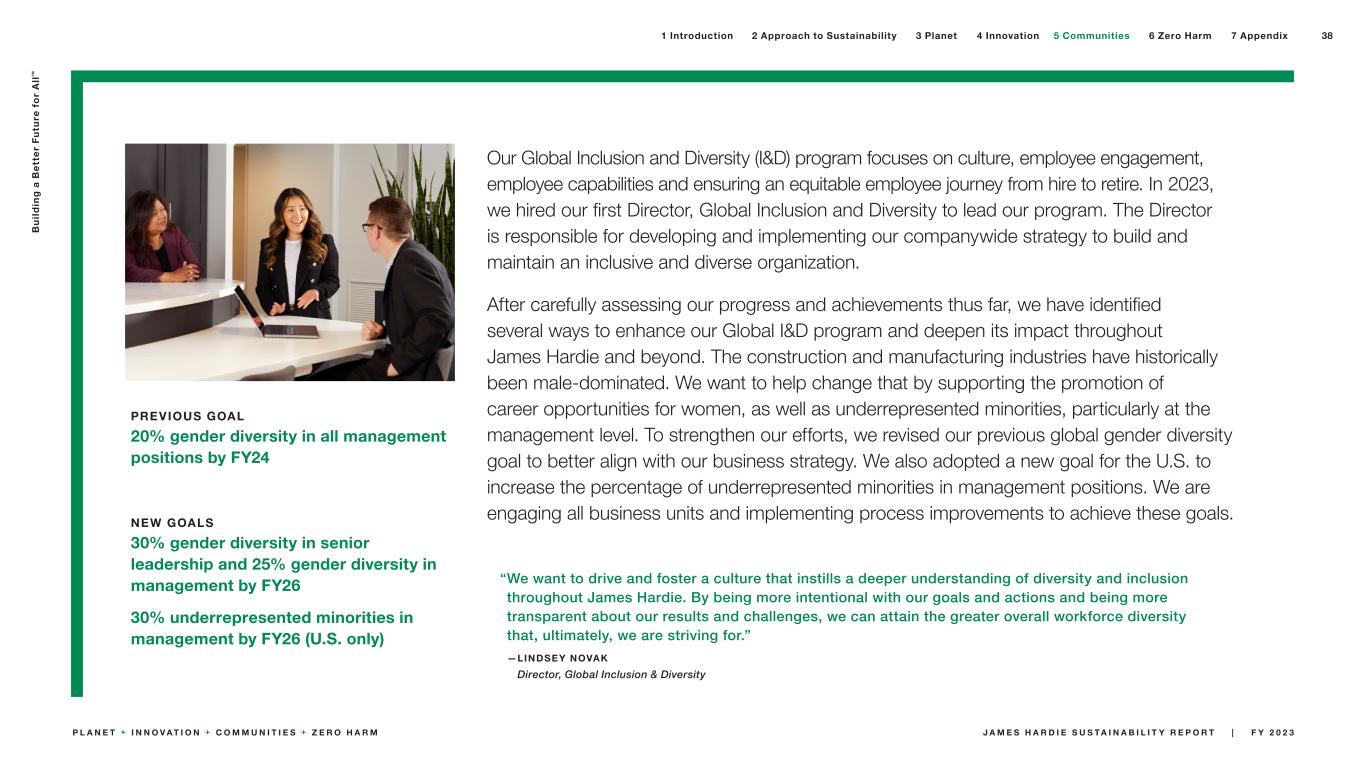
PREVIOUS GOAL 20% gender diversity in all management positions by FY24 NEW GOALS 30% gender diversity in senior leadership and 25% gender diversity in management by FY26 30% underrepresented minorities in management by FY26 (U.S. only) Our Global Inclusion and Diversity (I&D) program focuses on culture, employee engagement, employee capabilities and ensuring an equitable employee journey from hire to retire. In 2023, we hired our first Director, Global Inclusion and Diversity to lead our program. The Director is responsible for developing and implementing our companywide strategy to build and maintain an inclusive and diverse organization. After carefully assessing our progress and achievements thus far, we have identified several ways to enhance our Global I&D program and deepen its impact throughout James Hardie and beyond. The construction and manufacturing industries have historically been male-dominated. We want to help change that by supporting the promotion of career opportunities for women, as well as underrepresented minorities, particularly at the management level. To strengthen our efforts, we revised our previous global gender diversity goal to better align with our business strategy. We also adopted a new goal for the U.S. to increase the percentage of underrepresented minorities in management positions. We are engaging all business units and implementing process improvements to achieve these goals. “ We want to drive and foster a culture that instills a deeper understanding of diversity and inclusion throughout James Hardie. By being more intentional with our goals and actions and being more transparent about our results and challenges, we can attain the greater overall workforce diversity that, ultimately, we are striving for.” — LINDSEY NOVAK Director, Global Inclusion & Diversity 38 B u il d in g a B e tt e r F u tu re f o r A ll ™ J A M E S H A R D I E S U S T A I N A B I L I T Y R E P O R T | F Y 2 0 2 3P L A N E T + I N N O V A T I O N + C O M M U N I T I E S + Z E R O H A R M 2 Approach to Sustainability 3 Planet 4 Innovation1 Introduction 5 Communities 6 Zero Harm 7 Appendix
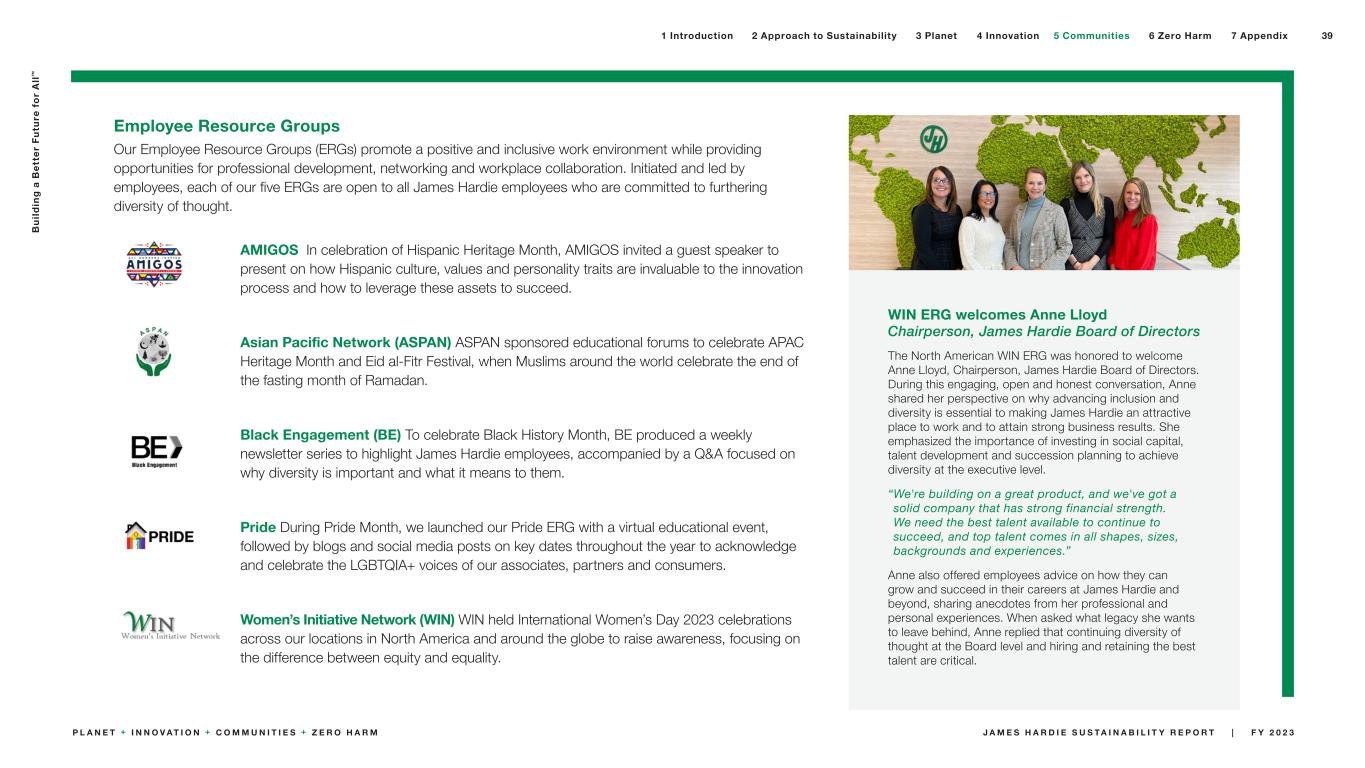
WIN ERG welcomes Anne Lloyd Chairperson, James Hardie Board of Directors The North American WIN ERG was honored to welcome Anne Lloyd, Chairperson, James Hardie Board of Directors. During this engaging, open and honest conversation, Anne shared her perspective on why advancing inclusion and diversity is essential to making James Hardie an attractive place to work and to attain strong business results. She emphasized the importance of investing in social capital, talent development and succession planning to achieve diversity at the executive level. “ We're building on a great product, and we've got a solid company that has strong financial strength. We need the best talent available to continue to succeed, and top talent comes in all shapes, sizes, backgrounds and experiences.” Anne also offered employees advice on how they can grow and succeed in their careers at James Hardie and beyond, sharing anecdotes from her professional and personal experiences. When asked what legacy she wants to leave behind, Anne replied that continuing diversity of thought at the Board level and hiring and retaining the best talent are critical. Employee Resource Groups Our Employee Resource Groups (ERGs) promote a positive and inclusive work environment while providing opportunities for professional development, networking and workplace collaboration. Initiated and led by employees, each of our five ERGs are open to all James Hardie employees who are committed to furthering diversity of thought. AMIGOS In celebration of Hispanic Heritage Month, AMIGOS invited a guest speaker to present on how Hispanic culture, values and personality traits are invaluable to the innovation process and how to leverage these assets to succeed. Asian Pacific Network (ASPAN) ASPAN sponsored educational forums to celebrate APAC Heritage Month and Eid al-Fitr Festival, when Muslims around the world celebrate the end of the fasting month of Ramadan. Black Engagement (BE) To celebrate Black History Month, BE produced a weekly newsletter series to highlight James Hardie employees, accompanied by a Q&A focused on why diversity is important and what it means to them. Pride During Pride Month, we launched our Pride ERG with a virtual educational event, followed by blogs and social media posts on key dates throughout the year to acknowledge and celebrate the LGBTQIA+ voices of our associates, partners and consumers. Women’s Initiative Network (WIN) WIN held International Women’s Day 2023 celebrations across our locations in North America and around the globe to raise awareness, focusing on the difference between equity and equality. 39 B u il d in g a B e tt e r F u tu re f o r A ll ™ J A M E S H A R D I E S U S T A I N A B I L I T Y R E P O R T | F Y 2 0 2 3P L A N E T + I N N O V A T I O N + C O M M U N I T I E S + Z E R O H A R M 2 Approach to Sustainability 3 Planet 4 Innovation1 Introduction 5 Communities 6 Zero Harm 7 Appendix
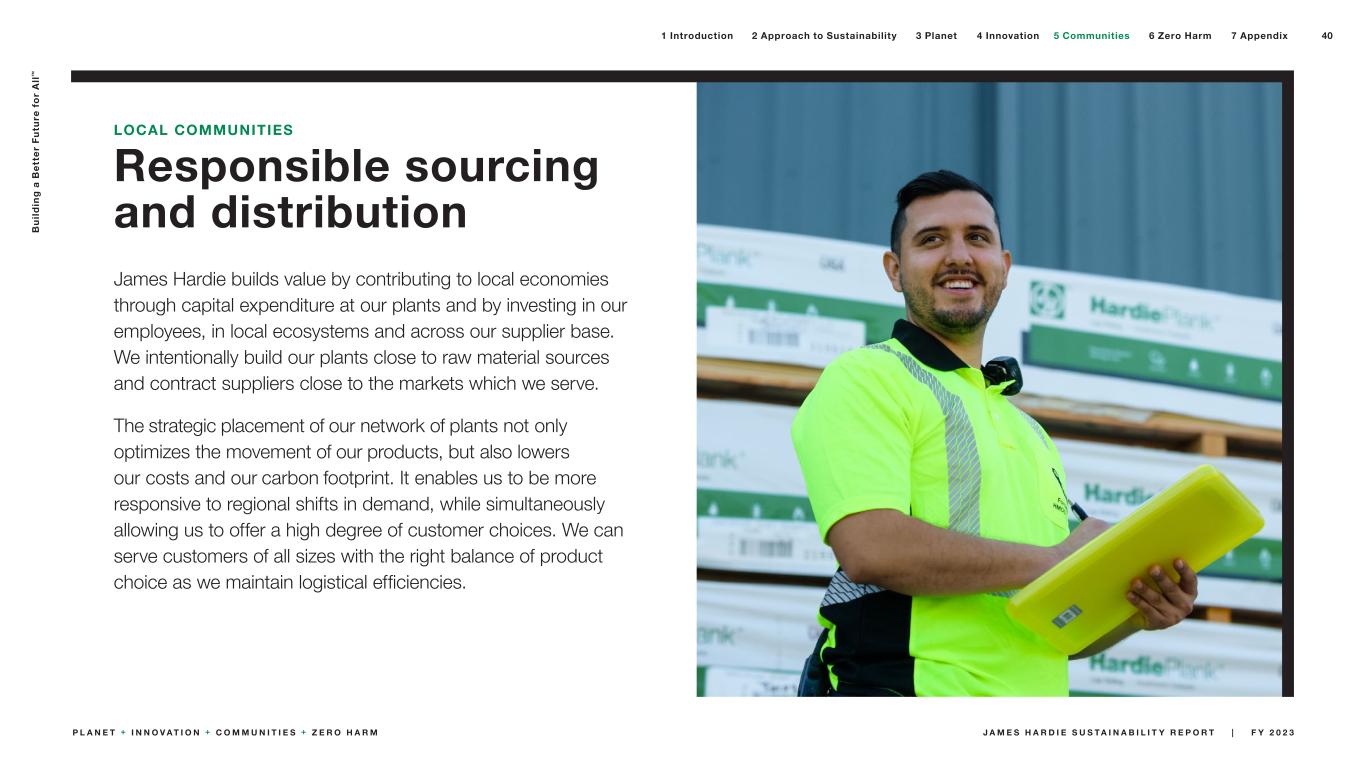
LOCAL COMMUNITIES Responsible sourcing and distribution James Hardie builds value by contributing to local economies through capital expenditure at our plants and by investing in our employees, in local ecosystems and across our supplier base. We intentionally build our plants close to raw material sources and contract suppliers close to the markets which we serve. The strategic placement of our network of plants not only optimizes the movement of our products, but also lowers our costs and our carbon footprint. It enables us to be more responsive to regional shifts in demand, while simultaneously allowing us to offer a high degree of customer choices. We can serve customers of all sizes with the right balance of product choice as we maintain logistical efficiencies. 40 B u il d in g a B e tt e r F u tu re f o r A ll ™ J A M E S H A R D I E S U S T A I N A B I L I T Y R E P O R T | F Y 2 0 2 3P L A N E T + I N N O V A T I O N + C O M M U N I T I E S + Z E R O H A R M 2 Approach to Sustainability 3 Planet 4 Innovation1 Introduction 5 Communities 6 Zero Harm 7 Appendix
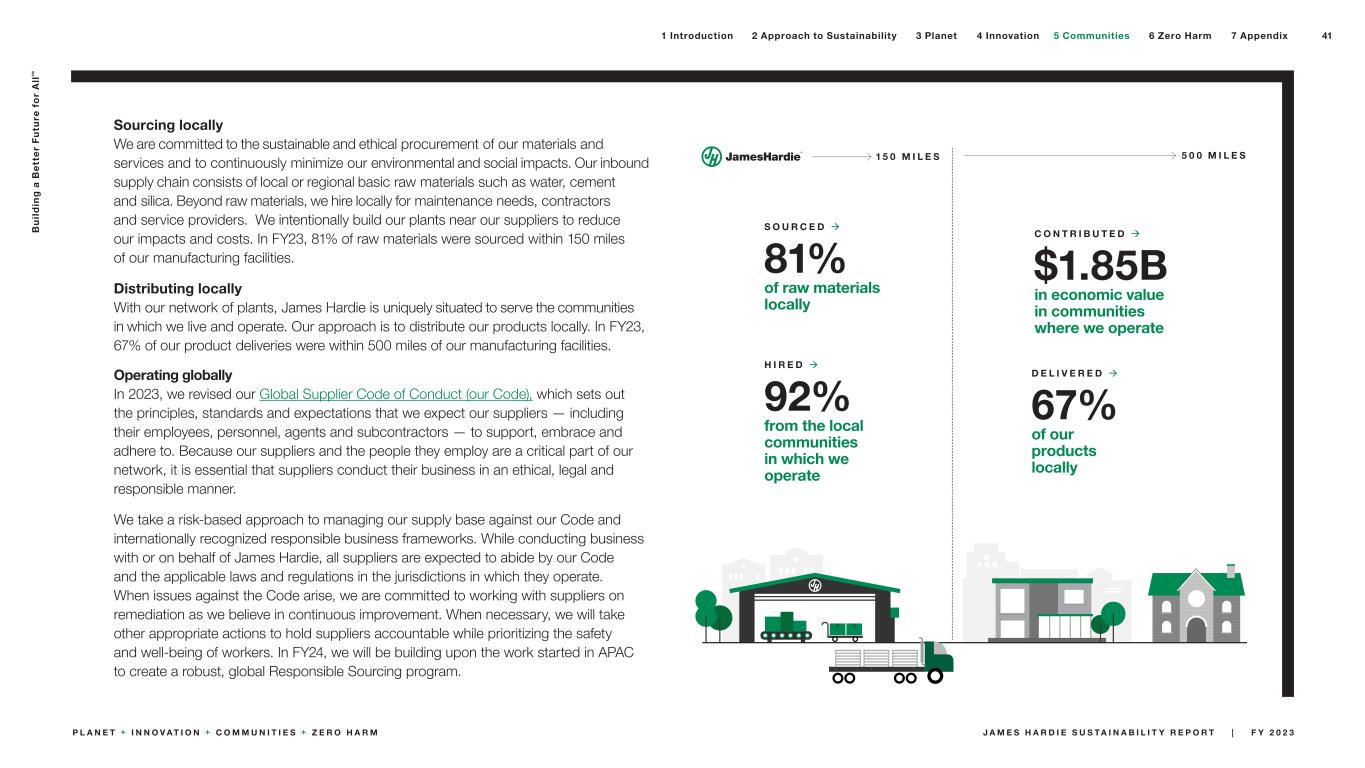
Sourcing locally We are committed to the sustainable and ethical procurement of our materials and services and to continuously minimize our environmental and social impacts. Our inbound supply chain consists of local or regional basic raw materials such as water, cement and silica. Beyond raw materials, we hire locally for maintenance needs, contractors and service providers. We intentionally build our plants near our suppliers to reduce our impacts and costs. In FY23, 81% of raw materials were sourced within 150 miles of our manufacturing facilities. Distributing locally With our network of plants, James Hardie is uniquely situated to serve the communities in which we live and operate. Our approach is to distribute our products locally. In FY23, 67% of our product deliveries were within 500 miles of our manufacturing facilities. Operating globally In 2023, we revised our Global Supplier Code of Conduct (our Code), which sets out the principles, standards and expectations that we expect our suppliers — including their employees, personnel, agents and subcontractors — to support, embrace and adhere to. Because our suppliers and the people they employ are a critical part of our network, it is essential that suppliers conduct their business in an ethical, legal and responsible manner. We take a risk-based approach to managing our supply base against our Code and internationally recognized responsible business frameworks. While conducting business with or on behalf of James Hardie, all suppliers are expected to abide by our Code and the applicable laws and regulations in the jurisdictions in which they operate. When issues against the Code arise, we are committed to working with suppliers on remediation as we believe in continuous improvement. When necessary, we will take other appropriate actions to hold suppliers accountable while prioritizing the safety and well-being of workers. In FY24, we will be building upon the work started in APAC to create a robust, global Responsible Sourcing program. C O N T R I B U T E D $1.85B in economic value in communities where we operate D E L I V E R E D 67% of our products locally 1 5 0 M I L E S 5 0 0 M I L E S H I R E D 92% from the local communities in which we operate S O U R C E D 81% of raw materials locally 41 B u il d in g a B e tt e r F u tu re f o r A ll ™ J A M E S H A R D I E S U S T A I N A B I L I T Y R E P O R T | F Y 2 0 2 3P L A N E T + I N N O V A T I O N + C O M M U N I T I E S + Z E R O H A R M 2 Approach to Sustainability 3 Planet 4 Innovation1 Introduction 5 Communities 6 Zero Harm 7 Appendix
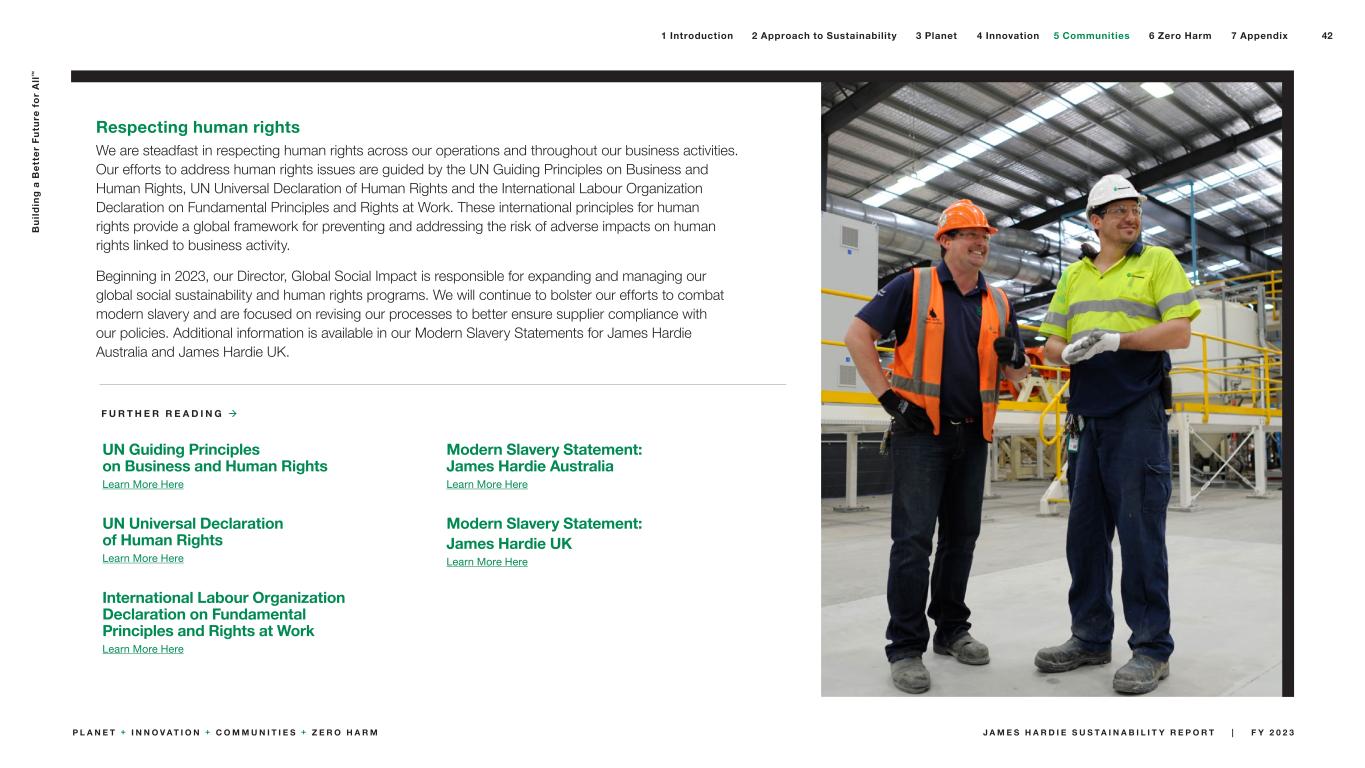
Respecting human rights We are steadfast in respecting human rights across our operations and throughout our business activities. Our efforts to address human rights issues are guided by the UN Guiding Principles on Business and Human Rights, UN Universal Declaration of Human Rights and the International Labour Organization Declaration on Fundamental Principles and Rights at Work. These international principles for human rights provide a global framework for preventing and addressing the risk of adverse impacts on human rights linked to business activity. Beginning in 2023, our Director, Global Social Impact is responsible for expanding and managing our global social sustainability and human rights programs. We will continue to bolster our efforts to combat modern slavery and are focused on revising our processes to better ensure supplier compliance with our policies. Additional information is available in our Modern Slavery Statements for James Hardie Australia and James Hardie UK. UN Guiding Principles on Business and Human Rights Learn More Here UN Universal Declaration of Human Rights Learn More Here International Labour Organization Declaration on Fundamental Principles and Rights at Work Learn More Here Modern Slavery Statement: James Hardie Australia Learn More Here Modern Slavery Statement: James Hardie UK Learn More Here F U R T H E R R E A D I N G 42 B u il d in g a B e tt e r F u tu re f o r A ll ™ J A M E S H A R D I E S U S T A I N A B I L I T Y R E P O R T | F Y 2 0 2 3P L A N E T + I N N O V A T I O N + C O M M U N I T I E S + Z E R O H A R M 2 Approach to Sustainability 3 Planet 4 Innovation1 Introduction 5 Communities 6 Zero Harm 7 Appendix
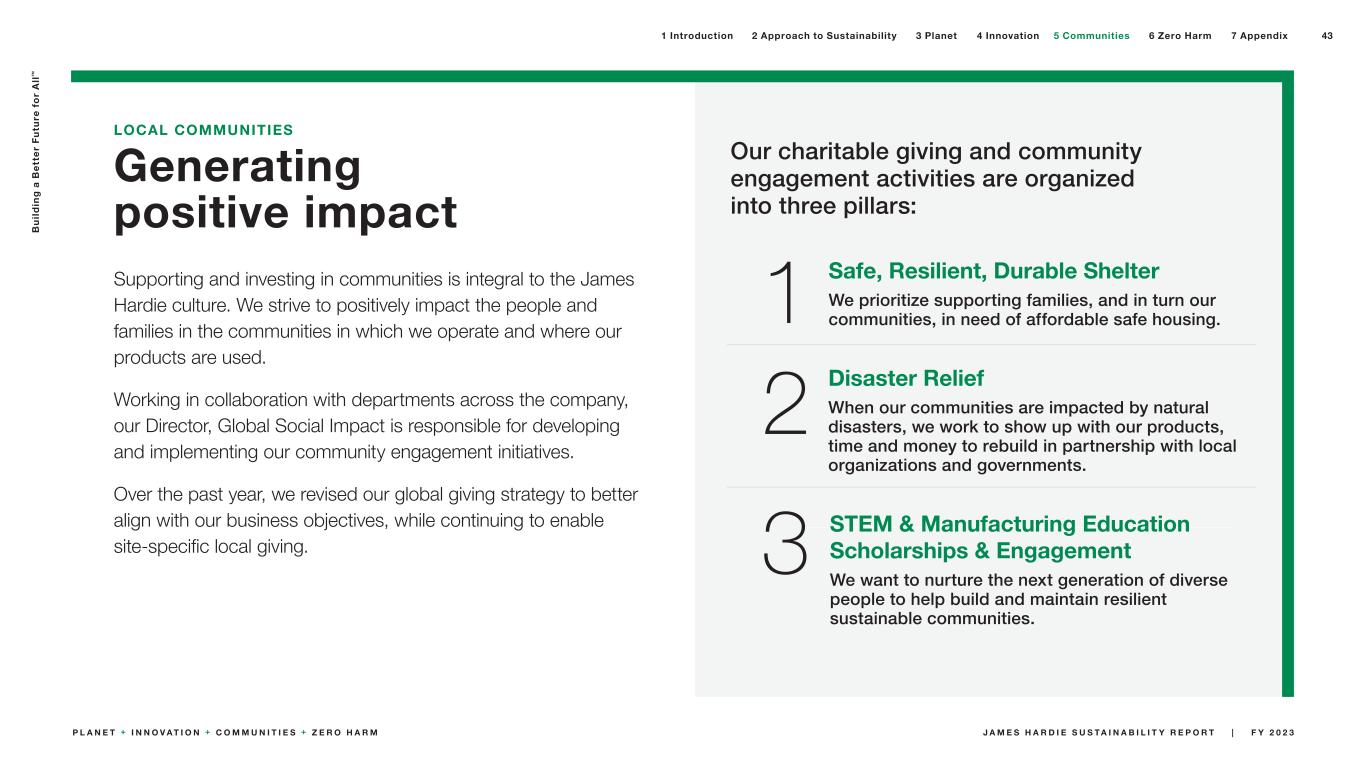
LOCAL COMMUNITIES Generating positive impact Supporting and investing in communities is integral to the James Hardie culture. We strive to positively impact the people and families in the communities in which we operate and where our products are used. Working in collaboration with departments across the company, our Director, Global Social Impact is responsible for developing and implementing our community engagement initiatives. Over the past year, we revised our global giving strategy to better align with our business objectives, while continuing to enable site-specific local giving. Our charitable giving and community engagement activities are organized into three pillars: Safe, Resilient, Durable Shelter We prioritize supporting families, and in turn our communities, in need of affordable safe housing. Disaster Relief When our communities are impacted by natural disasters, we work to show up with our products, time and money to rebuild in partnership with local organizations and governments. STEM & Manufacturing Education Scholarships & Engagement We want to nurture the next generation of diverse people to help build and maintain resilient sustainable communities. 1 2 3 43 B u il d in g a B e tt e r F u tu re f o r A ll ™ J A M E S H A R D I E S U S T A I N A B I L I T Y R E P O R T | F Y 2 0 2 3P L A N E T + I N N O V A T I O N + C O M M U N I T I E S + Z E R O H A R M 2 Approach to Sustainability 3 Planet 4 Innovation1 Introduction 5 Communities 6 Zero Harm 7 Appendix
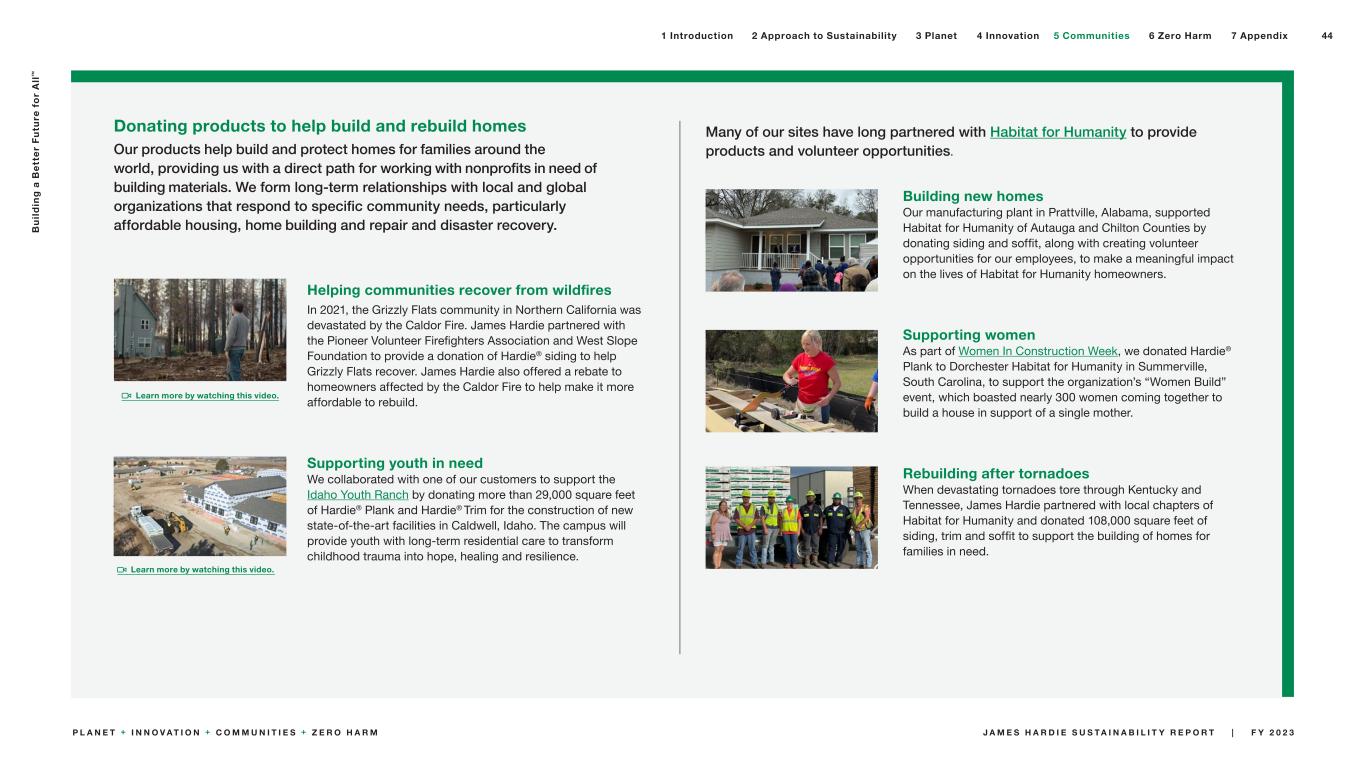
Learn more by watching this video. Learn more by watching this video. Donating products to help build and rebuild homes Our products help build and protect homes for families around the world, providing us with a direct path for working with nonprofits in need of building materials. We form long-term relationships with local and global organizations that respond to specific community needs, particularly affordable housing, home building and repair and disaster recovery. Helping communities recover from wildfires In 2021, the Grizzly Flats community in Northern California was devastated by the Caldor Fire. James Hardie partnered with the Pioneer Volunteer Firefighters Association and West Slope Foundation to provide a donation of Hardie® siding to help Grizzly Flats recover. James Hardie also offered a rebate to homeowners affected by the Caldor Fire to help make it more affordable to rebuild. Supporting youth in need We collaborated with one of our customers to support the Idaho Youth Ranch by donating more than 29,000 square feet of Hardie® Plank and Hardie® Trim for the construction of new state-of-the-art facilities in Caldwell, Idaho. The campus will provide youth with long-term residential care to transform childhood trauma into hope, healing and resilience. Many of our sites have long partnered with Habitat for Humanity to provide products and volunteer opportunities. Building new homes Our manufacturing plant in Prattville, Alabama, supported Habitat for Humanity of Autauga and Chilton Counties by donating siding and soffit, along with creating volunteer opportunities for our employees, to make a meaningful impact on the lives of Habitat for Humanity homeowners. Supporting women As part of Women In Construction Week, we donated Hardie® Plank to Dorchester Habitat for Humanity in Summerville, South Carolina, to support the organization’s “Women Build” event, which boasted nearly 300 women coming together to build a house in support of a single mother. Rebuilding after tornadoes When devastating tornadoes tore through Kentucky and Tennessee, James Hardie partnered with local chapters of Habitat for Humanity and donated 108,000 square feet of siding, trim and soffit to support the building of homes for families in need. 44 B u il d in g a B e tt e r F u tu re f o r A ll ™ J A M E S H A R D I E S U S T A I N A B I L I T Y R E P O R T | F Y 2 0 2 3P L A N E T + I N N O V A T I O N + C O M M U N I T I E S + Z E R O H A R M 2 Approach to Sustainability 3 Planet 4 Innovation1 Introduction 5 Communities 6 Zero Harm 7 Appendix
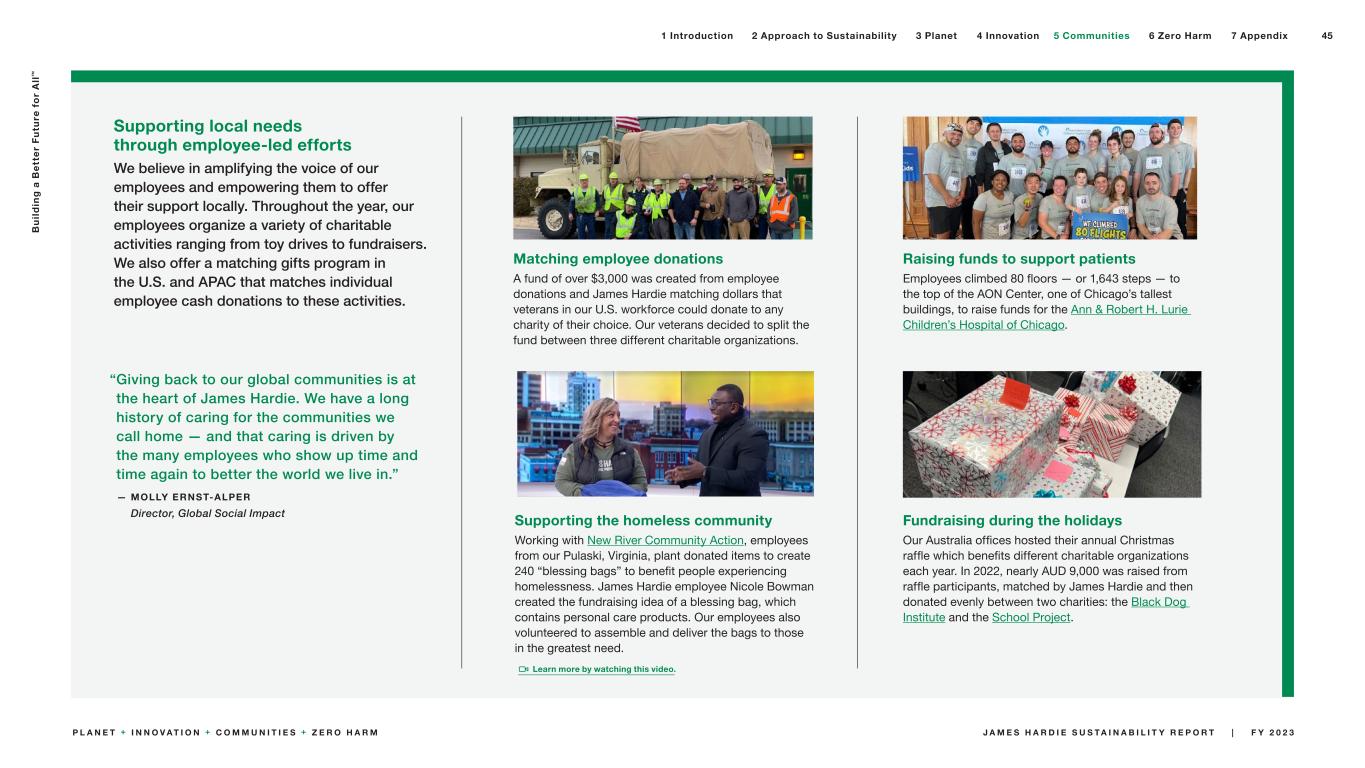
“ Giving back to our global communities is at the heart of James Hardie. We have a long history of caring for the communities we call home — and that caring is driven by the many employees who show up time and time again to better the world we live in.” — MOLLY ERNST-ALPER Director, Global Social Impact Learn more by watching this video. Supporting local needs through employee-led efforts We believe in amplifying the voice of our employees and empowering them to offer their support locally. Throughout the year, our employees organize a variety of charitable activities ranging from toy drives to fundraisers. We also offer a matching gifts program in the U.S. and APAC that matches individual employee cash donations to these activities. Matching employee donations A fund of over $3,000 was created from employee donations and James Hardie matching dollars that veterans in our U.S. workforce could donate to any charity of their choice. Our veterans decided to split the fund between three different charitable organizations. Fundraising during the holidays Our Australia offices hosted their annual Christmas raffle which benefits different charitable organizations each year. In 2022, nearly AUD 9,000 was raised from raffle participants, matched by James Hardie and then donated evenly between two charities: the Black Dog Institute and the School Project. Raising funds to support patients Employees climbed 80 floors — or 1,643 steps — to the top of the AON Center, one of Chicago’s tallest buildings, to raise funds for the Ann & Robert H. Lurie Children’s Hospital of Chicago. Supporting the homeless community Working with New River Community Action, employees from our Pulaski, Virginia, plant donated items to create 240 “blessing bags” to benefit people experiencing homelessness. James Hardie employee Nicole Bowman created the fundraising idea of a blessing bag, which contains personal care products. Our employees also volunteered to assemble and deliver the bags to those in the greatest need. 45 B u il d in g a B e tt e r F u tu re f o r A ll ™ J A M E S H A R D I E S U S T A I N A B I L I T Y R E P O R T | F Y 2 0 2 3P L A N E T + I N N O V A T I O N + C O M M U N I T I E S + Z E R O H A R M 2 Approach to Sustainability 3 Planet 4 Innovation1 Introduction 5 Communities 6 Zero Harm 7 Appendix
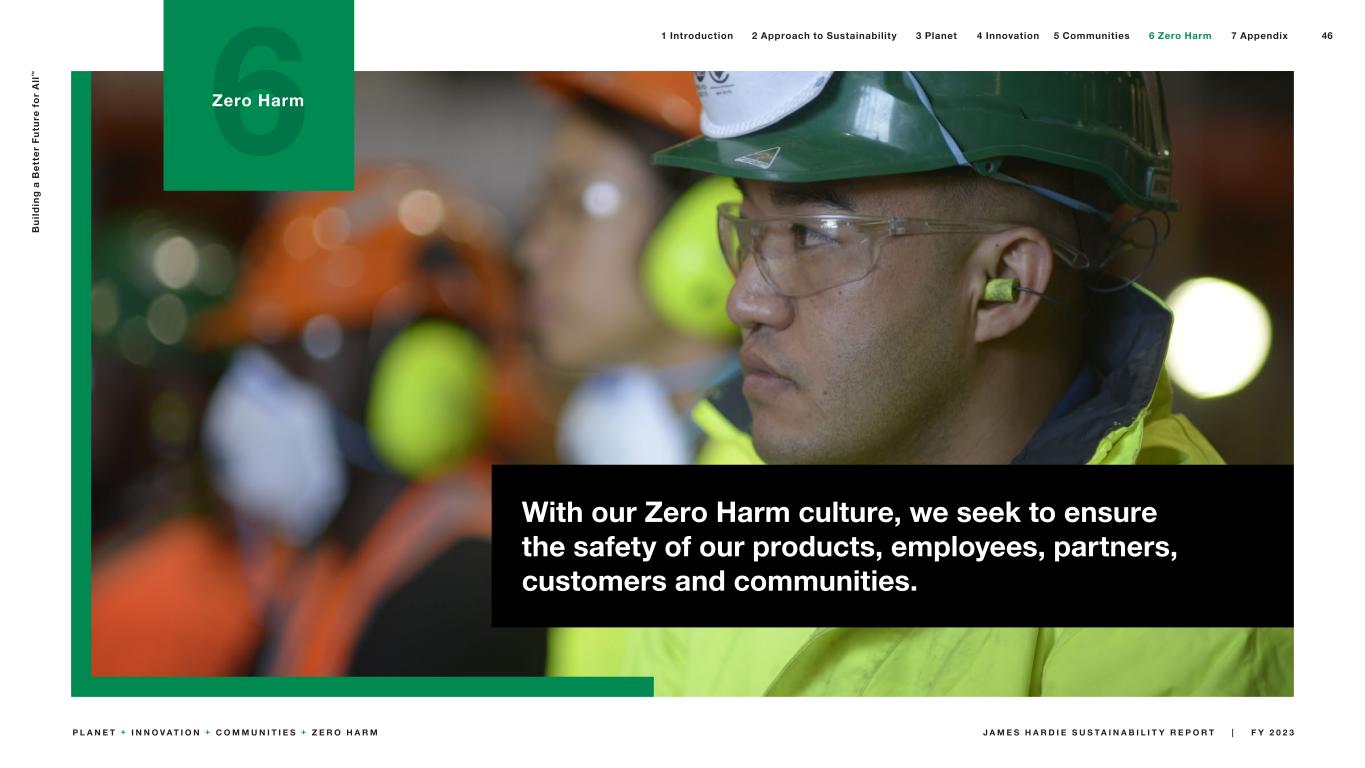
6Zero Harm With our Zero Harm culture, we seek to ensure the safety of our products, employees, partners, customers and communities. 46 B u il d in g a B e tt e r F u tu re f o r A ll ™ J A M E S H A R D I E S U S T A I N A B I L I T Y R E P O R T | F Y 2 0 2 3P L A N E T + I N N O V A T I O N + C O M M U N I T I E S + Z E R O H A R M 2 Approach to Sustainability 3 Planet 4 Innovation1 Introduction 5 Communities 6 Zero Harm 7 Appendix
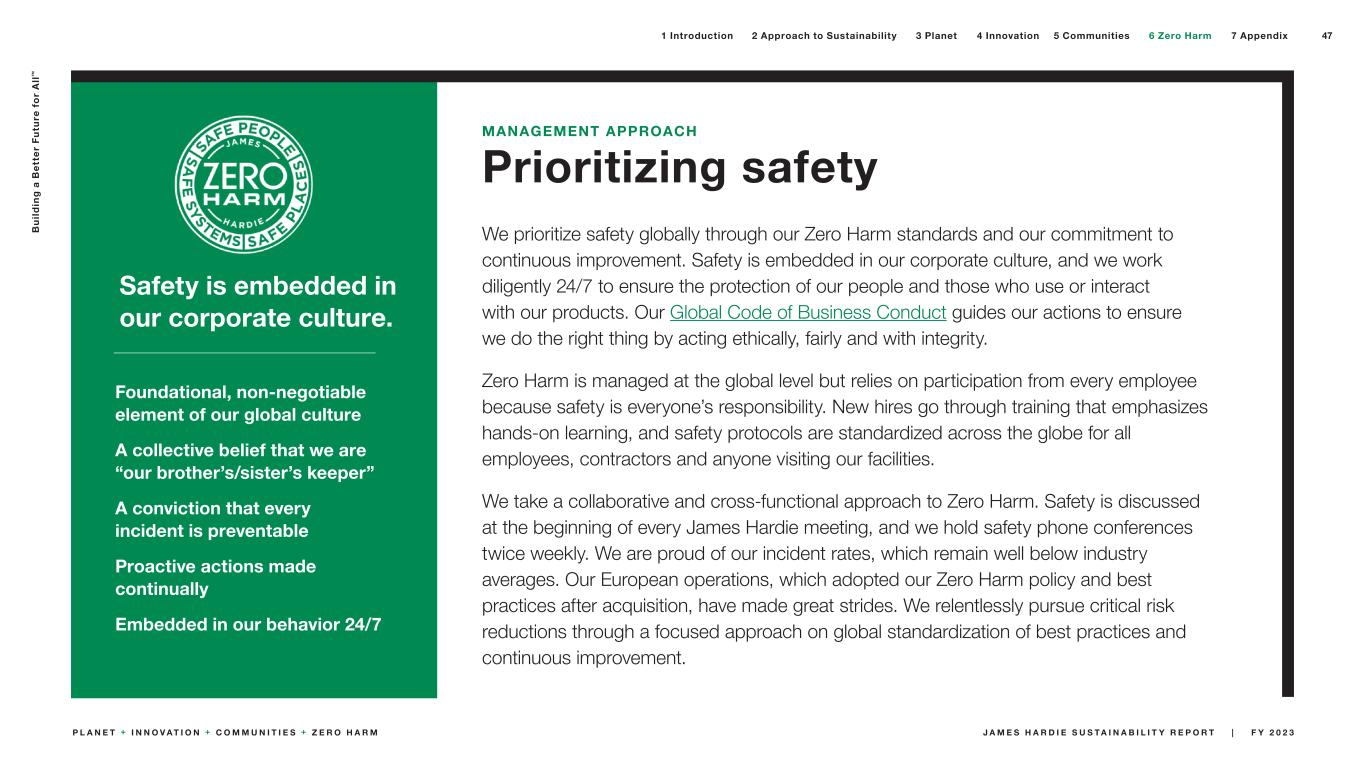
Safety is embedded in our corporate culture. Foundational, non-negotiable element of our global culture A collective belief that we are “our brother’s/sister’s keeper” A conviction that every incident is preventable Proactive actions made continually Embedded in our behavior 24/7 MANAGEMENT APPROACH Prioritizing safety We prioritize safety globally through our Zero Harm standards and our commitment to continuous improvement. Safety is embedded in our corporate culture, and we work diligently 24/7 to ensure the protection of our people and those who use or interact with our products. Our Global Code of Business Conduct guides our actions to ensure we do the right thing by acting ethically, fairly and with integrity. Zero Harm is managed at the global level but relies on participation from every employee because safety is everyone’s responsibility. New hires go through training that emphasizes hands-on learning, and safety protocols are standardized across the globe for all employees, contractors and anyone visiting our facilities. We take a collaborative and cross-functional approach to Zero Harm. Safety is discussed at the beginning of every James Hardie meeting, and we hold safety phone conferences twice weekly. We are proud of our incident rates, which remain well below industry averages. Our European operations, which adopted our Zero Harm policy and best practices after acquisition, have made great strides. We relentlessly pursue critical risk reductions through a focused approach on global standardization of best practices and continuous improvement. 47 B u il d in g a B e tt e r F u tu re f o r A ll ™ J A M E S H A R D I E S U S T A I N A B I L I T Y R E P O R T | F Y 2 0 2 3P L A N E T + I N N O V A T I O N + C O M M U N I T I E S + Z E R O H A R M 2 Approach to Sustainability 3 Planet 4 Innovation1 Introduction 5 Communities 6 Zero Harm 7 Appendix
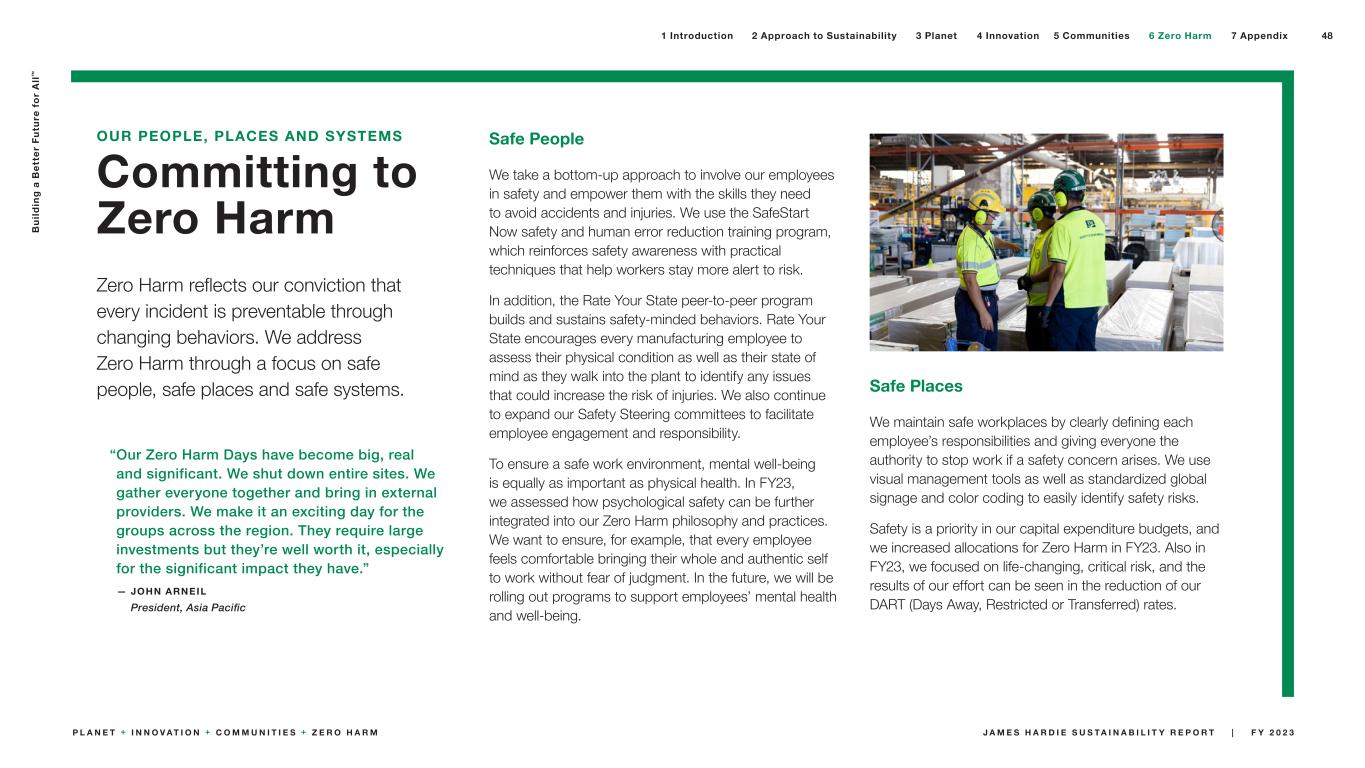
OUR PEOPLE, PLACES AND SYSTEMS Committing to Zero Harm Zero Harm reflects our conviction that every incident is preventable through changing behaviors. We address Zero Harm through a focus on safe people, safe places and safe systems. “ Our Zero Harm Days have become big, real and significant. We shut down entire sites. We gather everyone together and bring in external providers. We make it an exciting day for the groups across the region. They require large investments but they’re well worth it, especially for the significant impact they have.” — JOHN ARNEIL President, Asia Pacific Safe People We take a bottom-up approach to involve our employees in safety and empower them with the skills they need to avoid accidents and injuries. We use the SafeStart Now safety and human error reduction training program, which reinforces safety awareness with practical techniques that help workers stay more alert to risk. In addition, the Rate Your State peer-to-peer program builds and sustains safety-minded behaviors. Rate Your State encourages every manufacturing employee to assess their physical condition as well as their state of mind as they walk into the plant to identify any issues that could increase the risk of injuries. We also continue to expand our Safety Steering committees to facilitate employee engagement and responsibility. To ensure a safe work environment, mental well-being is equally as important as physical health. In FY23, we assessed how psychological safety can be further integrated into our Zero Harm philosophy and practices. We want to ensure, for example, that every employee feels comfortable bringing their whole and authentic self to work without fear of judgment. In the future, we will be rolling out programs to support employees’ mental health and well-being. Safe Places We maintain safe workplaces by clearly defining each employee’s responsibilities and giving everyone the authority to stop work if a safety concern arises. We use visual management tools as well as standardized global signage and color coding to easily identify safety risks. Safety is a priority in our capital expenditure budgets, and we increased allocations for Zero Harm in FY23. Also in FY23, we focused on life-changing, critical risk, and the results of our effort can be seen in the reduction of our DART (Days Away, Restricted or Transferred) rates. 48 B u il d in g a B e tt e r F u tu re f o r A ll ™ J A M E S H A R D I E S U S T A I N A B I L I T Y R E P O R T | F Y 2 0 2 3P L A N E T + I N N O V A T I O N + C O M M U N I T I E S + Z E R O H A R M 2 Approach to Sustainability 3 Planet 4 Innovation1 Introduction 5 Communities 6 Zero Harm 7 Appendix
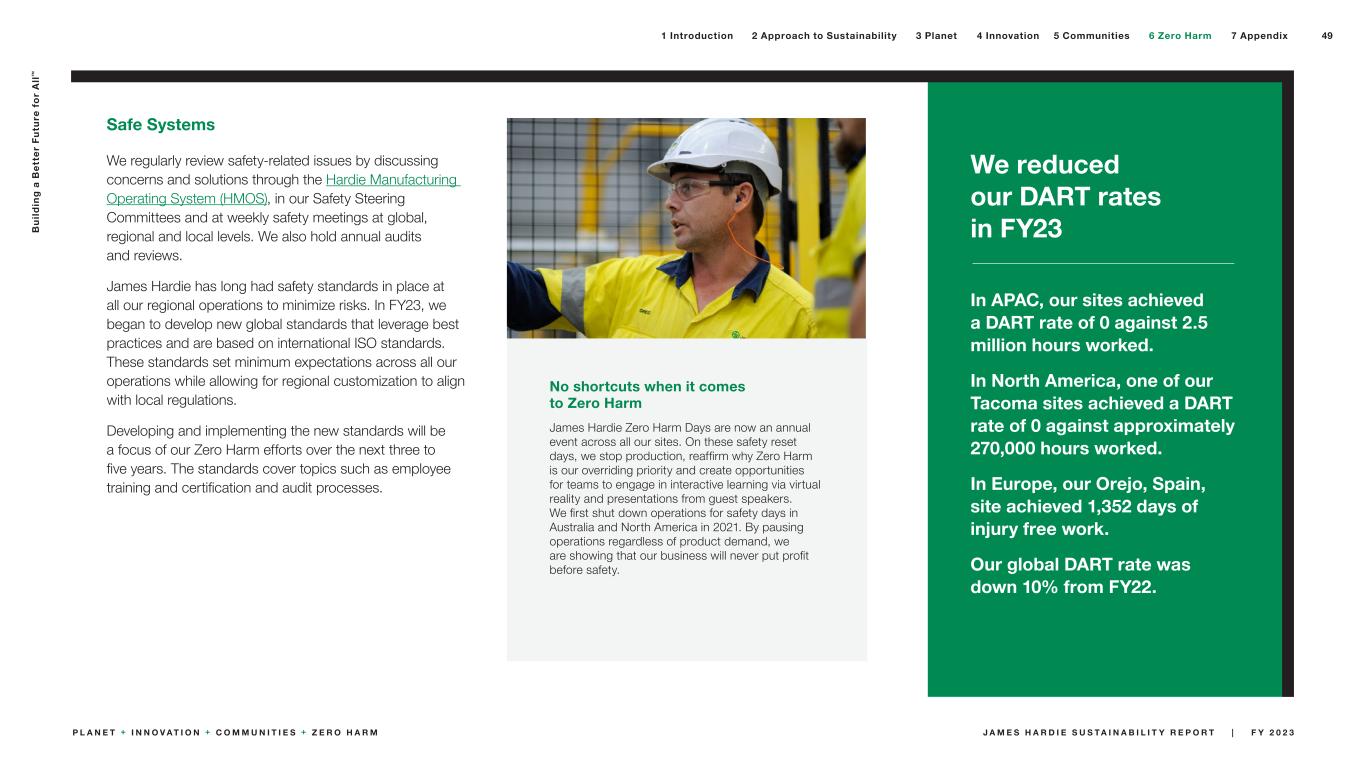
We reduced our DART rates in FY23 In APAC, our sites achieved a DART rate of 0 against 2.5 million hours worked. In North America, one of our Tacoma sites achieved a DART rate of 0 against approximately 270,000 hours worked. In Europe, our Orejo, Spain, site achieved 1,352 days of injury free work. Our global DART rate was down 10% from FY22. No shortcuts when it comes to Zero Harm James Hardie Zero Harm Days are now an annual event across all our sites. On these safety reset days, we stop production, reaffirm why Zero Harm is our overriding priority and create opportunities for teams to engage in interactive learning via virtual reality and presentations from guest speakers. We first shut down operations for safety days in Australia and North America in 2021. By pausing operations regardless of product demand, we are showing that our business will never put profit before safety. Safe Systems We regularly review safety-related issues by discussing concerns and solutions through the Hardie Manufacturing Operating System (HMOS), in our Safety Steering Committees and at weekly safety meetings at global, regional and local levels. We also hold annual audits and reviews. James Hardie has long had safety standards in place at all our regional operations to minimize risks. In FY23, we began to develop new global standards that leverage best practices and are based on international ISO standards. These standards set minimum expectations across all our operations while allowing for regional customization to align with local regulations. Developing and implementing the new standards will be a focus of our Zero Harm efforts over the next three to five years. The standards cover topics such as employee training and certification and audit processes. 49 B u il d in g a B e tt e r F u tu re f o r A ll ™ J A M E S H A R D I E S U S T A I N A B I L I T Y R E P O R T | F Y 2 0 2 3P L A N E T + I N N O V A T I O N + C O M M U N I T I E S + Z E R O H A R M 2 Approach to Sustainability 3 Planet 4 Innovation1 Introduction 5 Communities 6 Zero Harm 7 Appendix
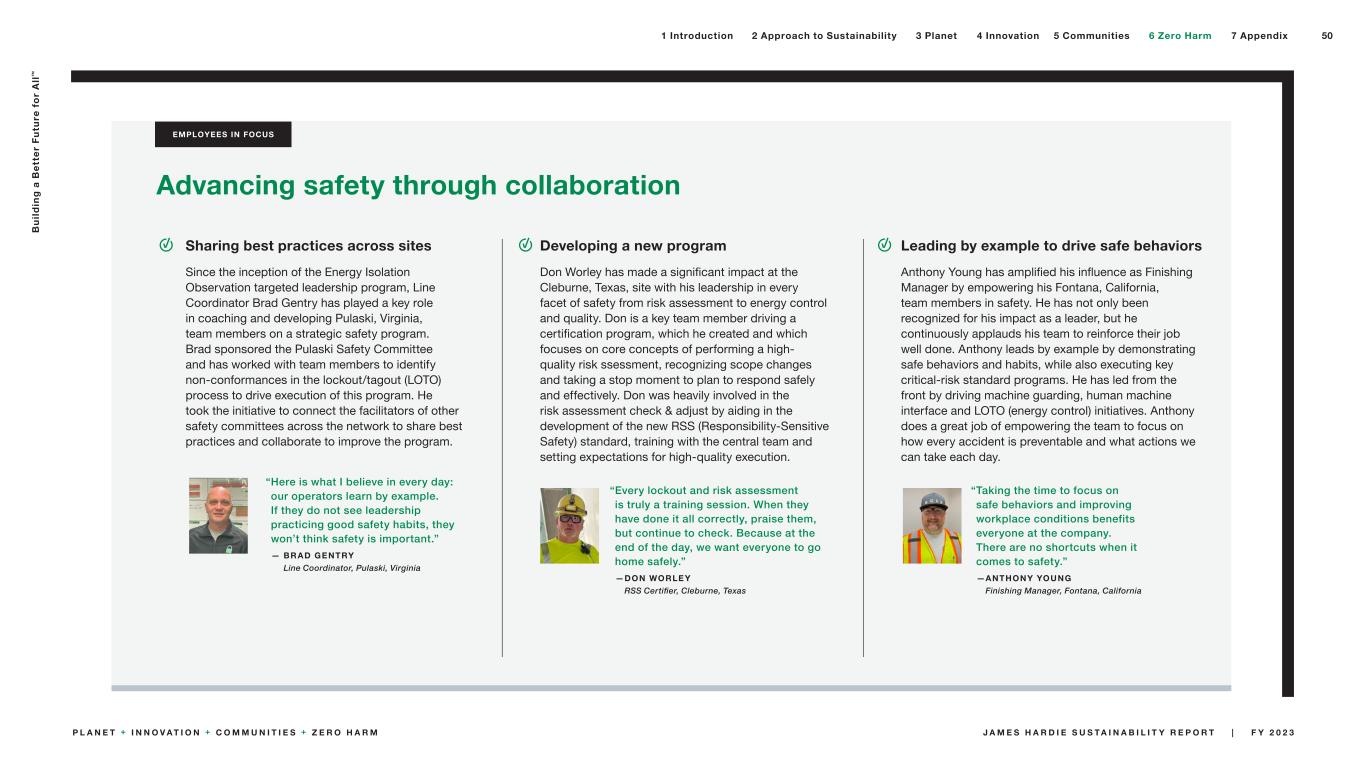
Advancing safety through collaboration Developing a new program Don Worley has made a significant impact at the Cleburne, Texas, site with his leadership in every facet of safety from risk assessment to energy control and quality. Don is a key team member driving a certification program, which he created and which focuses on core concepts of performing a high- quality risk ssessment, recognizing scope changes and taking a stop moment to plan to respond safely and effectively. Don was heavily involved in the risk assessment check & adjust by aiding in the development of the new RSS (Responsibility-Sensitive Safety) standard, training with the central team and setting expectations for high-quality execution. EMPLOYEES IN FOCUS Leading by example to drive safe behaviors Anthony Young has amplified his influence as Finishing Manager by empowering his Fontana, California, team members in safety. He has not only been recognized for his impact as a leader, but he continuously applauds his team to reinforce their job well done. Anthony leads by example by demonstrating safe behaviors and habits, while also executing key critical-risk standard programs. He has led from the front by driving machine guarding, human machine interface and LOTO (energy control) initiatives. Anthony does a great job of empowering the team to focus on how every accident is preventable and what actions we can take each day. Sharing best practices across sites Since the inception of the Energy Isolation Observation targeted leadership program, Line Coordinator Brad Gentry has played a key role in coaching and developing Pulaski, Virginia, team members on a strategic safety program. Brad sponsored the Pulaski Safety Committee and has worked with team members to identify non-conformances in the lockout/tagout (LOTO) process to drive execution of this program. He took the initiative to connect the facilitators of other safety committees across the network to share best practices and collaborate to improve the program. “ Here is what I believe in every day: our operators learn by example. If they do not see leadership practicing good safety habits, they won’t think safety is important.” — BR AD GENTRY Line Coordinator, Pulaski, Virginia “ Every lockout and risk assessment is truly a training session. When they have done it all correctly, praise them, but continue to check. Because at the end of the day, we want everyone to go home safely.” — DON WORLE Y RSS Certifier, Cleburne, Texas “ Taking the time to focus on safe behaviors and improving workplace conditions benefits everyone at the company. There are no shortcuts when it comes to safety.” — ANTHONY YOUNG Finishing Manager, Fontana, California 50 B u il d in g a B e tt e r F u tu re f o r A ll ™ J A M E S H A R D I E S U S T A I N A B I L I T Y R E P O R T | F Y 2 0 2 3P L A N E T + I N N O V A T I O N + C O M M U N I T I E S + Z E R O H A R M 2 Approach to Sustainability 3 Planet 4 Innovation1 Introduction 5 Communities 6 Zero Harm 7 Appendix
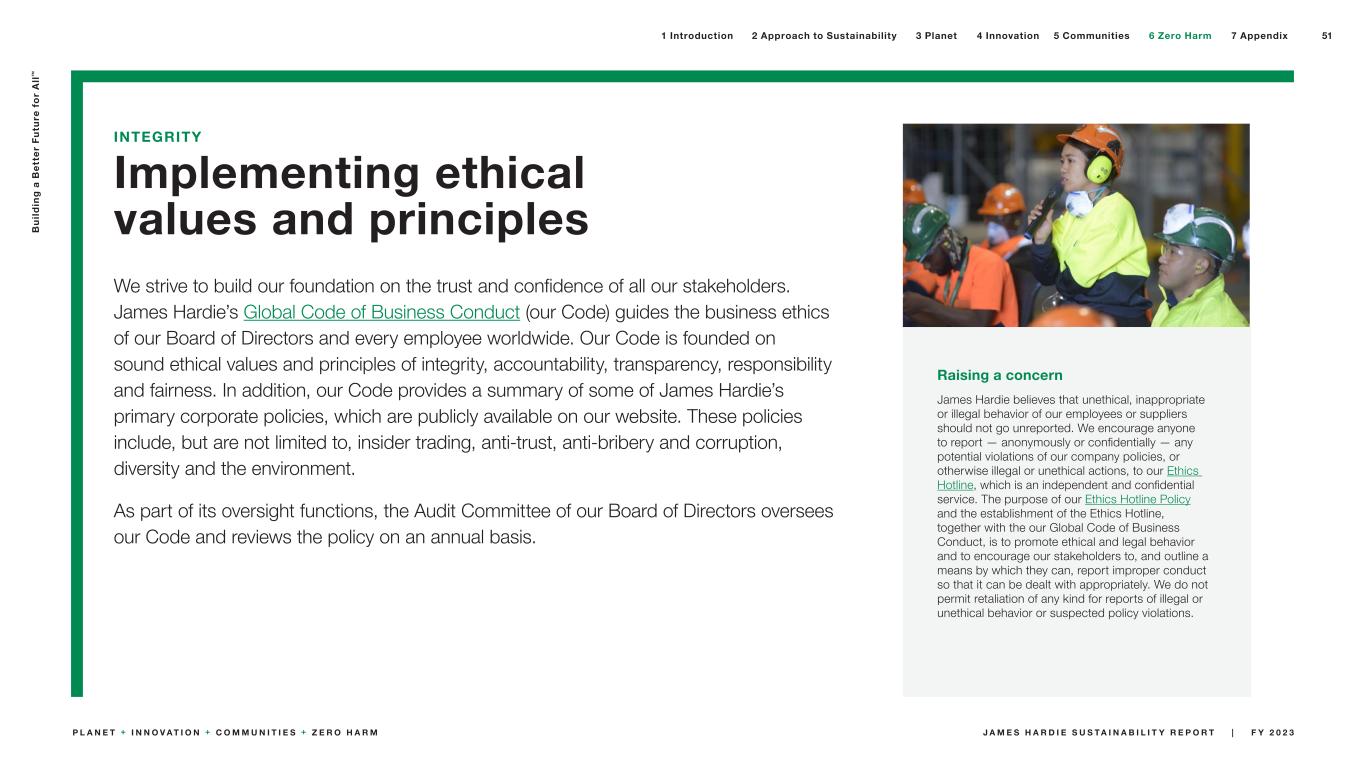
INTEGRITY Implementing ethical values and principles We strive to build our foundation on the trust and confidence of all our stakeholders. James Hardie’s Global Code of Business Conduct (our Code) guides the business ethics of our Board of Directors and every employee worldwide. Our Code is founded on sound ethical values and principles of integrity, accountability, transparency, responsibility and fairness. In addition, our Code provides a summary of some of James Hardie’s primary corporate policies, which are publicly available on our website. These policies include, but are not limited to, insider trading, anti-trust, anti-bribery and corruption, diversity and the environment. As part of its oversight functions, the Audit Committee of our Board of Directors oversees our Code and reviews the policy on an annual basis. Raising a concern James Hardie believes that unethical, inappropriate or illegal behavior of our employees or suppliers should not go unreported. We encourage anyone to report — anonymously or confidentially — any potential violations of our company policies, or otherwise illegal or unethical actions, to our Ethics Hotline, which is an independent and confidential service. The purpose of our Ethics Hotline Policy and the establishment of the Ethics Hotline, together with the our Global Code of Business Conduct, is to promote ethical and legal behavior and to encourage our stakeholders to, and outline a means by which they can, report improper conduct so that it can be dealt with appropriately. We do not permit retaliation of any kind for reports of illegal or unethical behavior or suspected policy violations. 51 B u il d in g a B e tt e r F u tu re f o r A ll ™ J A M E S H A R D I E S U S T A I N A B I L I T Y R E P O R T | F Y 2 0 2 3P L A N E T + I N N O V A T I O N + C O M M U N I T I E S + Z E R O H A R M 2 Approach to Sustainability 3 Planet 4 Innovation1 Introduction 5 Communities 6 Zero Harm 7 Appendix
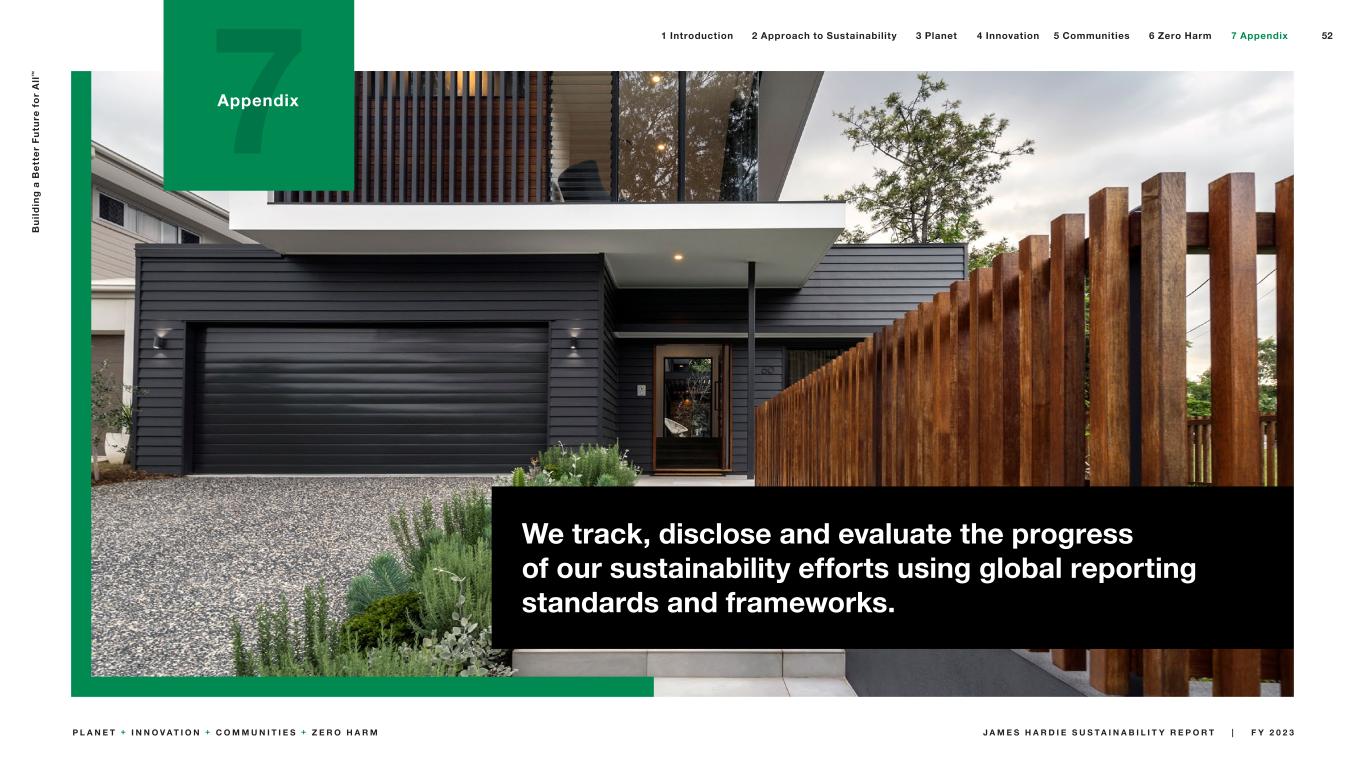
7Appendix We track, disclose and evaluate the progress of our sustainability efforts using global reporting standards and frameworks. 52 B u il d in g a B e tt e r F u tu re f o r A ll ™ J A M E S H A R D I E S U S T A I N A B I L I T Y R E P O R T | F Y 2 0 2 3P L A N E T + I N N O V A T I O N + C O M M U N I T I E S + Z E R O H A R M 2 Approach to Sustainability 3 Planet 4 Innovation1 Introduction 5 Communities 6 Zero Harm 7 Appendix
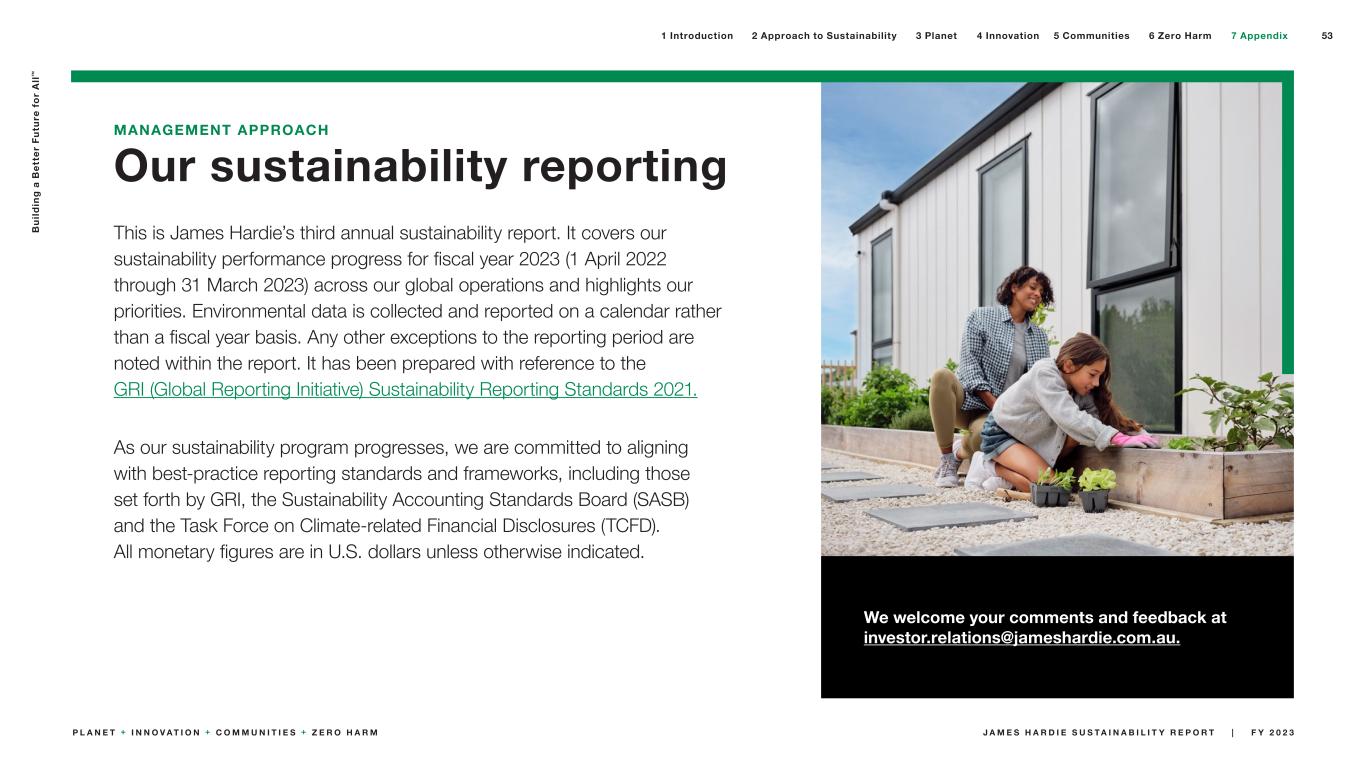
MANAGEMENT APPROACH Our sustainability reporting This is James Hardie’s third annual sustainability report. It covers our sustainability performance progress for fiscal year 2023 (1 April 2022 through 31 March 2023) across our global operations and highlights our priorities. Environmental data is collected and reported on a calendar rather than a fiscal year basis. Any other exceptions to the reporting period are noted within the report. It has been prepared with reference to the GRI (Global Reporting Initiative) Sustainability Reporting Standards 2021. As our sustainability program progresses, we are committed to aligning with best-practice reporting standards and frameworks, including those set forth by GRI, the Sustainability Accounting Standards Board (SASB) and the Task Force on Climate-related Financial Disclosures (TCFD). All monetary figures are in U.S. dollars unless otherwise indicated. We welcome your comments and feedback at [email protected]. 53 B u il d in g a B e tt e r F u tu re f o r A ll ™ J A M E S H A R D I E S U S T A I N A B I L I T Y R E P O R T | F Y 2 0 2 3P L A N E T + I N N O V A T I O N + C O M M U N I T I E S + Z E R O H A R M 2 Approach to Sustainability 3 Planet 4 Innovation1 Introduction 5 Communities 6 Zero Harm 7 Appendix
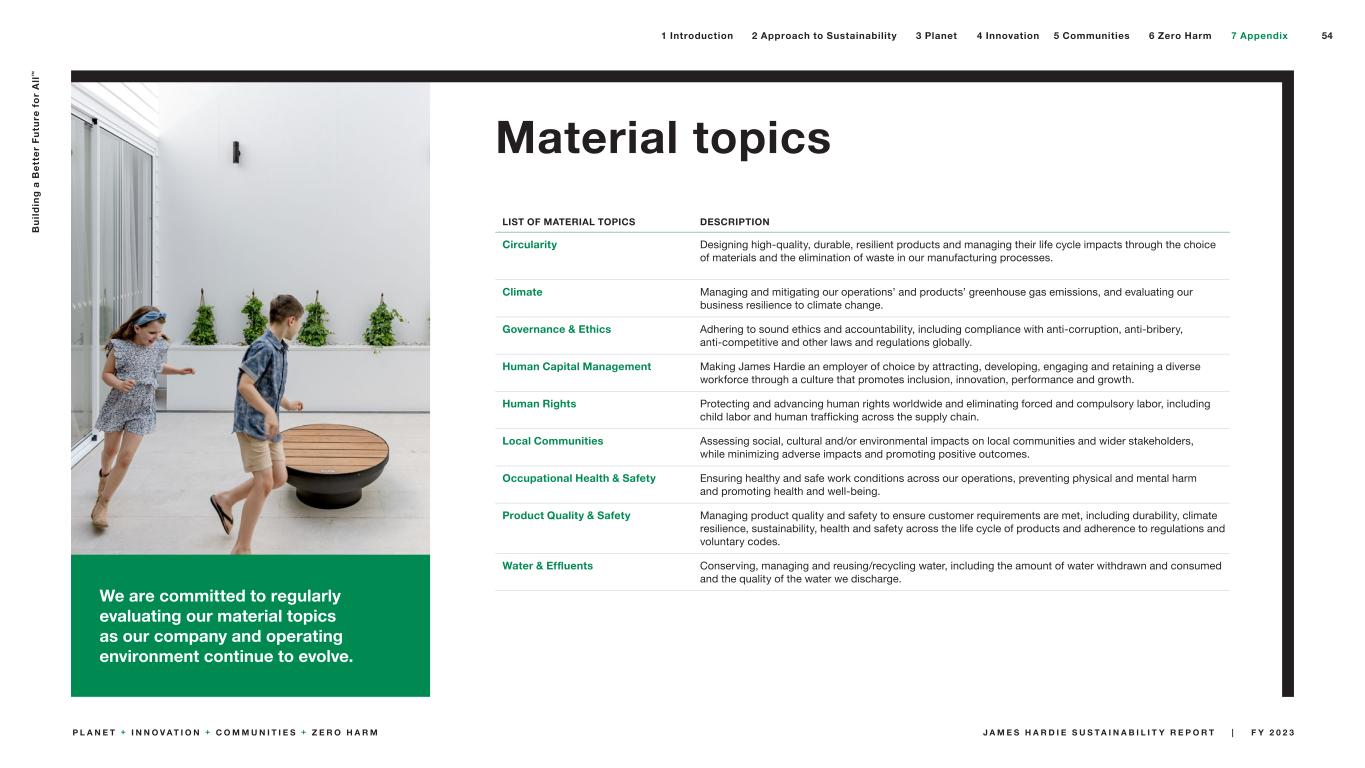
Material topics LIST OF MATERIAL TOPICS DESCRIPTION Circularity Designing high-quality, durable, resilient products and managing their life cycle impacts through the choice of materials and the elimination of waste in our manufacturing processes. Climate Managing and mitigating our operations’ and products’ greenhouse gas emissions, and evaluating our business resilience to climate change. Governance & Ethics Adhering to sound ethics and accountability, including compliance with anti-corruption, anti-bribery, anti-competitive and other laws and regulations globally. Human Capital Management Making James Hardie an employer of choice by attracting, developing, engaging and retaining a diverse workforce through a culture that promotes inclusion, innovation, performance and growth. Human Rights Protecting and advancing human rights worldwide and eliminating forced and compulsory labor, including child labor and human trafficking across the supply chain. Local Communities Assessing social, cultural and/or environmental impacts on local communities and wider stakeholders, while minimizing adverse impacts and promoting positive outcomes. Occupational Health & Safety Ensuring healthy and safe work conditions across our operations, preventing physical and mental harm and promoting health and well-being. Product Quality & Safety Managing product quality and safety to ensure customer requirements are met, including durability, climate resilience, sustainability, health and safety across the life cycle of products and adherence to regulations and voluntary codes. Water & Effluents Conserving, managing and reusing/recycling water, including the amount of water withdrawn and consumed and the quality of the water we discharge. We are committed to regularly evaluating our material topics as our company and operating environment continue to evolve. 54 B u il d in g a B e tt e r F u tu re f o r A ll ™ J A M E S H A R D I E S U S T A I N A B I L I T Y R E P O R T | F Y 2 0 2 3P L A N E T + I N N O V A T I O N + C O M M U N I T I E S + Z E R O H A R M 2 Approach to Sustainability 3 Planet 4 Innovation1 Introduction 5 Communities 6 Zero Harm 7 Appendix
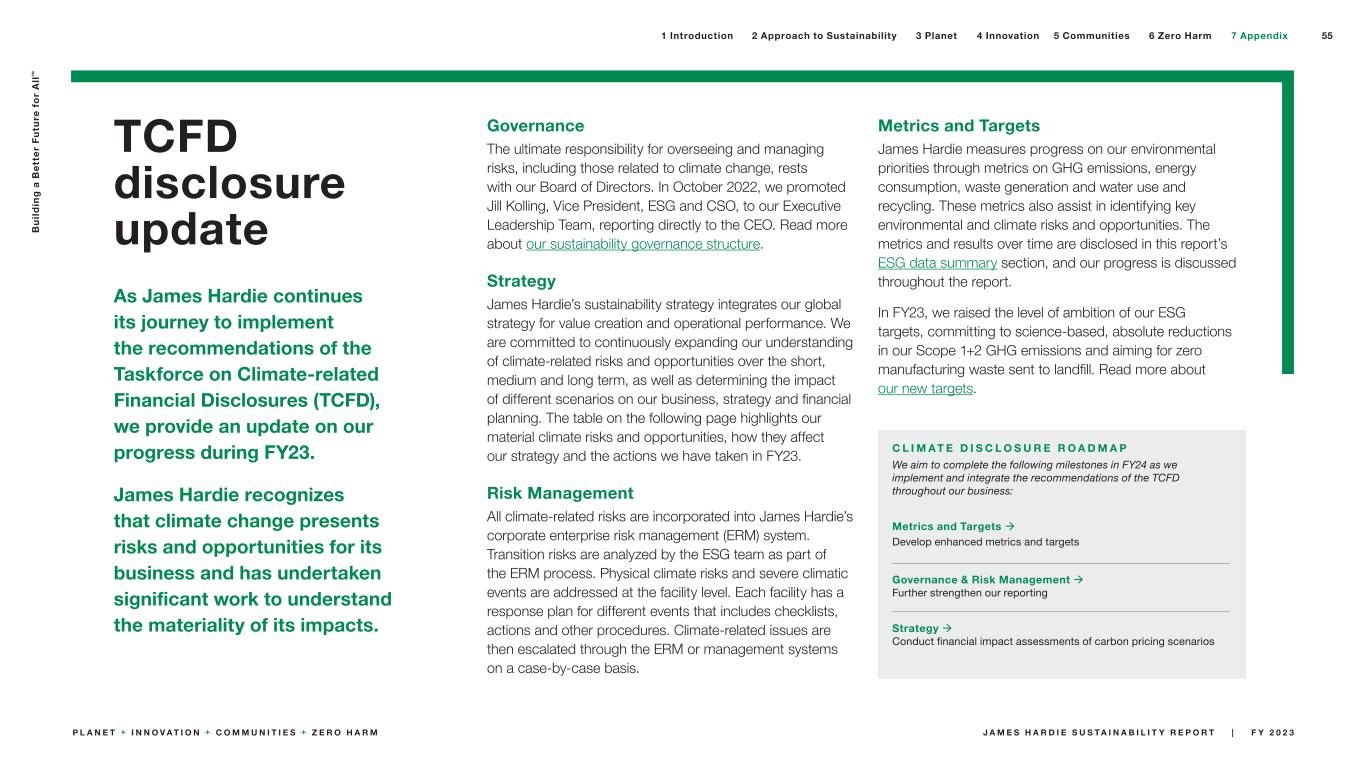
TCFD disclosure update As James Hardie continues its journey to implement the recommendations of the Taskforce on Climate-related Financial Disclosures (TCFD), we provide an update on our progress during FY23. James Hardie recognizes that climate change presents risks and opportunities for its business and has undertaken significant work to understand the materiality of its impacts. Governance The ultimate responsibility for overseeing and managing risks, including those related to climate change, rests with our Board of Directors. In October 2022, we promoted Jill Kolling, Vice President, ESG and CSO, to our Executive Leadership Team, reporting directly to the CEO. Read more about our sustainability governance structure. Strategy James Hardie’s sustainability strategy integrates our global strategy for value creation and operational performance. We are committed to continuously expanding our understanding of climate-related risks and opportunities over the short, medium and long term, as well as determining the impact of different scenarios on our business, strategy and financial planning. The table on the following page highlights our material climate risks and opportunities, how they affect our strategy and the actions we have taken in FY23. Risk Management All climate-related risks are incorporated into James Hardie’s corporate enterprise risk management (ERM) system. Transition risks are analyzed by the ESG team as part of the ERM process. Physical climate risks and severe climatic events are addressed at the facility level. Each facility has a response plan for different events that includes checklists, actions and other procedures. Climate-related issues are then escalated through the ERM or management systems on a case-by-case basis. Metrics and Targets James Hardie measures progress on our environmental priorities through metrics on GHG emissions, energy consumption, waste generation and water use and recycling. These metrics also assist in identifying key environmental and climate risks and opportunities. The metrics and results over time are disclosed in this report’s ESG data summary section, and our progress is discussed throughout the report. In FY23, we raised the level of ambition of our ESG targets, committing to science-based, absolute reductions in our Scope 1+2 GHG emissions and aiming for zero manufacturing waste sent to landfill. Read more about our new targets. C L I M A T E D I S C L O S U R E R O A D M A P We aim to complete the following milestones in FY24 as we implement and integrate the recommendations of the TCFD throughout our business: Metrics and Targets Develop enhanced metrics and targets Governance & Risk Management Further strengthen our reporting Strategy Conduct financial impact assessments of carbon pricing scenarios 55 B u il d in g a B e tt e r F u tu re f o r A ll ™ J A M E S H A R D I E S U S T A I N A B I L I T Y R E P O R T | F Y 2 0 2 3P L A N E T + I N N O V A T I O N + C O M M U N I T I E S + Z E R O H A R M 2 Approach to Sustainability 3 Planet 4 Innovation1 Introduction 5 Communities 6 Zero Harm 7 Appendix
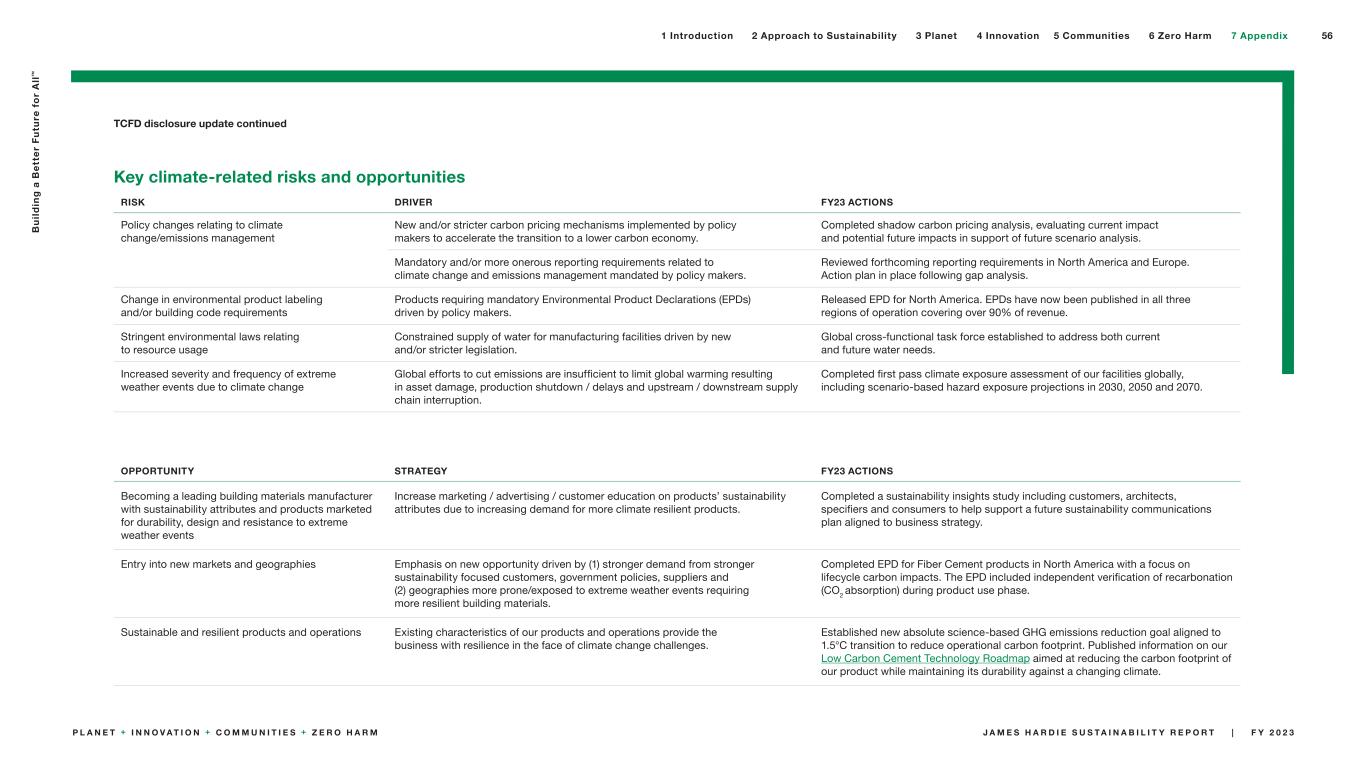
TCFD disclosure update continued Key climate-related risks and opportunities RISK DRIVER FY23 ACTIONS Policy changes relating to climate change/emissions management New and/or stricter carbon pricing mechanisms implemented by policy makers to accelerate the transition to a lower carbon economy. Completed shadow carbon pricing analysis, evaluating current impact and potential future impacts in support of future scenario analysis. Mandatory and/or more onerous reporting requirements related to climate change and emissions management mandated by policy makers. Reviewed forthcoming reporting requirements in North America and Europe. Action plan in place following gap analysis. Change in environmental product labeling and/or building code requirements Products requiring mandatory Environmental Product Declarations (EPDs) driven by policy makers. Released EPD for North America. EPDs have now been published in all three regions of operation covering over 90% of revenue. Stringent environmental laws relating to resource usage Constrained supply of water for manufacturing facilities driven by new and/or stricter legislation. Global cross-functional task force established to address both current and future water needs. Increased severity and frequency of extreme weather events due to climate change Global efforts to cut emissions are insufficient to limit global warming resulting in asset damage, production shutdown / delays and upstream / downstream supply chain interruption. Completed first pass climate exposure assessment of our facilities globally, including scenario-based hazard exposure projections in 2030, 2050 and 2070. OPPORTUNITY STRATEGY FY23 ACTIONS Becoming a leading building materials manufacturer with sustainability attributes and products marketed for durability, design and resistance to extreme weather events Increase marketing / advertising / customer education on products’ sustainability attributes due to increasing demand for more climate resilient products. Completed a sustainability insights study including customers, architects, specifiers and consumers to help support a future sustainability communications plan aligned to business strategy. Entry into new markets and geographies Emphasis on new opportunity driven by (1) stronger demand from stronger sustainability focused customers, government policies, suppliers and (2) geographies more prone/exposed to extreme weather events requiring more resilient building materials. Completed EPD for Fiber Cement products in North America with a focus on lifecycle carbon impacts. The EPD included independent verification of recarbonation (CO2 absorption) during product use phase. Sustainable and resilient products and operations Existing characteristics of our products and operations provide the business with resilience in the face of climate change challenges. Established new absolute science-based GHG emissions reduction goal aligned to 1.5°C transition to reduce operational carbon footprint. Published information on our Low Carbon Cement Technology Roadmap aimed at reducing the carbon footprint of our product while maintaining its durability against a changing climate. 56 B u il d in g a B e tt e r F u tu re f o r A ll ™ J A M E S H A R D I E S U S T A I N A B I L I T Y R E P O R T | F Y 2 0 2 3P L A N E T + I N N O V A T I O N + C O M M U N I T I E S + Z E R O H A R M 2 Approach to Sustainability 3 Planet 4 Innovation1 Introduction 5 Communities 6 Zero Harm 7 Appendix
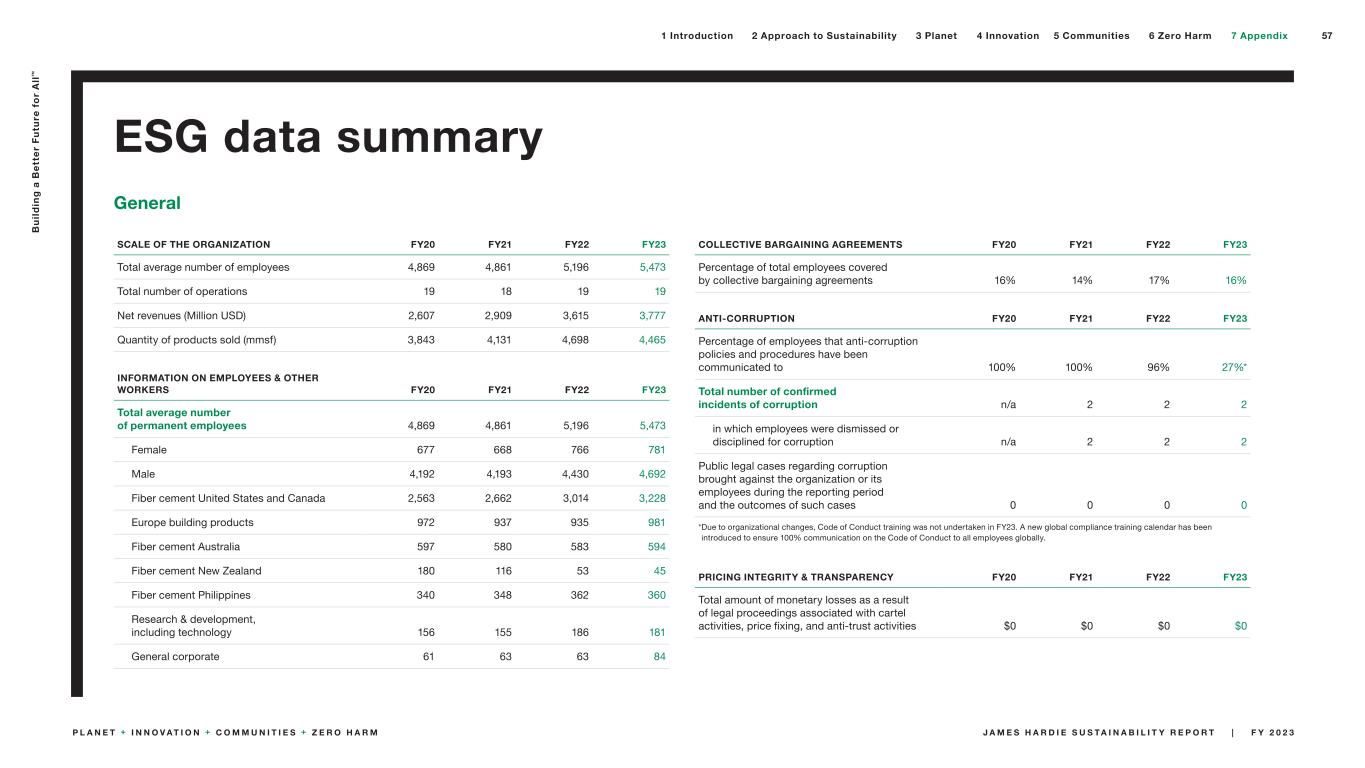
ESG data summary General SCALE OF THE ORGANIZATION FY20 FY21 FY22 FY23 Total average number of employees 4,869 4,861 5,196 5,473 Total number of operations 19 18 19 19 Net revenues (Million USD) 2,607 2,909 3,615 3,777 Quantity of products sold (mmsf) 3,843 4,131 4,698 4,465 INFORMATION ON EMPLOYEES & OTHER WORKERS FY20 FY21 FY22 FY23 Total average number of permanent employees 4,869 4,861 5,196 5,473 Female 677 668 766 781 Male 4,192 4,193 4,430 4,692 Fiber cement United States and Canada 2,563 2,662 3,014 3,228 Europe building products 972 937 935 981 Fiber cement Australia 597 580 583 594 Fiber cement New Zealand 180 116 53 45 Fiber cement Philippines 340 348 362 360 Research & development, including technology 156 155 186 181 General corporate 61 63 63 84 COLLECTIVE BARGAINING AGREEMENTS FY20 FY21 FY22 FY23 Percentage of total employees covered by collective bargaining agreements 16% 14% 17% 16% ANTI-CORRUPTION FY20 FY21 FY22 FY23 Percentage of employees that anti-corruption policies and procedures have been communicated to 100% 100% 96% 27%* Total number of confirmed incidents of corruption n/a 2 2 2 in which employees were dismissed or disciplined for corruption n/a 2 2 2 Public legal cases regarding corruption brought against the organization or its employees during the reporting period and the outcomes of such cases 0 0 0 0 * Due to organizational changes, Code of Conduct training was not undertaken in FY23. A new global compliance training calendar has been introduced to ensure 100% communication on the Code of Conduct to all employees globally. PRICING INTEGRITY & TRANSPARENCY FY20 FY21 FY22 FY23 Total amount of monetary losses as a result of legal proceedings associated with cartel activities, price fixing, and anti-trust activities $0 $0 $0 $0 57 B u il d in g a B e tt e r F u tu re f o r A ll ™ J A M E S H A R D I E S U S T A I N A B I L I T Y R E P O R T | F Y 2 0 2 3P L A N E T + I N N O V A T I O N + C O M M U N I T I E S + Z E R O H A R M 2 Approach to Sustainability 3 Planet 4 Innovation1 Introduction 5 Communities 6 Zero Harm 7 Appendix
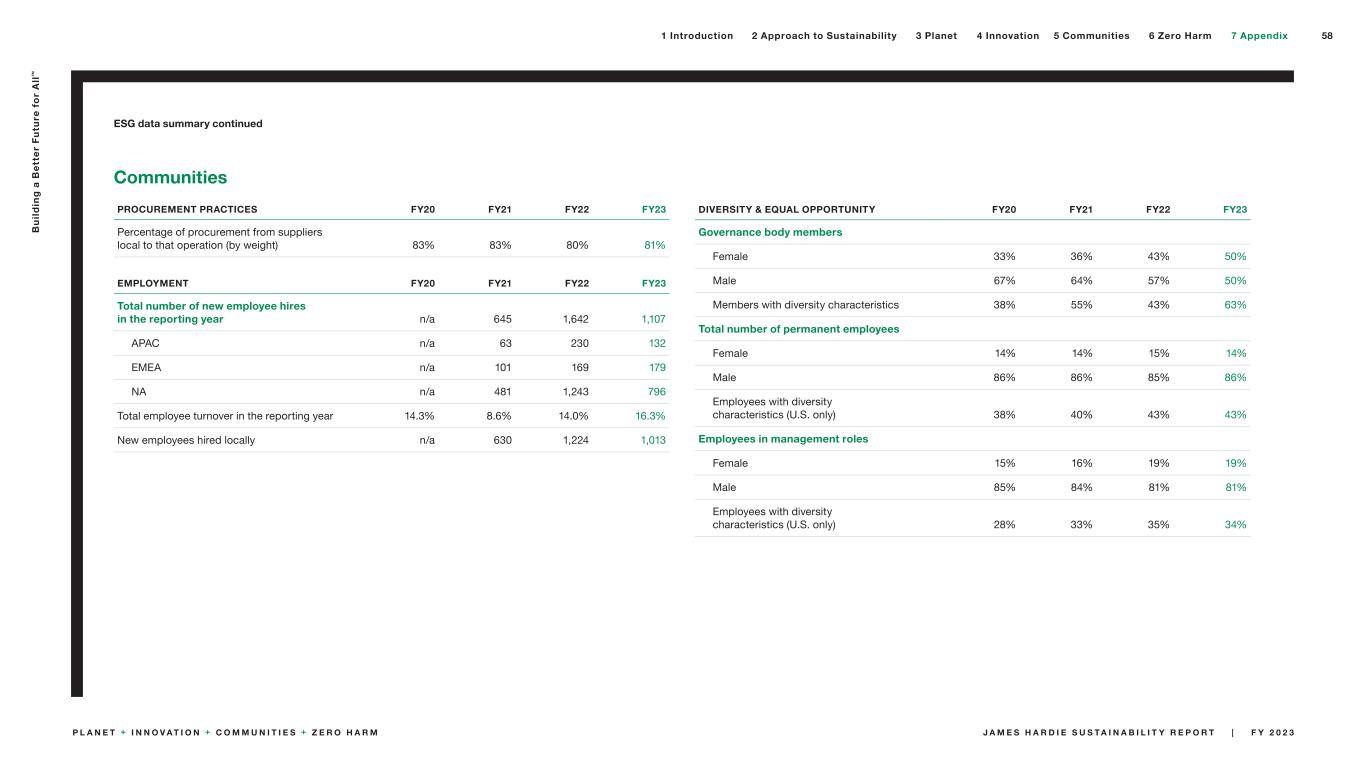
ESG data summary continued Communities PROCUREMENT PRACTICES FY20 FY21 FY22 FY23 Percentage of procurement from suppliers local to that operation (by weight) 83% 83% 80% 81% EMPLOYMENT FY20 FY21 FY22 FY23 Total number of new employee hires in the reporting year n/a 645 1,642 1,107 APAC n/a 63 230 132 EMEA n/a 101 169 179 NA n/a 481 1,243 796 Total employee turnover in the reporting year 14.3% 8.6% 14.0% 16.3% New employees hired locally n/a 630 1,224 1,013 DIVERSITY & EQUAL OPPORTUNITY FY20 FY21 FY22 FY23 Governance body members Female 33% 36% 43% 50% Male 67% 64% 57% 50% Members with diversity characteristics 38% 55% 43% 63% Total number of permanent employees Female 14% 14% 15% 14% Male 86% 86% 85% 86% Employees with diversity characteristics (U.S. only) 38% 40% 43% 43% Employees in management roles Female 15% 16% 19% 19% Male 85% 84% 81% 81% Employees with diversity characteristics (U.S. only) 28% 33% 35% 34% 58 B u il d in g a B e tt e r F u tu re f o r A ll ™ J A M E S H A R D I E S U S T A I N A B I L I T Y R E P O R T | F Y 2 0 2 3P L A N E T + I N N O V A T I O N + C O M M U N I T I E S + Z E R O H A R M 2 Approach to Sustainability 3 Planet 4 Innovation1 Introduction 5 Communities 6 Zero Harm 7 Appendix
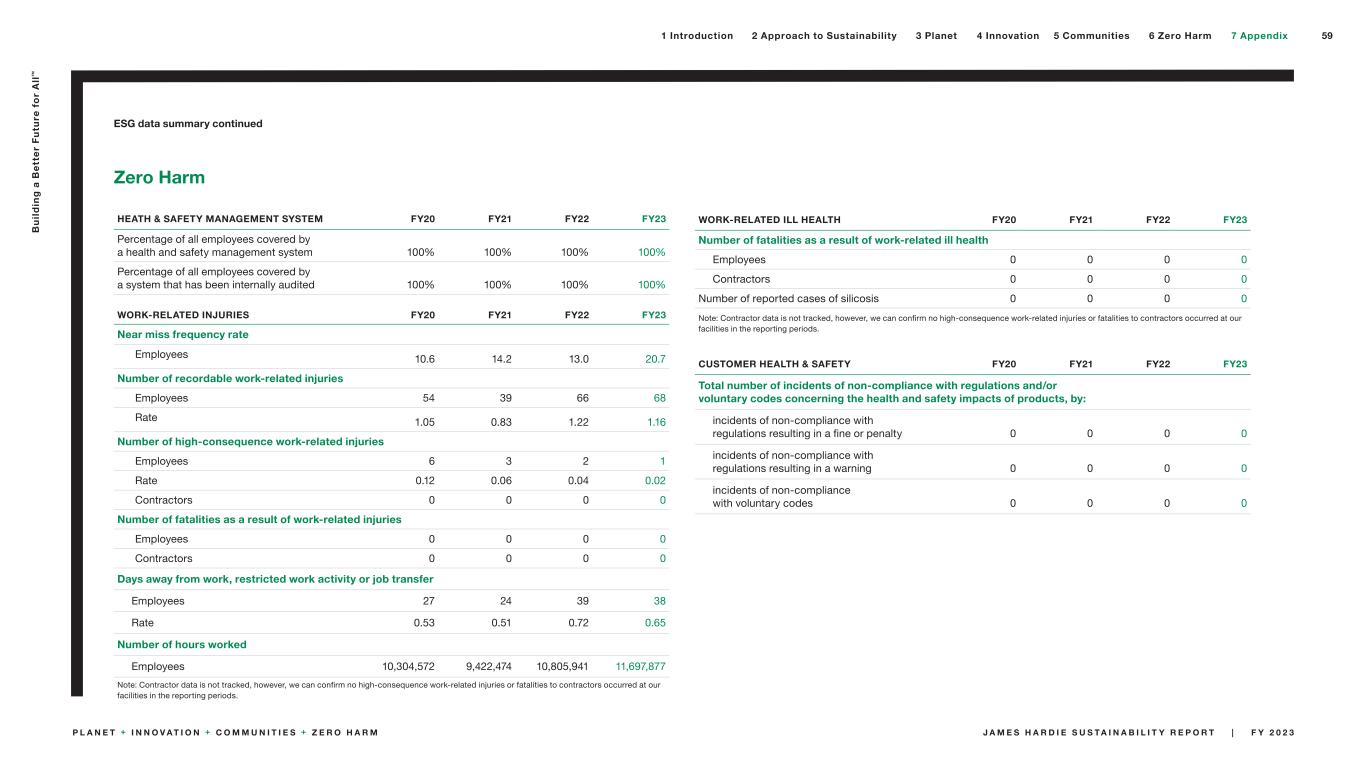
ESG data summary continued Zero Harm HEATH & SAFETY MANAGEMENT SYSTEM FY20 FY21 FY22 FY23 Percentage of all employees covered by a health and safety management system 100% 100% 100% 100% Percentage of all employees covered by a system that has been internally audited 100% 100% 100% 100% WORK-RELATED INJURIES FY20 FY21 FY22 FY23 Near miss frequency rate Employees 10.6 14.2 13.0 20.7 Number of recordable work-related injuries Employees 54 39 66 68 Rate 1.05 0.83 1.22 1.16 Number of high-consequence work-related injuries Employees 6 3 2 1 Rate 0.12 0.06 0.04 0.02 Contractors 0 0 0 0 Number of fatalities as a result of work-related injuries Employees 0 0 0 0 Contractors 0 0 0 0 Days away from work, restricted work activity or job transfer Employees 27 24 39 38 Rate 0.53 0.51 0.72 0.65 Number of hours worked Employees 10,304,572 9,422,474 10,805,941 11,697,877 Note: Contractor data is not tracked, however, we can confirm no high-consequence work-related injuries or fatalities to contractors occurred at our facilities in the reporting periods. WORK-RELATED ILL HEALTH FY20 FY21 FY22 FY23 Number of fatalities as a result of work-related ill health Employees 0 0 0 0 Contractors 0 0 0 0 Number of reported cases of silicosis 0 0 0 0 Note: Contractor data is not tracked, however, we can confirm no high-consequence work-related injuries or fatalities to contractors occurred at our facilities in the reporting periods. CUSTOMER HEALTH & SAFETY FY20 FY21 FY22 FY23 Total number of incidents of non-compliance with regulations and/or voluntary codes concerning the health and safety impacts of products, by: incidents of non-compliance with regulations resulting in a fine or penalty 0 0 0 0 incidents of non-compliance with regulations resulting in a warning 0 0 0 0 incidents of non-compliance with voluntary codes 0 0 0 0 59 B u il d in g a B e tt e r F u tu re f o r A ll ™ J A M E S H A R D I E S U S T A I N A B I L I T Y R E P O R T | F Y 2 0 2 3P L A N E T + I N N O V A T I O N + C O M M U N I T I E S + Z E R O H A R M 2 Approach to Sustainability 3 Planet 4 Innovation1 Introduction 5 Communities 6 Zero Harm 7 Appendix
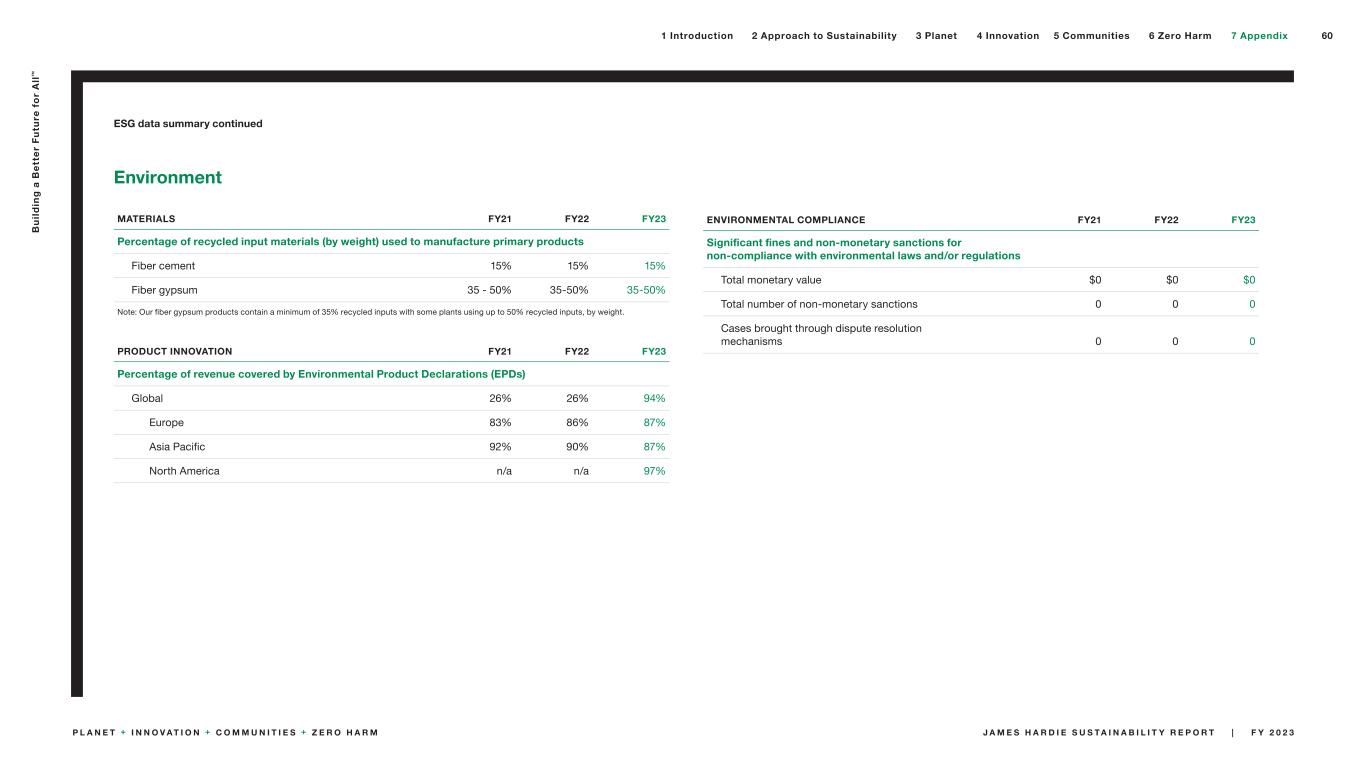
Environment MATERIALS FY21 FY22 FY23 Percentage of recycled input materials (by weight) used to manufacture primary products Fiber cement 15% 15% 15% Fiber gypsum 35 - 50% 35-50% 35-50% Note: Our fiber gypsum products contain a minimum of 35% recycled inputs with some plants using up to 50% recycled inputs, by weight. PRODUCT INNOVATION FY21 FY22 FY23 Percentage of revenue covered by Environmental Product Declarations (EPDs) Global 26% 26% 94% Europe 83% 86% 87% Asia Pacific 92% 90% 87% North America n/a n/a 97% ENVIRONMENTAL COMPLIANCE FY21 FY22 FY23 Significant fines and non-monetary sanctions for non-compliance with environmental laws and/or regulations Total monetary value $0 $0 $0 Total number of non-monetary sanctions 0 0 0 Cases brought through dispute resolution mechanisms 0 0 0 ESG data summary continued 60 B u il d in g a B e tt e r F u tu re f o r A ll ™ J A M E S H A R D I E S U S T A I N A B I L I T Y R E P O R T | F Y 2 0 2 3P L A N E T + I N N O V A T I O N + C O M M U N I T I E S + Z E R O H A R M 2 Approach to Sustainability 3 Planet 4 Innovation1 Introduction 5 Communities 6 Zero Harm 7 Appendix
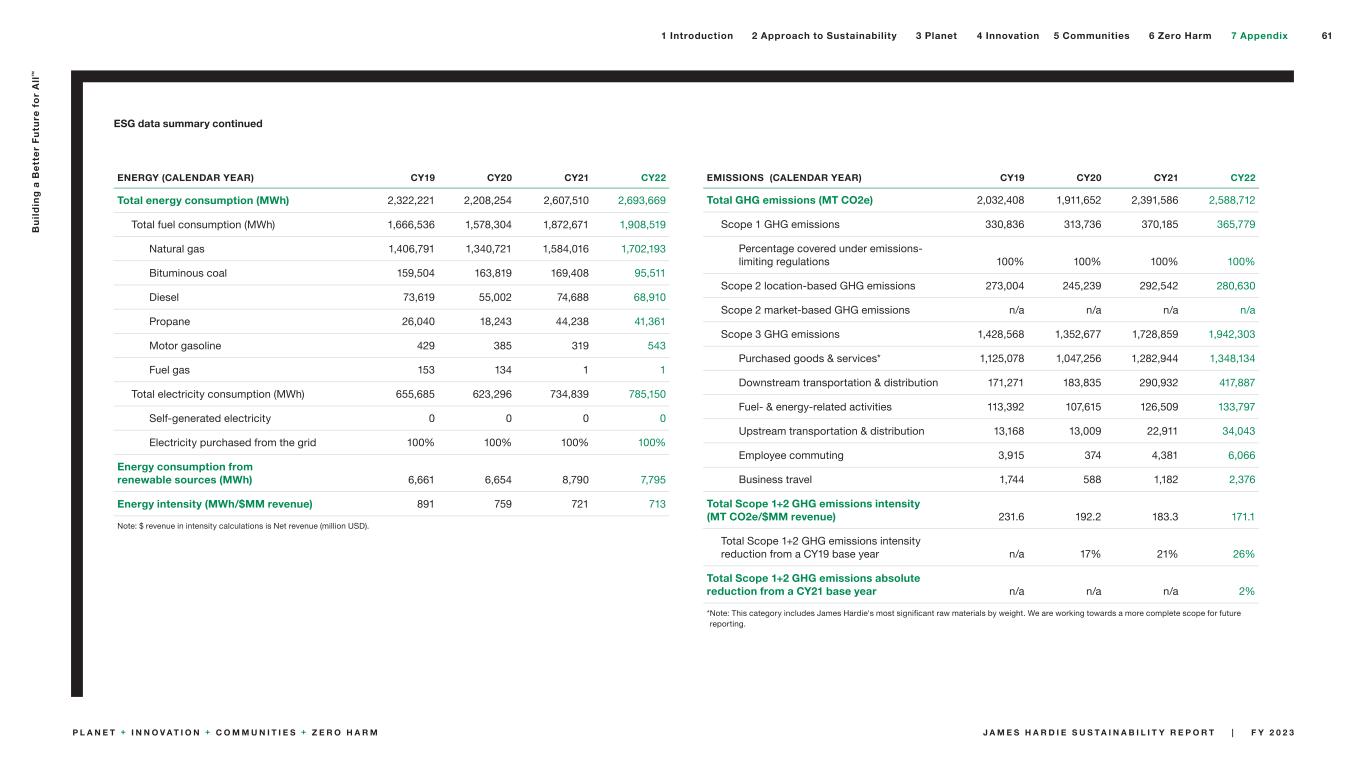
ENERGY (CALENDAR YEAR) CY19 CY20 CY21 CY22 Total energy consumption (MWh) 2,322,221 2,208,254 2,607,510 2,693,669 Total fuel consumption (MWh) 1,666,536 1,578,304 1,872,671 1,908,519 Natural gas 1,406,791 1,340,721 1,584,016 1,702,193 Bituminous coal 159,504 163,819 169,408 95,511 Diesel 73,619 55,002 74,688 68,910 Propane 26,040 18,243 44,238 41,361 Motor gasoline 429 385 319 543 Fuel gas 153 134 1 1 Total electricity consumption (MWh) 655,685 623,296 734,839 785,150 Self-generated electricity 0 0 0 0 Electricity purchased from the grid 100% 100% 100% 100% Energy consumption from renewable sources (MWh) 6,661 6,654 8,790 7,795 Energy intensity (MWh/$MM revenue) 891 759 721 713 Note: $ revenue in intensity calculations is Net revenue (million USD). EMISSIONS (CALENDAR YEAR) CY19 CY20 CY21 CY22 Total GHG emissions (MT CO2e) 2,032,408 1,911,652 2,391,586 2,588,712 Scope 1 GHG emissions 330,836 313,736 370,185 365,779 Percentage covered under emissions- limiting regulations 100% 100% 100% 100% Scope 2 location-based GHG emissions 273,004 245,239 292,542 280,630 Scope 2 market-based GHG emissions n/a n/a n/a n/a Scope 3 GHG emissions 1,428,568 1,352,677 1,728,859 1,942,303 Purchased goods & services* 1,125,078 1,047,256 1,282,944 1,348,134 Downstream transportation & distribution 171,271 183,835 290,932 417,887 Fuel- & energy-related activities 113,392 107,615 126,509 133,797 Upstream transportation & distribution 13,168 13,009 22,911 34,043 Employee commuting 3,915 374 4,381 6,066 Business travel 1,744 588 1,182 2,376 Total Scope 1+2 GHG emissions intensity (MT CO2e/$MM revenue) 231.6 192.2 183.3 171.1 Total Scope 1+2 GHG emissions intensity reduction from a CY19 base year n/a 17% 21% 26% Total Scope 1+2 GHG emissions absolute reduction from a CY21 base year n/a n/a n/a 2% * Note: This category includes James Hardie's most significant raw materials by weight. We are working towards a more complete scope for future reporting. ESG data summary continued 61 B u il d in g a B e tt e r F u tu re f o r A ll ™ J A M E S H A R D I E S U S T A I N A B I L I T Y R E P O R T | F Y 2 0 2 3P L A N E T + I N N O V A T I O N + C O M M U N I T I E S + Z E R O H A R M 2 Approach to Sustainability 3 Planet 4 Innovation1 Introduction 5 Communities 6 Zero Harm 7 Appendix
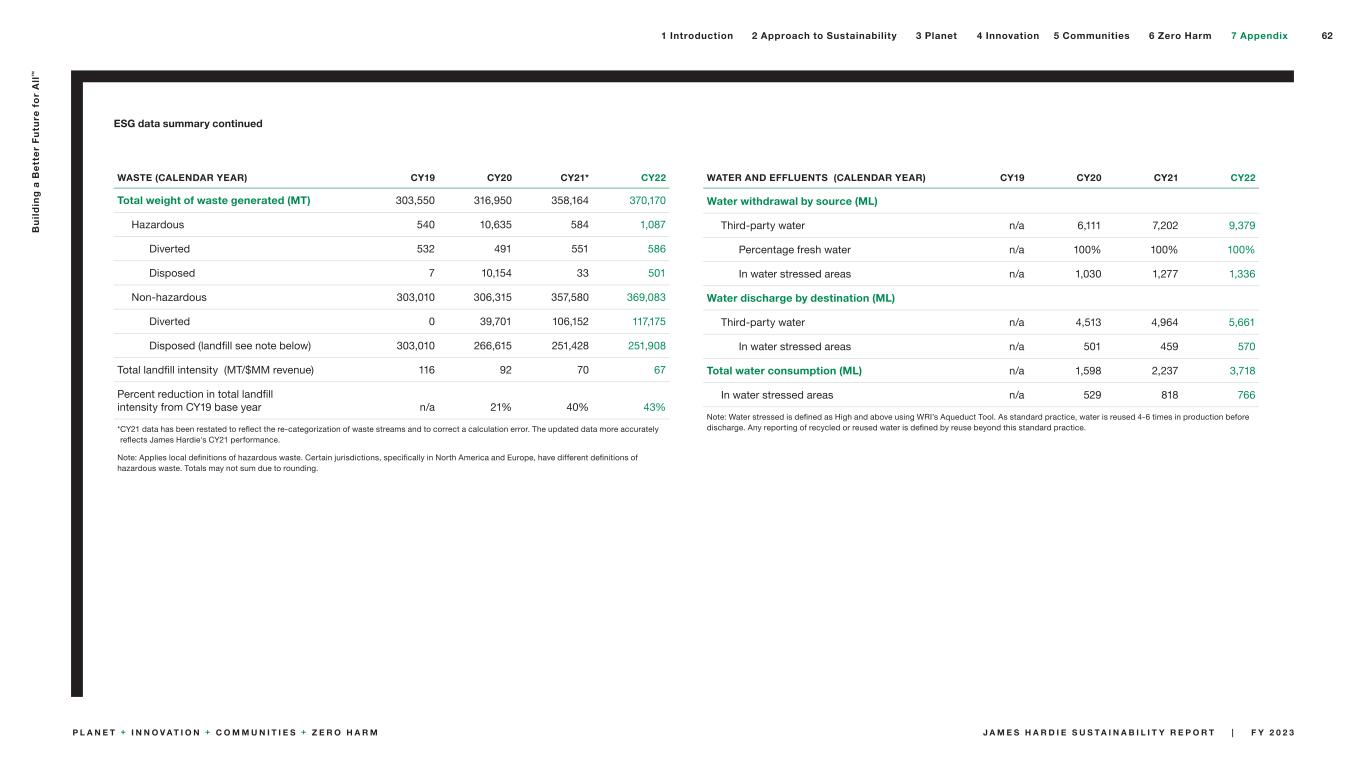
ESG data summary continued WASTE (CALENDAR YEAR) CY19 CY20 CY21* CY22 Total weight of waste generated (MT) 303,550 316,950 358,164 370,170 Hazardous 540 10,635 584 1,087 Diverted 532 491 551 586 Disposed 7 10,154 33 501 Non-hazardous 303,010 306,315 357,580 369,083 Diverted 0 39,701 106,152 117,175 Disposed (landfill see note below) 303,010 266,615 251,428 251,908 Total landfill intensity (MT/$MM revenue) 116 92 70 67 Percent reduction in total landfill intensity from CY19 base year n/a 21% 40% 43% * CY21 data has been restated to reflect the re-categorization of waste streams and to correct a calculation error. The updated data more accurately reflects James Hardie's CY21 performance. Note: Applies local definitions of hazardous waste. Certain jurisdictions, specifically in North America and Europe, have different definitions of hazardous waste. Totals may not sum due to rounding. WATER AND EFFLUENTS (CALENDAR YEAR) CY19 CY20 CY21 CY22 Water withdrawal by source (ML) Third-party water n/a 6,111 7,202 9,379 Percentage fresh water n/a 100% 100% 100% In water stressed areas n/a 1,030 1,277 1,336 Water discharge by destination (ML) Third-party water n/a 4,513 4,964 5,661 In water stressed areas n/a 501 459 570 Total water consumption (ML) n/a 1,598 2,237 3,718 In water stressed areas n/a 529 818 766 Note: Water stressed is defined as High and above using WRI’s Aqueduct Tool. As standard practice, water is reused 4-6 times in production before discharge. Any reporting of recycled or reused water is defined by reuse beyond this standard practice. 62 B u il d in g a B e tt e r F u tu re f o r A ll ™ J A M E S H A R D I E S U S T A I N A B I L I T Y R E P O R T | F Y 2 0 2 3P L A N E T + I N N O V A T I O N + C O M M U N I T I E S + Z E R O H A R M 2 Approach to Sustainability 3 Planet 4 Innovation1 Introduction 5 Communities 6 Zero Harm 7 Appendix
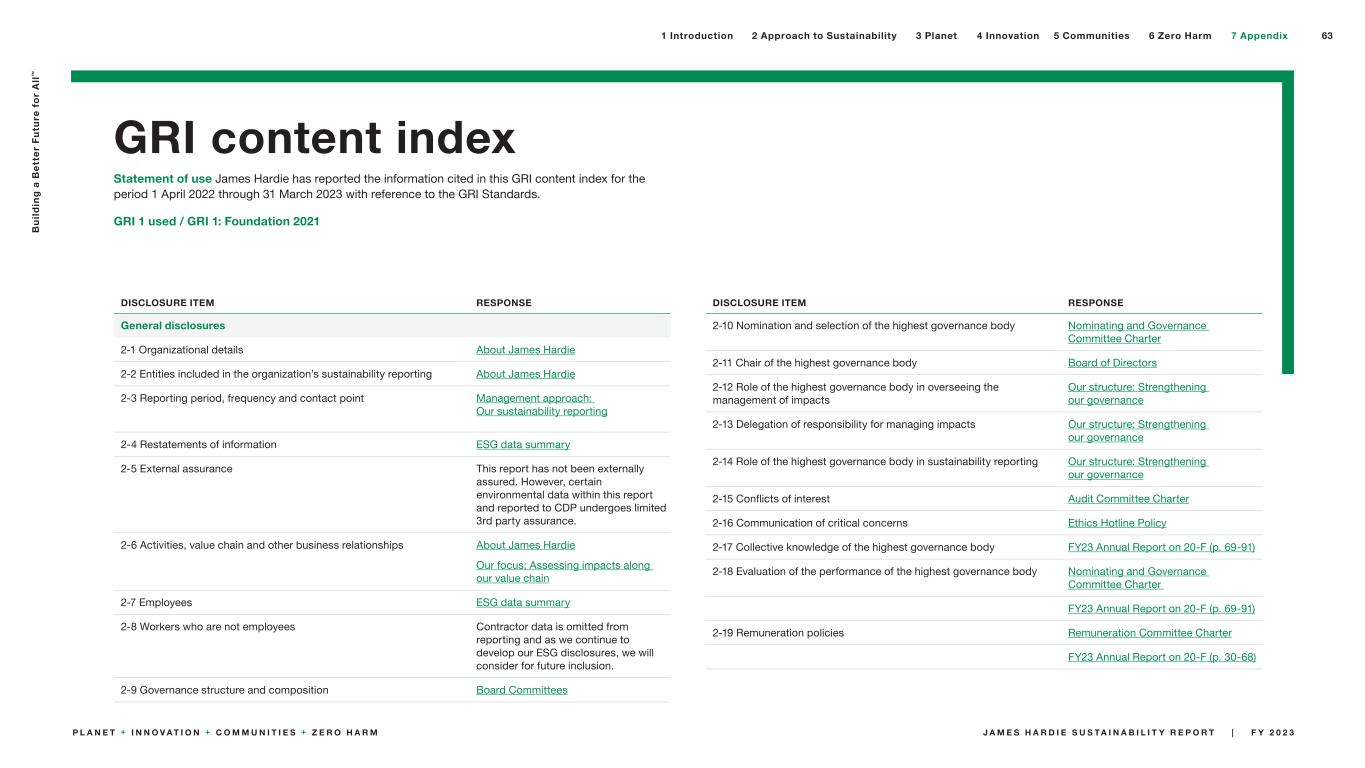
GRI content index Statement of use James Hardie has reported the information cited in this GRI content index for the period 1 April 2022 through 31 March 2023 with reference to the GRI Standards. GRI 1 used / GRI 1: Foundation 2021 DISCLOSURE ITEM RESPONSE General disclosures 2-1 Organizational details About James Hardie 2-2 Entities included in the organization’s sustainability reporting About James Hardie 2-3 Reporting period, frequency and contact point Management approach: Our sustainability reporting 2-4 Restatements of information ESG data summary 2-5 External assurance This report has not been externally assured. However, certain environmental data within this report and reported to CDP undergoes limited 3rd party assurance. 2-6 Activities, value chain and other business relationships About James Hardie Our focus: Assessing impacts along our value chain 2-7 Employees ESG data summary 2-8 Workers who are not employees Contractor data is omitted from reporting and as we continue to develop our ESG disclosures, we will consider for future inclusion. 2-9 Governance structure and composition Board Committees DISCLOSURE ITEM RESPONSE 2-10 Nomination and selection of the highest governance body Nominating and Governance Committee Charter 2-11 Chair of the highest governance body Board of Directors 2-12 Role of the highest governance body in overseeing the management of impacts Our structure: Strengthening our governance 2-13 Delegation of responsibility for managing impacts Our structure: Strengthening our governance 2-14 Role of the highest governance body in sustainability reporting Our structure: Strengthening our governance 2-15 Conflicts of interest Audit Committee Charter 2-16 Communication of critical concerns Ethics Hotline Policy 2-17 Collective knowledge of the highest governance body FY23 Annual Report on 20-F (p. 69-91) 2-18 Evaluation of the performance of the highest governance body Nominating and Governance Committee Charter FY23 Annual Report on 20-F (p. 69-91) 2-19 Remuneration policies Remuneration Committee Charter FY23 Annual Report on 20-F (p. 30-68) 63 B u il d in g a B e tt e r F u tu re f o r A ll ™ J A M E S H A R D I E S U S T A I N A B I L I T Y R E P O R T | F Y 2 0 2 3P L A N E T + I N N O V A T I O N + C O M M U N I T I E S + Z E R O H A R M 2 Approach to Sustainability 3 Planet 4 Innovation1 Introduction 5 Communities 6 Zero Harm 7 Appendix
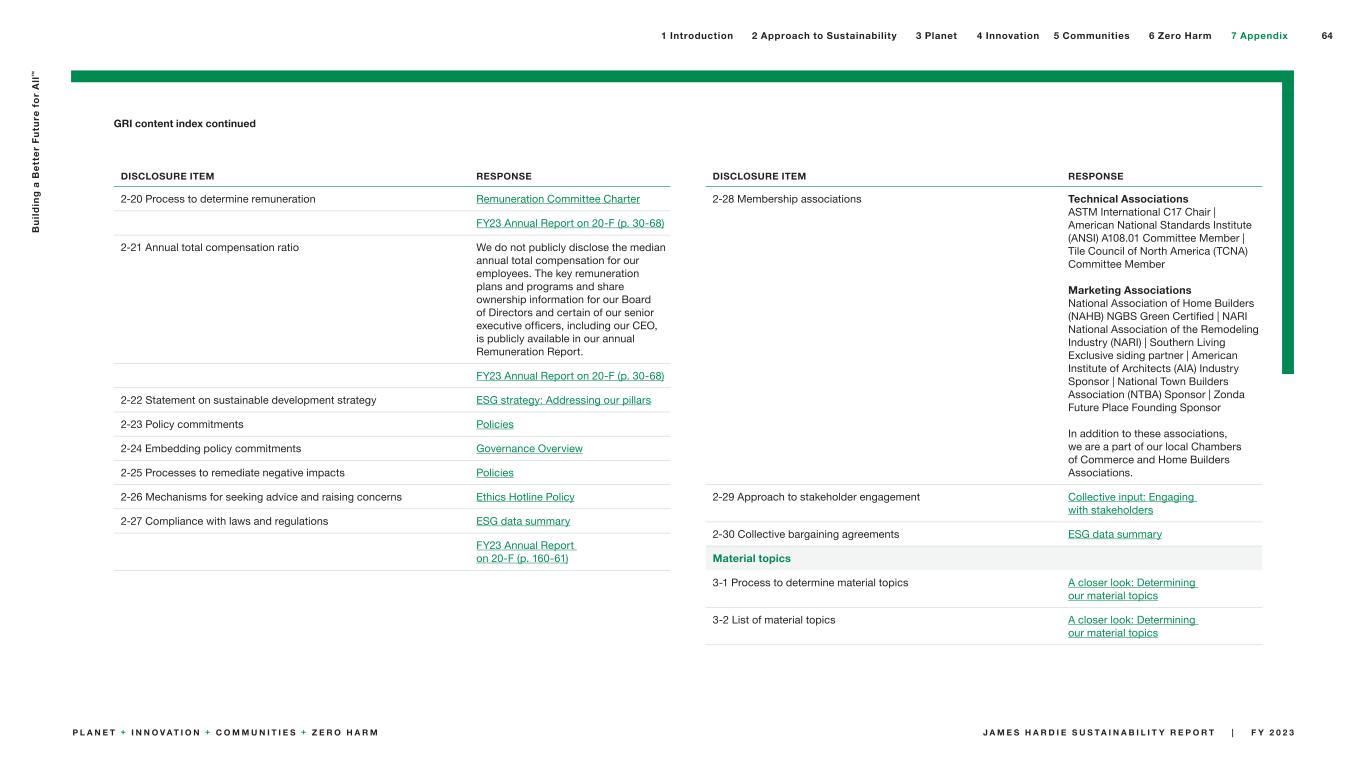
GRI content index continued DISCLOSURE ITEM RESPONSE 2-20 Process to determine remuneration Remuneration Committee Charter FY23 Annual Report on 20-F (p. 30-68) 2-21 Annual total compensation ratio We do not publicly disclose the median annual total compensation for our employees. The key remuneration plans and programs and share ownership information for our Board of Directors and certain of our senior executive officers, including our CEO, is publicly available in our annual Remuneration Report. FY23 Annual Report on 20-F (p. 30-68) 2-22 Statement on sustainable development strategy ESG strategy: Addressing our pillars 2-23 Policy commitments Policies 2-24 Embedding policy commitments Governance Overview 2-25 Processes to remediate negative impacts Policies 2-26 Mechanisms for seeking advice and raising concerns Ethics Hotline Policy 2-27 Compliance with laws and regulations ESG data summary FY23 Annual Report on 20-F (p. 160-61) DISCLOSURE ITEM RESPONSE 2-28 Membership associations Technical Associations ASTM International C17 Chair | American National Standards Institute (ANSI) A108.01 Committee Member | Tile Council of North America (TCNA) Committee Member Marketing Associations National Association of Home Builders (NAHB) NGBS Green Certified | NARI National Association of the Remodeling Industry (NARI) | Southern Living Exclusive siding partner | American Institute of Architects (AIA) Industry Sponsor | National Town Builders Association (NTBA) Sponsor | Zonda Future Place Founding Sponsor In addition to these associations, we are a part of our local Chambers of Commerce and Home Builders Associations. 2-29 Approach to stakeholder engagement Collective input: Engaging with stakeholders 2-30 Collective bargaining agreements ESG data summary Material topics 3-1 Process to determine material topics A closer look: Determining our material topics 3-2 List of material topics A closer look: Determining our material topics 64 B u il d in g a B e tt e r F u tu re f o r A ll ™ J A M E S H A R D I E S U S T A I N A B I L I T Y R E P O R T | F Y 2 0 2 3P L A N E T + I N N O V A T I O N + C O M M U N I T I E S + Z E R O H A R M 2 Approach to Sustainability 3 Planet 4 Innovation1 Introduction 5 Communities 6 Zero Harm 7 Appendix
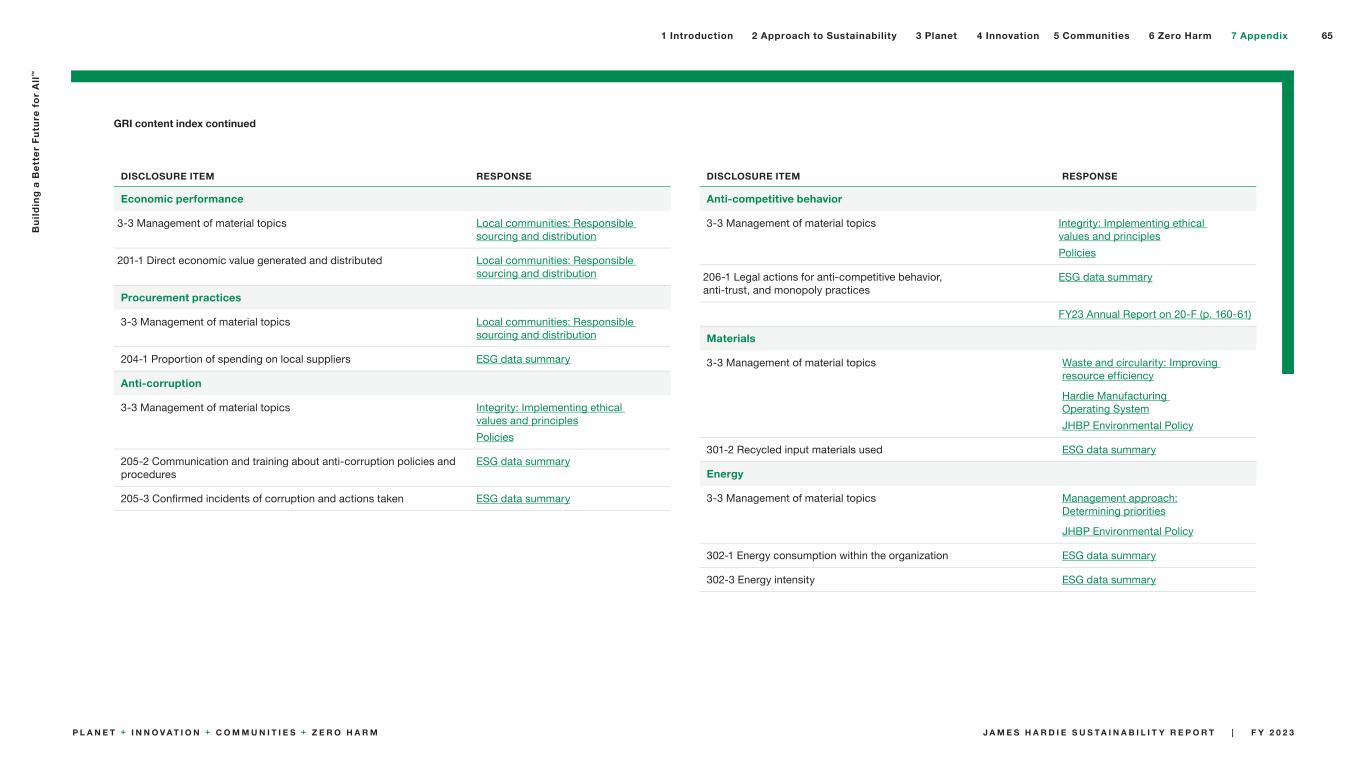
GRI content index continued DISCLOSURE ITEM RESPONSE Economic performance 3-3 Management of material topics Local communities: Responsible sourcing and distribution 201-1 Direct economic value generated and distributed Local communities: Responsible sourcing and distribution Procurement practices 3-3 Management of material topics Local communities: Responsible sourcing and distribution 204-1 Proportion of spending on local suppliers ESG data summary Anti-corruption 3-3 Management of material topics Integrity: Implementing ethical values and principles Policies 205-2 Communication and training about anti-corruption policies and procedures ESG data summary 205-3 Confirmed incidents of corruption and actions taken ESG data summary DISCLOSURE ITEM RESPONSE Anti-competitive behavior 3-3 Management of material topics Integrity: Implementing ethical values and principles Policies 206-1 Legal actions for anti-competitive behavior, anti-trust, and monopoly practices ESG data summary FY23 Annual Report on 20-F (p. 160-61) Materials 3-3 Management of material topics Waste and circularity: Improving resource efficiency Hardie Manufacturing Operating System JHBP Environmental Policy 301-2 Recycled input materials used ESG data summary Energy 3-3 Management of material topics Management approach: Determining priorities JHBP Environmental Policy 302-1 Energy consumption within the organization ESG data summary 302-3 Energy intensity ESG data summary 65 B u il d in g a B e tt e r F u tu re f o r A ll ™ J A M E S H A R D I E S U S T A I N A B I L I T Y R E P O R T | F Y 2 0 2 3P L A N E T + I N N O V A T I O N + C O M M U N I T I E S + Z E R O H A R M 2 Approach to Sustainability 3 Planet 4 Innovation1 Introduction 5 Communities 6 Zero Harm 7 Appendix
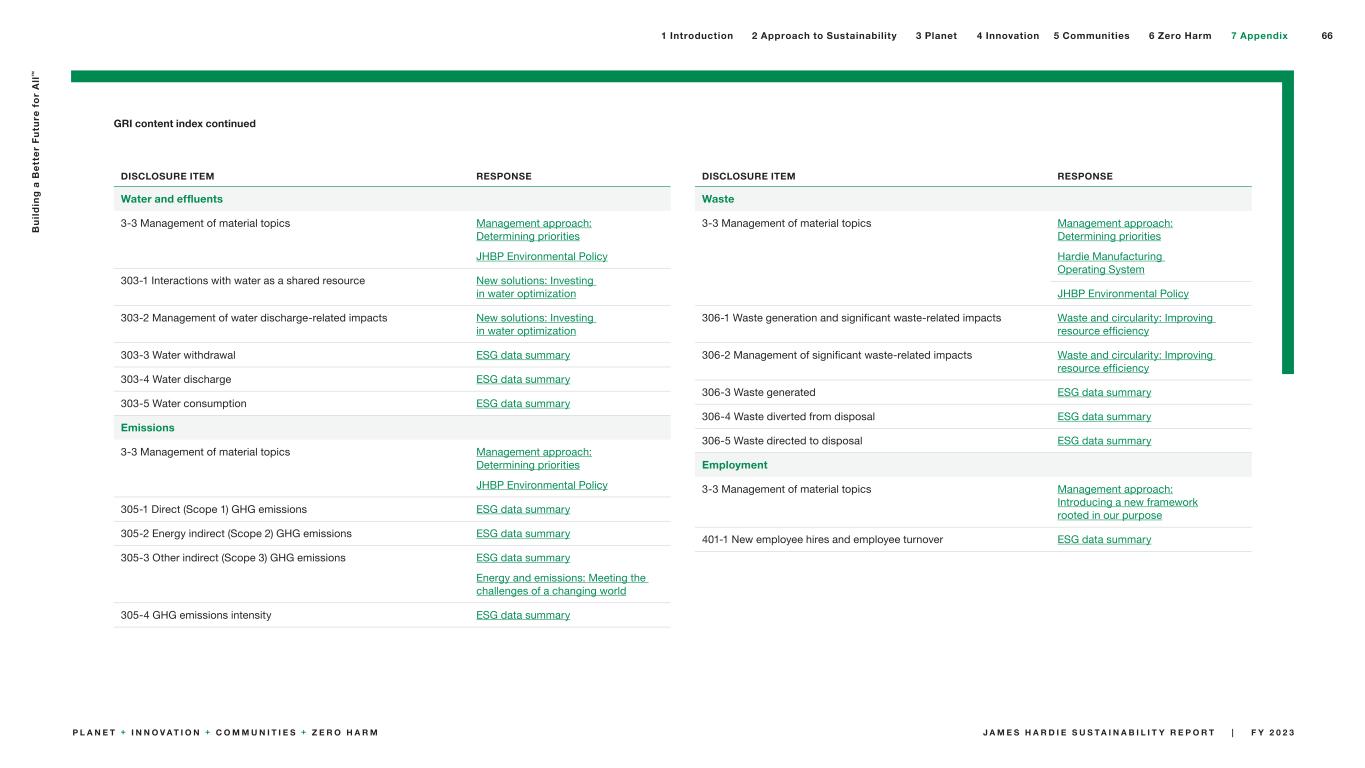
GRI content index continued DISCLOSURE ITEM RESPONSE Water and effluents 3-3 Management of material topics Management approach: Determining priorities JHBP Environmental Policy 303-1 Interactions with water as a shared resource New solutions: Investing in water optimization 303-2 Management of water discharge-related impacts New solutions: Investing in water optimization 303-3 Water withdrawal ESG data summary 303-4 Water discharge ESG data summary 303-5 Water consumption ESG data summary Emissions 3-3 Management of material topics Management approach: Determining priorities JHBP Environmental Policy 305-1 Direct (Scope 1) GHG emissions ESG data summary 305-2 Energy indirect (Scope 2) GHG emissions ESG data summary 305-3 Other indirect (Scope 3) GHG emissions ESG data summary Energy and emissions: Meeting the challenges of a changing world 305-4 GHG emissions intensity ESG data summary DISCLOSURE ITEM RESPONSE Waste 3-3 Management of material topics Management approach: Determining priorities Hardie Manufacturing Operating System JHBP Environmental Policy 306-1 Waste generation and significant waste-related impacts Waste and circularity: Improving resource efficiency 306-2 Management of significant waste-related impacts Waste and circularity: Improving resource efficiency 306-3 Waste generated ESG data summary 306-4 Waste diverted from disposal ESG data summary 306-5 Waste directed to disposal ESG data summary Employment 3-3 Management of material topics Management approach: Introducing a new framework rooted in our purpose 401-1 New employee hires and employee turnover ESG data summary 66 B u il d in g a B e tt e r F u tu re f o r A ll ™ J A M E S H A R D I E S U S T A I N A B I L I T Y R E P O R T | F Y 2 0 2 3P L A N E T + I N N O V A T I O N + C O M M U N I T I E S + Z E R O H A R M 2 Approach to Sustainability 3 Planet 4 Innovation1 Introduction 5 Communities 6 Zero Harm 7 Appendix
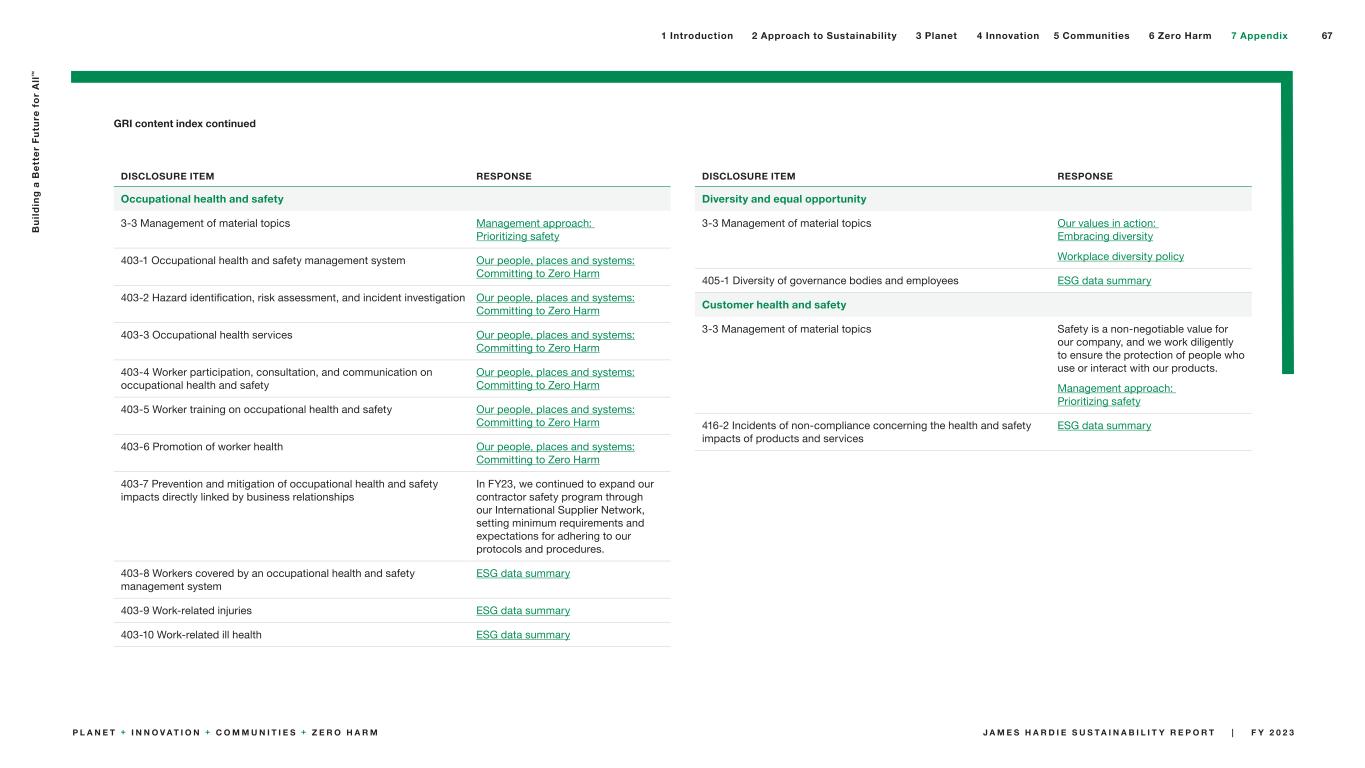
GRI content index continued DISCLOSURE ITEM RESPONSE Occupational health and safety 3-3 Management of material topics Management approach: Prioritizing safety 403-1 Occupational health and safety management system Our people, places and systems: Committing to Zero Harm 403-2 Hazard identification, risk assessment, and incident investigation Our people, places and systems: Committing to Zero Harm 403-3 Occupational health services Our people, places and systems: Committing to Zero Harm 403-4 Worker participation, consultation, and communication on occupational health and safety Our people, places and systems: Committing to Zero Harm 403-5 Worker training on occupational health and safety Our people, places and systems: Committing to Zero Harm 403-6 Promotion of worker health Our people, places and systems: Committing to Zero Harm 403-7 Prevention and mitigation of occupational health and safety impacts directly linked by business relationships In FY23, we continued to expand our contractor safety program through our International Supplier Network, setting minimum requirements and expectations for adhering to our protocols and procedures. 403-8 Workers covered by an occupational health and safety management system ESG data summary 403-9 Work-related injuries ESG data summary 403-10 Work-related ill health ESG data summary DISCLOSURE ITEM RESPONSE Diversity and equal opportunity 3-3 Management of material topics Our values in action: Embracing diversity Workplace diversity policy 405-1 Diversity of governance bodies and employees ESG data summary Customer health and safety 3-3 Management of material topics Safety is a non-negotiable value for our company, and we work diligently to ensure the protection of people who use or interact with our products. Management approach: Prioritizing safety 416-2 Incidents of non-compliance concerning the health and safety impacts of products and services ESG data summary 67 B u il d in g a B e tt e r F u tu re f o r A ll ™ J A M E S H A R D I E S U S T A I N A B I L I T Y R E P O R T | F Y 2 0 2 3P L A N E T + I N N O V A T I O N + C O M M U N I T I E S + Z E R O H A R M 2 Approach to Sustainability 3 Planet 4 Innovation1 Introduction 5 Communities 6 Zero Harm 7 Appendix
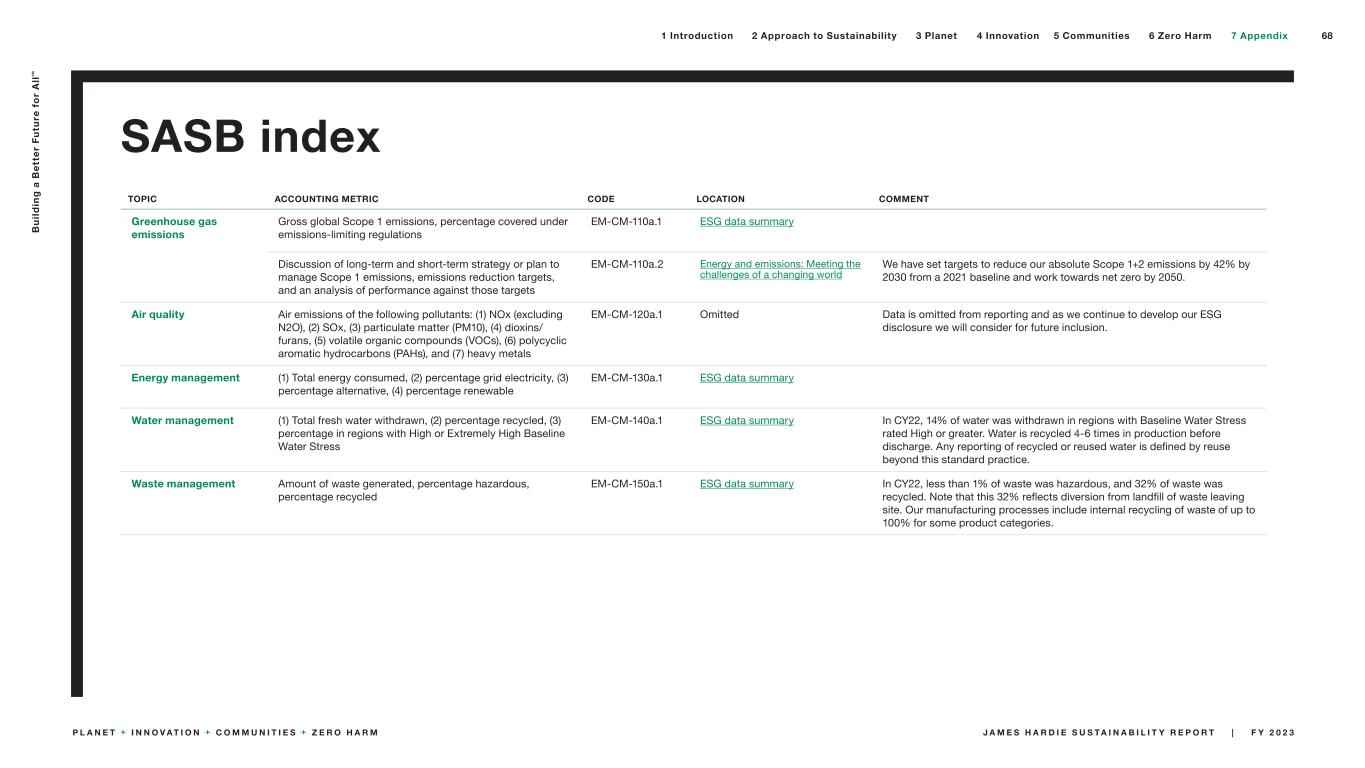
SASB index TOPIC ACCOUNTING METRIC CODE LOCATION COMMENT Greenhouse gas emissions Gross global Scope 1 emissions, percentage covered under emissions-limiting regulations EM-CM-110a.1 ESG data summary Discussion of long-term and short-term strategy or plan to manage Scope 1 emissions, emissions reduction targets, and an analysis of performance against those targets EM-CM-110a.2 Energy and emissions: Meeting the challenges of a changing world We have set targets to reduce our absolute Scope 1+2 emissions by 42% by 2030 from a 2021 baseline and work towards net zero by 2050. Air quality Air emissions of the following pollutants: (1) NOx (excluding N2O), (2) SOx, (3) particulate matter (PM10), (4) dioxins/ furans, (5) volatile organic compounds (VOCs), (6) polycyclic aromatic hydrocarbons (PAHs), and (7) heavy metals EM-CM-120a.1 Omitted Data is omitted from reporting and as we continue to develop our ESG disclosure we will consider for future inclusion. Energy management (1) Total energy consumed, (2) percentage grid electricity, (3) percentage alternative, (4) percentage renewable EM-CM-130a.1 ESG data summary Water management (1) Total fresh water withdrawn, (2) percentage recycled, (3) percentage in regions with High or Extremely High Baseline Water Stress EM-CM-140a.1 ESG data summary In CY22, 14% of water was withdrawn in regions with Baseline Water Stress rated High or greater. Water is recycled 4-6 times in production before discharge. Any reporting of recycled or reused water is defined by reuse beyond this standard practice. Waste management Amount of waste generated, percentage hazardous, percentage recycled EM-CM-150a.1 ESG data summary In CY22, less than 1% of waste was hazardous, and 32% of waste was recycled. Note that this 32% reflects diversion from landfill of waste leaving site. Our manufacturing processes include internal recycling of waste of up to 100% for some product categories. 68 B u il d in g a B e tt e r F u tu re f o r A ll ™ J A M E S H A R D I E S U S T A I N A B I L I T Y R E P O R T | F Y 2 0 2 3P L A N E T + I N N O V A T I O N + C O M M U N I T I E S + Z E R O H A R M 2 Approach to Sustainability 3 Planet 4 Innovation1 Introduction 5 Communities 6 Zero Harm 7 Appendix
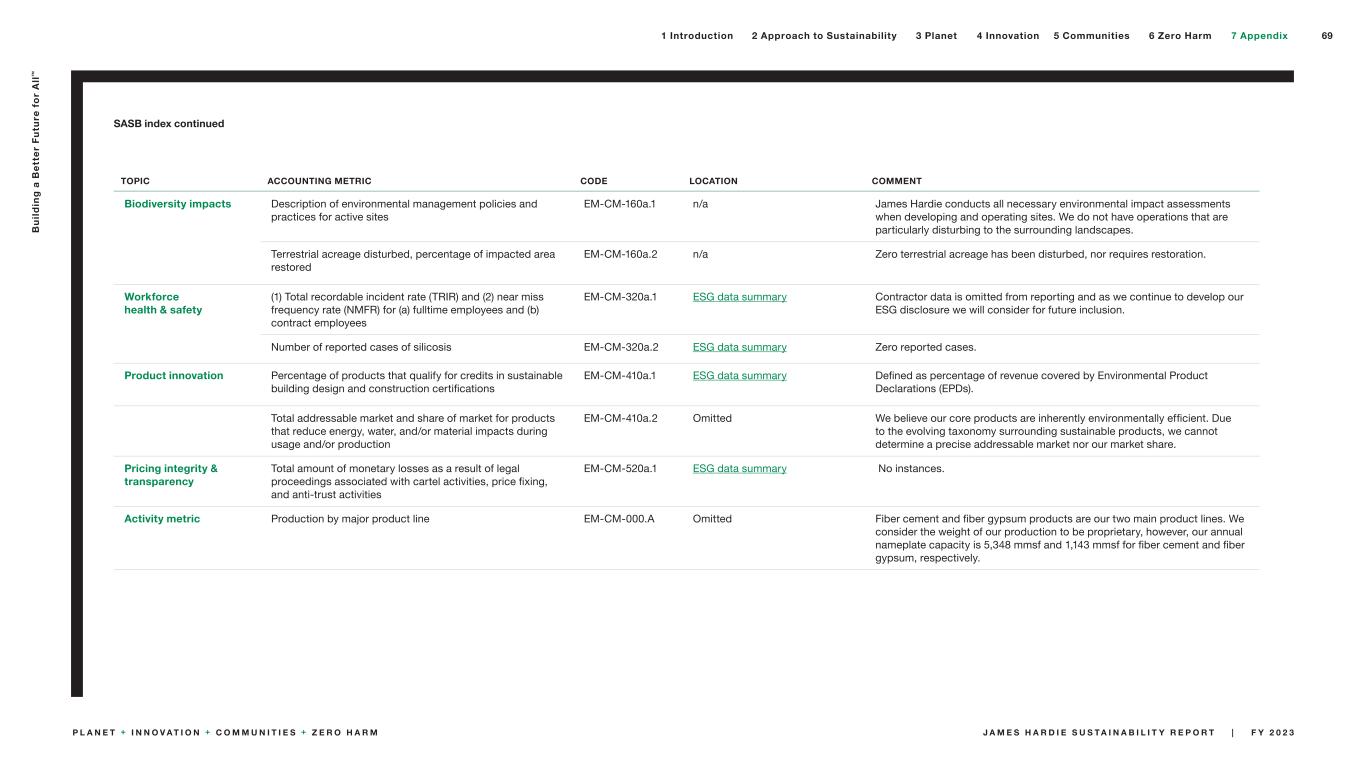
SASB index continued TOPIC ACCOUNTING METRIC CODE LOCATION COMMENT Biodiversity impacts Description of environmental management policies and practices for active sites EM-CM-160a.1 n/a James Hardie conducts all necessary environmental impact assessments when developing and operating sites. We do not have operations that are particularly disturbing to the surrounding landscapes. Terrestrial acreage disturbed, percentage of impacted area restored EM-CM-160a.2 n/a Zero terrestrial acreage has been disturbed, nor requires restoration. Workforce health & safety (1) Total recordable incident rate (TRIR) and (2) near miss frequency rate (NMFR) for (a) fulltime employees and (b) contract employees EM-CM-320a.1 ESG data summary Contractor data is omitted from reporting and as we continue to develop our ESG disclosure we will consider for future inclusion. Number of reported cases of silicosis EM-CM-320a.2 ESG data summary Zero reported cases. Product innovation Percentage of products that qualify for credits in sustainable building design and construction certifications EM-CM-410a.1 ESG data summary Defined as percentage of revenue covered by Environmental Product Declarations (EPDs). Total addressable market and share of market for products that reduce energy, water, and/or material impacts during usage and/or production EM-CM-410a.2 Omitted We believe our core products are inherently environmentally efficient. Due to the evolving taxonomy surrounding sustainable products, we cannot determine a precise addressable market nor our market share. Pricing integrity & transparency Total amount of monetary losses as a result of legal proceedings associated with cartel activities, price fixing, and anti-trust activities EM-CM-520a.1 ESG data summary No instances. Activity metric Production by major product line EM-CM-000.A Omitted Fiber cement and fiber gypsum products are our two main product lines. We consider the weight of our production to be proprietary, however, our annual nameplate capacity is 5,348 mmsf and 1,143 mmsf for fiber cement and fiber gypsum, respectively. 69 B u il d in g a B e tt e r F u tu re f o r A ll ™ J A M E S H A R D I E S U S T A I N A B I L I T Y R E P O R T | F Y 2 0 2 3P L A N E T + I N N O V A T I O N + C O M M U N I T I E S + Z E R O H A R M 2 Approach to Sustainability 3 Planet 4 Innovation1 Introduction 5 Communities 6 Zero Harm 7 Appendix
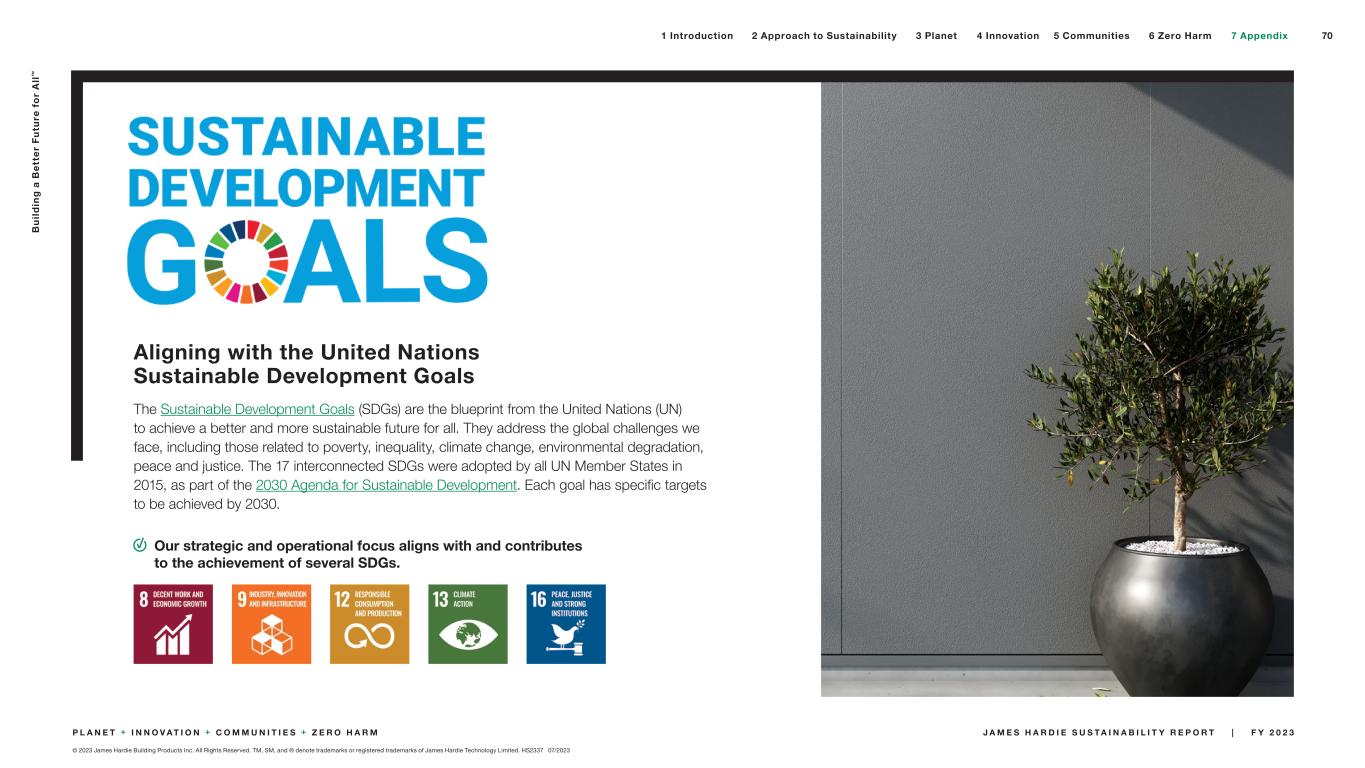
Our strategic and operational focus aligns with and contributes to the achievement of several SDGs. Aligning with the United Nations Sustainable Development Goals The Sustainable Development Goals (SDGs) are the blueprint from the United Nations (UN) to achieve a better and more sustainable future for all. They address the global challenges we face, including those related to poverty, inequality, climate change, environmental degradation, peace and justice. The 17 interconnected SDGs were adopted by all UN Member States in 2015, as part of the 2030 Agenda for Sustainable Development. Each goal has specific targets to be achieved by 2030. © 2023 James Hardie Building Products Inc. All Rights Reserved. TM, SM, and ® denote trademarks or registered trademarks of James Hardie Technology Limited. HS2337 07/2023 70 B u il d in g a B e tt e r F u tu re f o r A ll ™ J A M E S H A R D I E S U S T A I N A B I L I T Y R E P O R T | F Y 2 0 2 3P L A N E T + I N N O V A T I O N + C O M M U N I T I E S + Z E R O H A R M 2 Approach to Sustainability 3 Planet 4 Innovation1 Introduction 5 Communities 6 Zero Harm 7 Appendix